THE LAWRENCE JADE COLLECTION 琳琅御珍:勞倫斯珍藏玉石
TUESDAY 14TH NOVEMBER 2023

THE LAWRENCE JADE COLLECTION 琳琅御珍
TUESDAY 14TH NOVEMBER 2023
10.00AM

TUESDAY 14TH NOVEMBER 2023

TUESDAY 14TH NOVEMBER 2023
10.00AM




Please dial +44 (0)1722 followed by the number listed below
Email: asianart@woolleyandwallis.co.uk
Salisbury Salerooms, 51-61 Castle Street, Salisbury, Wiltshire SP1 3SU
Tel: +44 (0)1722 424500 • www.woolleyandwallis.co.uk



 John Axford MRICS Head of Asian Art
Michelle Yu
Jeremy Morgan Asian Art
Sophie Moore
Freya Yuan-Richards Chinese Paintings & Asian Art
Nelson Chui Photography
Alexandra Aguilar Japanese & Asian Art
John Axford MRICS Head of Asian Art
Michelle Yu
Jeremy Morgan Asian Art
Sophie Moore
Freya Yuan-Richards Chinese Paintings & Asian Art
Nelson Chui Photography
Alexandra Aguilar Japanese & Asian Art
TUESDAY 14TH NOVEMBER 2023
10.00AM
The sale will be conducted at our Castle Street Salerooms, SP1 3SU
VIEWING
Viewing in London (highlights) 17 Clifford Street, 2nd floor W1S 3RQ
Saturday 28th October 11.00am-4.00pm
Sunday 29th October 11.00am-4.00pm
Monday 30th October 11.00am-4.00pm
Viewing at our Old Sarum Galleries Unit 1B Castle Gate Business Park, Old Sarum, Salisbury SP4 6QX
Friday 10th November 10.00am-5.00pm
Saturday 11th November 10.00am-1.00pm
Monday 13th November 10.00am-4.00pm
預展將於 Old Sarum 展廳舉行, 拍賣將於公司總部 Castle Street 舉行。
BUYER'S PREMIUM
See paragraphs 4 & 5 of our conditions of business at the back of the catalogue for additional charges on the final hammer prices.
Telephone Bidding
Requests for telephone bidding may not be accepted after 12 noon on Monday 13th November.
本公司提供免費網上即時競投,請在 11 月 13 日中午 12 點之前 登錄 bid.woolleyandwallis.co.uk 登記競投賬戶。
注:所有網絡買家需要支付至少 £5,000 的保證金。
網上競投總金額的限額為 £50,000。
Online bidders may be required to pay a deposit of £5,000. This deposit will allow the online bidder to bid up to a maximum of £50,000 in total at this auction.
LIVE ONLINE BIDDING – FREE OF CHARGE bid.woolleyandwallis.co.uk
Please register by 12 noon on Monday 13th November.

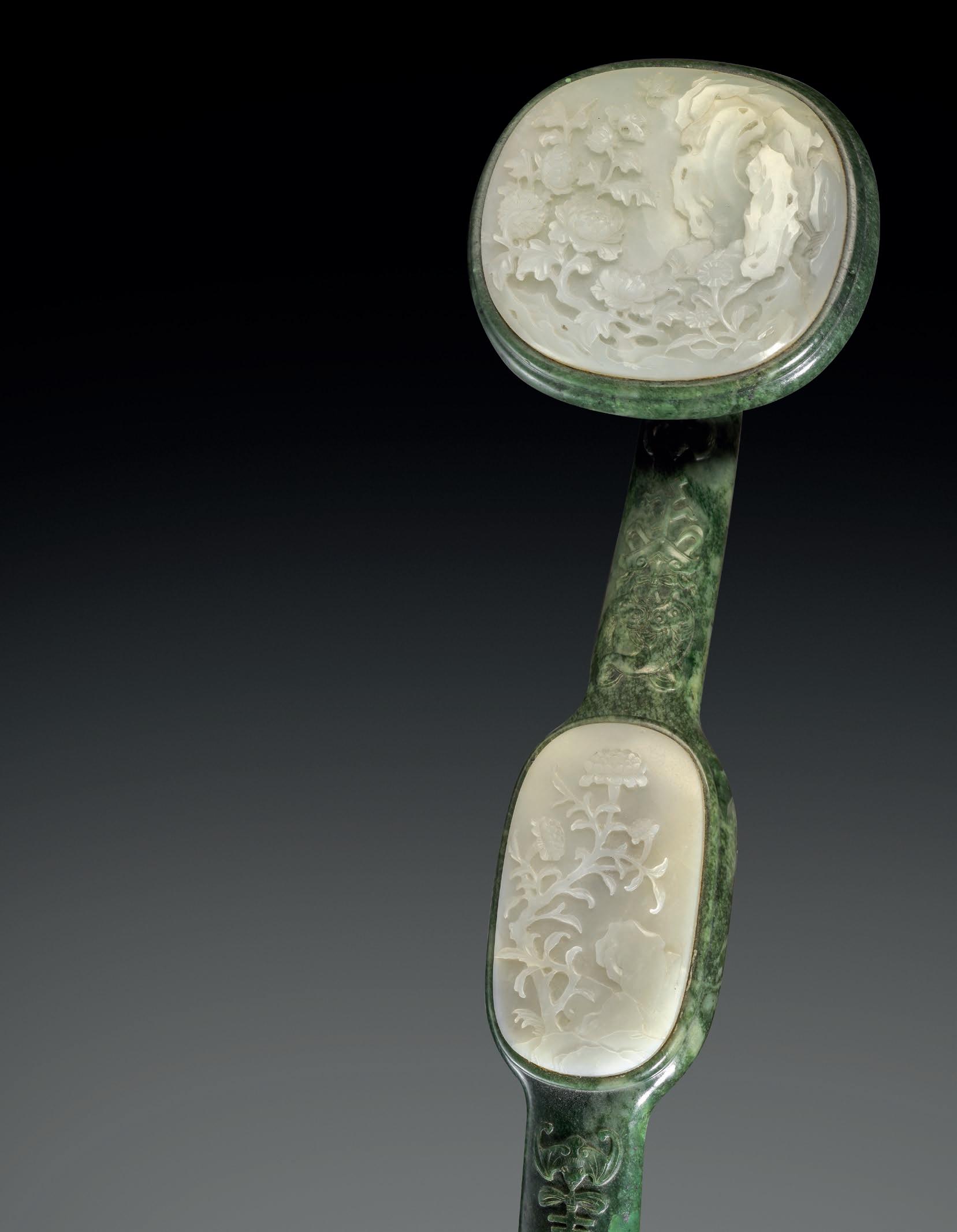
Restricted Bidding
If you wish to bid at this auction you will need to register and provide proof of identity and of your address and provide photographic ID. You may be asked to pay a deposit of £5,000. Any deposit must be paid by debit card or bank transfer. Woolley and Wallis must have cleared funds no later than 12 noon on Monday 13th November. If you are not successful you will be refunded (without interest) within seven working days.
ONLINE BIDDERS MAY BE REQUIRED TO PAY A DEPOSIT OF £5,000. THIS DEPOSIT WILL ALLOW THE ONLINE BIDDER TO BID UP TO A MAXIMUM OF £50,000 IN TOTAL AT THIS AUCTION. 網絡競投需向本公司支付 £5000 押金,網上競投總金額的限額為 £50,000。
特別提示:
競拍者須憑本人護照領取競投號牌,并預交保證金 £5000 請閣下務必妥善保管拍賣號牌,請勿借予他人使用。
若他人使用其號牌競投相應拍品,競買者需承擔全部法律責任。
注:註冊拍賣截止時間為 11 月 13 日中午 12 點整。
Bank Transfers should be sent to:
Lloyds Bank plc, Blue Boar Row, Salisbury SP1 1DB
Account no. 00957707
Sort code 30-97-41
IBAN no. GB20LOYD30974100957707
BIC code LOYDGB21063
Telephone Bidding
Requests for telephone bidding may not be accepted after 12 noon on Monday 13th November.
電話競投
11 月 13
Please note that the condition of lots is not stated in the catalogue descriptions. Reports on condition may be available on request. The absence of condition reports in the catalogue does not imply that the lot is free from imperfections or faults.
品相報告
競買人應於拍賣之前的預展中視察拍品。純為方便買家威立士可以在拍賣開始前提供品相報告,但未記載的 品相報告並不代表其品相完美,如果您有需要請聯繫我們咨訊相關信息。
Collection of lots by appointment only
Please contact the department to arrange collection of lots. 提前預約提取拍品
提取拍品前,請先聯絡亞洲藝術部或客戶服務部預約安排提取拍品。
VAT
Please note that due to the withdrawal of the Retail Export Scheme by HMRC, we are unable to provide VAT refund documentation (C88) for hand-carried exports. In order to qualify for a VAT refund, your lots must be exported by a shipper and valid export documentation must be provided.
注:由於英國稅務海關總署(HMRC)已撤銷零售出口法案(Retail Export Scheme),本公司將無法提供手持出 口增值稅退稅文件(C88)機場退稅單。
若您欲退增值稅,您的拍品必須由貨運公司運送,並且必須由運輸公司提供有效的出口文件。
日星期一中午 12 點以後的電話投標申請可能不會被接受。
In 1891, Henry Walter Neville Lawrence, the younger son of Sir Walter Lawrence and Lilian James, was born in Kashmir, India. As a Captain in the Coldstream Guards, he fought in World War I where he was wounded twice. He later became a banker and member of the London Stock Exchange, marrying Sarah Butler in 1933. He held the position of High Sheriff of Surrey in 1949.
Neville’s lifelong passion for jade was ignited by a piece of jade gifted to him by his wife, resulting in the building of this exceptional collection, primarily sourced through Spink & Son, London. On his death in 1959 he bequeathed the collection to his only child, Murray.
Murray Lawrence was born in 1935. He was educated at Sandroyd School and Winchester College before going up to Trinity College, Oxford. A passionate sportsman, he represented the university at both cricket and golf. After graduating he began his career at Lloyd’s of London as an underwriter at C T Bowring. He was appointed Chairman of Lloyd’s of London in 1988, a position he held for two years. He married Sally O’Dwyer in 1961 and had two daughters. In retirement he became increasingly captivated by the collection, buying and selling particular pieces, thus improving the calibre of the collection even further. Murray Lawrence died in November 2021.


1891 年,沃特.勞倫斯紳士及莉莉安.詹姆士的小兒子內維爾.勞倫斯於克什米爾出生。他曾在第一次世界大戰中 擔任冷溪衛隊隊長,之後成為倫敦證券交易所會員及銀行家。1933 年他與莎拉.巴特勒喜結連理,妻子當時送了 他一件玉雕作為新婚禮物。自此勞倫斯便開始了他畢生的玉石收藏,而他絕大部分的藏品都購於 Spink & Son。
1959 年逝世後,他的珍藏便由他的獨子默里.勞倫斯繼承。
默里.勞倫斯出生於 1935 年,他曾就讀於著名英國貴族院校桑德羅學校、溫徹斯特公學及牛津大學三一學院, 亦曾代表大學板球隊及高爾夫球隊出賽。畢業後默里成為了 C T Bowring 的承保人並展開了他的保險事業。他於 1988-1990 年期間擔任倫敦勞埃德保險社(Lloyd's of London)的主席。他與莎莉.歐德懷爾於 1961 年完婚,育有 兩女。默里在退休後醉心更新他父親的收藏,篩選出售部分藏品,致力擴充稀有的藏品,精益求精。2021 年 11 月 默里去世後,遵照他的遺願,他的女兒委託威立士舉行這場《琳瑯御珍:勞倫斯家族珍藏玉石》拍賣專場。

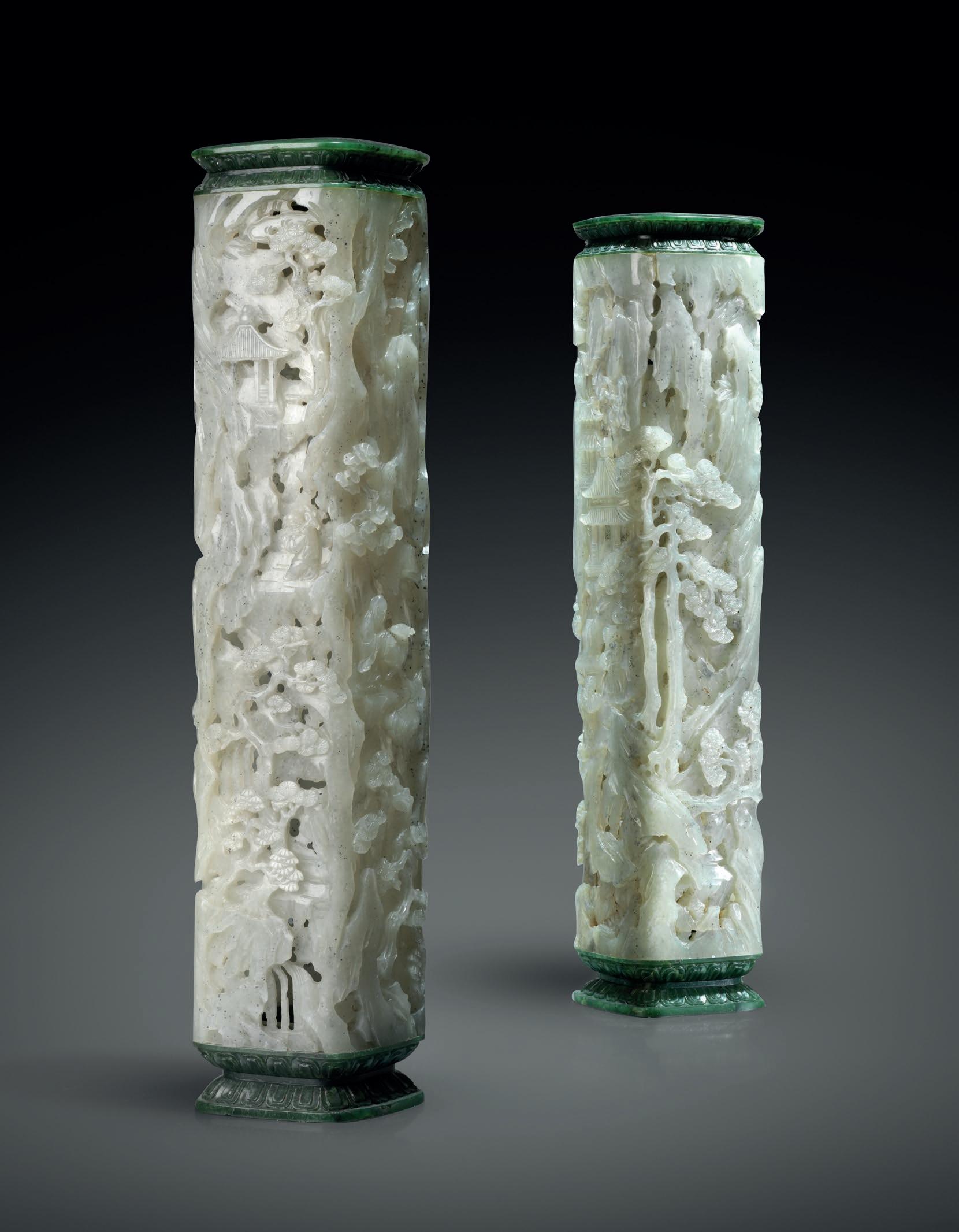
Jade carving is one of the oldest and most important art forms in China, a craft steeped in history and tradition that reflects Chinese philosophy and culture. Carving, called zhuo 琢 and zhuo mo 琢磨 in Chinese, represents the arduous process of shaping and decorating an intractable material with abrasives to create the desired object. Over the course of its long history, Chinese jade carving has experienced five peaks: the late Neolithic period (circa 3500-2050 BC); the late Shang dynasty (1200-1046 BC); the Warring States period (475-221 BC); the Han dynasty (206 BC-AD 220) and the Qing dynasty, especially the second half of the 18th to the early 19th century.
The substance jade is known as yü 玉 in Chinese. The term has semantically broader meanings than jade in English, for it has been used to describe any of the various hard greenish and whitish gems used in jewellery and artistic carvings, including jadeite. It has also been used for several minerals that carve and polish well, such as bowenite and other varieties of serpentine. An example of one of these exquisite stones is the pair of bowenite bowls decorated with gold and with Qianlong reign mark (lot 18). Jadeite is now known as yingyü 硬玉 (hard jade) and nephrite correspondingly as ruanyü 軟玉 (soft jade). The Chinese character yü dates back to eleventh century BC oracle bone script, that depicted pieces of jade hanging on a string.
The most common substance assigned the name jade is the stone nephrite. It is composed of the minerals tremolite and actinolite and occurs mainly in areas near the central Asian cities of Khotan and Yarkand in Xinjiang province. This source of jade was in limited supply to Chinese carvers over the centuries, until in the 18th century the Qianlong Emperor (1736-95) conducted a series of successful military campaigns in Central Asia between 1755 and 1760. The Chinese Empire was thereby enlarged, including the area of present-day Xinjiang with its copious deposits of nephrite. This enabled carvers to work on massive pieces such as the huge jade mountain called Yu the Great Controls the Waters which weighs 5,300kg and is housed in the Forbidden City. Such exquisitely-worked carvings were often accompanied by inscriptions engraved on the back or sides. Inscriptions were also worked into decoration, such as that in the centre of the knop of each jar (lot 18) that says “long life”
To create elaborate pieces several jade carvers had to work together, often taking several years to complete the projects. Archive materials from the Construction Department of the Imperial Household Ministry ( 內務府造辦處 ) show the production of jade objects to have been of very specific importance for the court and even to have developed into a symbol of prosperity and a well-ordered state in the Qianlong era. Imperial pieces were often incised with a reign mark, as does the quatrefoil stand (lot 4) that has a reign mark incised on the interior of the foot.
All varieties of jade stones are wonderful to touch. They are cold and hard, but also feel just slightly oily and extremely pleasant to the fingers. Jade has always been valued in China for its physical properties: its extreme toughness, which makes it very durable; its incorruptible beauty in terms of colour, texture and translucency; and its sensuous tactile qualities when polished. But in addition to its earthly beauty, jade also became associated with spiritual power. In particular, its subtle, translucent colours and protective qualities caused it to become associated with Chinese conceptions of the soul and immortality. Along with gold it was considered as one of the most precious materials, and by the 18th century had developed into a symbol of authority and status.
The emergence of the manual lathe, in which jade was held against a grinding tool being rotated by the other hand or another person, came at a very early time in the Neolithic period (circa 4000 BC). The innovation of the manual rotary tool was the most important factor in the development of Chinese jade carving and it evolved through time. In addition to rotary tools, abrasive sands and powders were an important element in jade carving. In early times abrasive sands were ordinary sands that contained a large amount of quartz particles harder than jade. With the development of jade carving craftsmanship, abrasive sands were gradually refined and natural abrasives such as corundum, quartz, and diamond were added. During the 18th and 19th centuries, precision tools including diamond-tipped drills were employed to perfect elaborate carving, such as the carved openwork and raised reliefs on the pair of incense holders (lot 3) and the delicate relief carving on the white jade bamboo vase (lot 20).
The Qianlong Emperor was himself obsessed with jade and wrote over 800 poems devoted to the subject. The subjects vary from Chinese jade, through ancient jade to old jade, and they considered design, motifs and carving, for example criticising workmanship. In 1976 the National Palace Museum in Taipei published ten volumes of Qianlong ’ s poetry, which makes his interest and dedication to the subject clear. The Emperor ’s personal intervention, plus the readily available supplies of good-quality nephrite and the perfected skills of palace craftsmen, make the mid-Qing period a golden time for jade carving. The collection of jades illustrated in this catalogue is indicative of products from this Golden Era.
Deng Shuping, 乾隆皇帝的智與昧-御製詩中的帝王古玉觀 , The Wisdom and Taste of Emperor Qianlong (National Palace Museum, Taipei, 2019)
S H Hansford, Chinese Jade Carving (Lund Humphries, London, 1950)

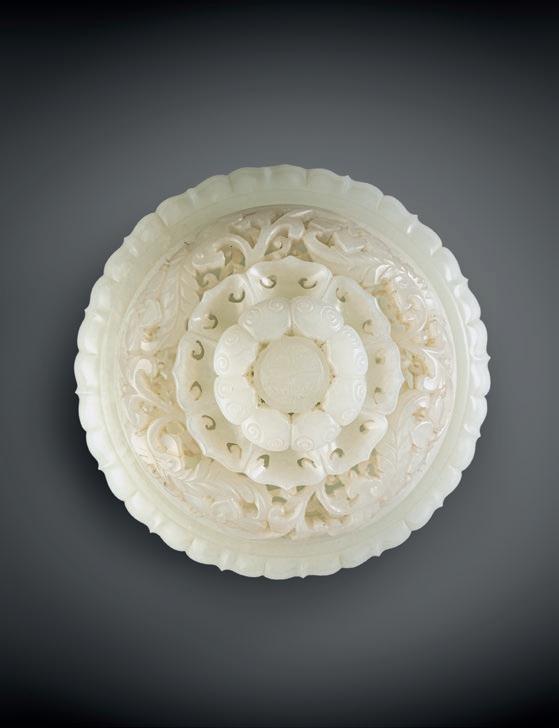
James C S Lin, The Immortal Stone: Chinese Jades from the Neolithic Period to the Twentieth Century (Scala Publishing, London, 2009)
Palace Museum, The Complete Collection of Treasures of the Palace Museum Jadeware 3 (Art Media Resources, Chicago, 1996)
Jessica Rawson, Chinese Jade: From the Neolithic to the Qing (British Museum Press, London, 1995)
Ming Wilson, Chinese Jades (Victoria and Albert Museum Far Eastern Series, London, 2004)
Xu Xiaodong, Compendium of Collections in the Palace Museum Jade, volume 8, Qing Dynasty (Anhui Fine Arts Publishing House, 2011)
Rose Kerr is Honorary Associate of the Needham Research Institute in Cambridge, having retired as Keeper of the Far Eastern Department at the Victoria and Albert Museum. She graduated in Chinese studies from the School of Oriental and African Studies and spent a year as a student in China during the last year of the Cultural Revolution, 1975-6. She has published widely and acts as Honorary Fellow at the University of Glasgow, Chairman of the Great Britain-China Education Trust, Trustee of the Sir Percival David Foundation of Chinese Art and Museum Expert Advisor for Hong Kong. In 2014 she became an Honorary Citizen of Jingdezhen.
ILLUSTRATIONS FROM THE YU ZUO TU BY LI CHENGYUAN, 1891

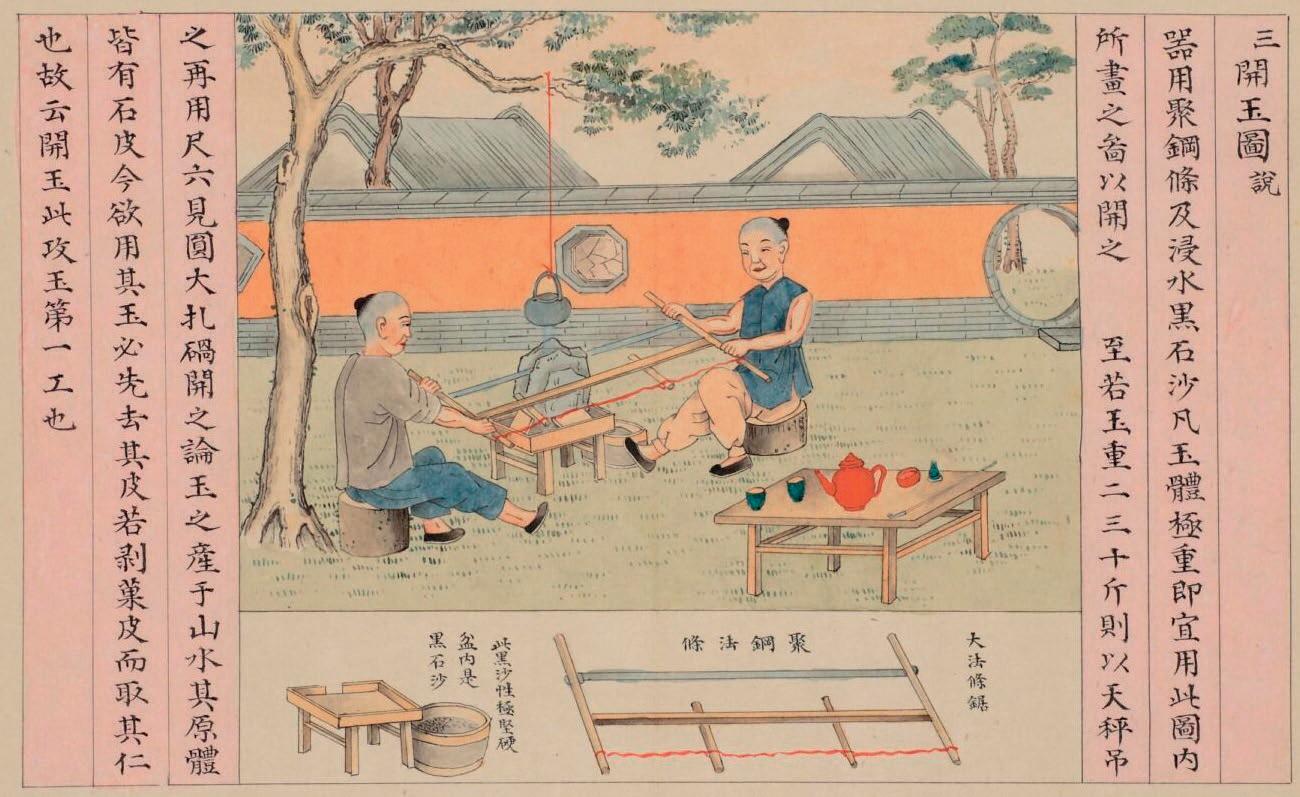 Sawing open the crude jade
Sawing open the crude jade
玉石雕刻是中國最古老的工藝美術之一。不僅承載著歷史和傳統的精湛技藝,亦體現了華夏文明的哲學思想和文化 精粹。雕刻技法中的「琢磨」,代表著將堅硬的礦石反覆雕琢的繁複過程。中國玉器在悠久的歷史中經歷了五個 高峰時期:新石器時代晚期(約公元前 3500-2050 年)、商朝晚期(公元前 1200-1046 年)、戰國時期(公元前 475221 年)、漢朝(公元前 206 年 - 公元 220 年)和滿清時期,特別是十八世紀下半葉至十九世紀初。
漢字上「玉」字的語義比英文的「jade」更為龐雜,因為它被用來泛指各種珠寶及雕刻中使用的各種硬的綠色和 白色石頭,包括翡翠。廣義上,幾種易於雕刻和拋光的礦石, 例如包文石和蛇紋石, 皆歸類為傳統玉材。勞倫斯 珍藏玉石中的可見一例,清乾隆 御製包文石雕描金纏枝花卉紋碗一對 (拍品編號 28)。現今社會中,翡翠歸類於 「硬玉」,而其他硬度稍低的玉石例如和闐玉,則歸類於「軟玉」。「玉」一字可以追溯到公元前十一世紀的甲骨文, 形態呈一串繩結串著的玉石。
軟玉
軟玉或和闐玉是最常被分辨為「玉」的物質。它由透閃石和陽起石組成,主要產於新疆省的和闐和葉爾羗附近等地。 和闐玉的供應一直十分稀少,直到十八世紀乾隆帝(1736-1795 年)在 1755 年至 1760 年期間多次出兵西征中亞, 開疆拓土,將清廷版圖擴大至蘊藏大量和闐玉新疆地區。大量上乘的玉礦資源使清代玉雕工匠有機會製作華麗的 大型玉雕作品。要數到清代最具代表性的大型玉雕,不得不提現藏於紫禁城北京故 博物院,重達 5300 公斤,清乾 隆時期的青玉大禹治水圖山子。這類用料講究,設計巧妙的玉雕作品不時在背面或側面刻有御制詩或銘文。如此次 上拍的一對清乾隆白玉雕如意壽紋花瓣蓋罐的盖鈕(拍品編號 18)則刻有「壽」字銘文。
精巧的玉雕需要幾位資深工匠的雕鑿製成,有時甚至需要歷時數年才能完成。內務府造辦處的遺檔顯示,清代宮廷 珍玩玉器收藏和製造對於十分重視,甚至在乾隆時期成為國家繁榮安定的指標。御製的玉器通常刻有年款,就如 清乾隆 碧玉雕五福捧壽海棠座(拍品編號 4)在底部內側刻有「乾隆年製」款。
物理性質 任何材質的玉石的都有其獨特微妙的質感。堅硬的玉石觸感冰涼透徹,但在指尖上卻帶著一絲滑膩和令人愉悅的 溫潤。中華文化對玉石的物理特性情有獨鍾,其經久耐用的韌性;天然亮麗的色澤紋理和通透度令人賞心悅目; 拋光後則帶細膩溫潤的美妙手感 。集天地靈氣的玉石更被賦予一種寧神定志的力量。含蓄優雅的色澤和趨吉避凶的 功能使其與中國對靈魂和永生的概念相聯繫。玉石與黃金同被視為最為珍貴的工藝材料之一,到了十八世紀,收藏 玉玩發展成為顯赫高貴,位高權重的象徵。
製玉技術
傳統砣機,又稱水櫈,出現於新石器時代早期(約公元前
4000 年),可以將玉石以人力固定,讓工匠借輪軸之力 打磨治玉。砣機的出現促使了中國玉器工藝的蓬勃發展,製玉技術隨時代不斷演變和發展。除了砣機外,琢制玉器 用的解玉砂和研磨工具都是玉雕中的重要元素。早期的解玉砂是含大量比玉料硬的石英礦砂。隨著玉雕工藝水準逐 漸提高,解玉砂越見精煉,並加入其他天然磨料,如剛玉、石英和鑽石。在十八和十九世紀,工匠開始利用鑽石 鑽頭雕琢複雜精巧的紋飾, 清乾隆青灰玉雕香薰 (拍品編號 3),以及清乾隆白玉雕翠竹紋瓶(拍品編號 20), 都展現了當時精美絕倫的浮雕、鏤雕工藝。
帝皇的著迷
清高宗乾隆皇帝對玉石極度熱衷,為玉而作的詩文有八百首之多。御製詩內容涉及玉材、古玉、舊玉、紋飾設計、 玉器鑑賞等,甚至有對雕工技法的批評。1976 年臺北國立故宮博物院出版了乾隆御題詩十冊,其清晰地反映了他 對玉器的見解和喜愛。乾隆皇帝對玉器的愛好及高雅品味,加上穩定進奉朝廷的上等和闐玉料,以及工藝精臻的玉 匠嘔心瀝血的設計及加工,成就了清代宮廷玉器工藝空前絕後的巔峰時代。本圖錄中呈獻的勞倫斯玉石珍藏薈萃了 清代及乾隆盛世時期色美潤澤,卓絕工藝的玉雕佳器。
本文前言作者柯玫瑰女士是英國劍橋大學李約瑟研究所的榮譽研究員,榮休前曾擔任倫敦維多利亞與艾伯特博物館 遠東部門的館長。她畢業於倫敦大學東方和非洲研究學院,主修中國研究,並於文化大革命的最後一年(1975年), 在中國作為交換生深造了一年。不僅廣泛發表學術研究著作,亦兼任格拉斯哥大學的榮譽研究員、英中協會教育信 託基金會主席、大英博物館大維德中國藝術基金會的受託人,以及香港博物館專家顧問。柯女士於 2014 年成為景 德鎮的榮譽市民。
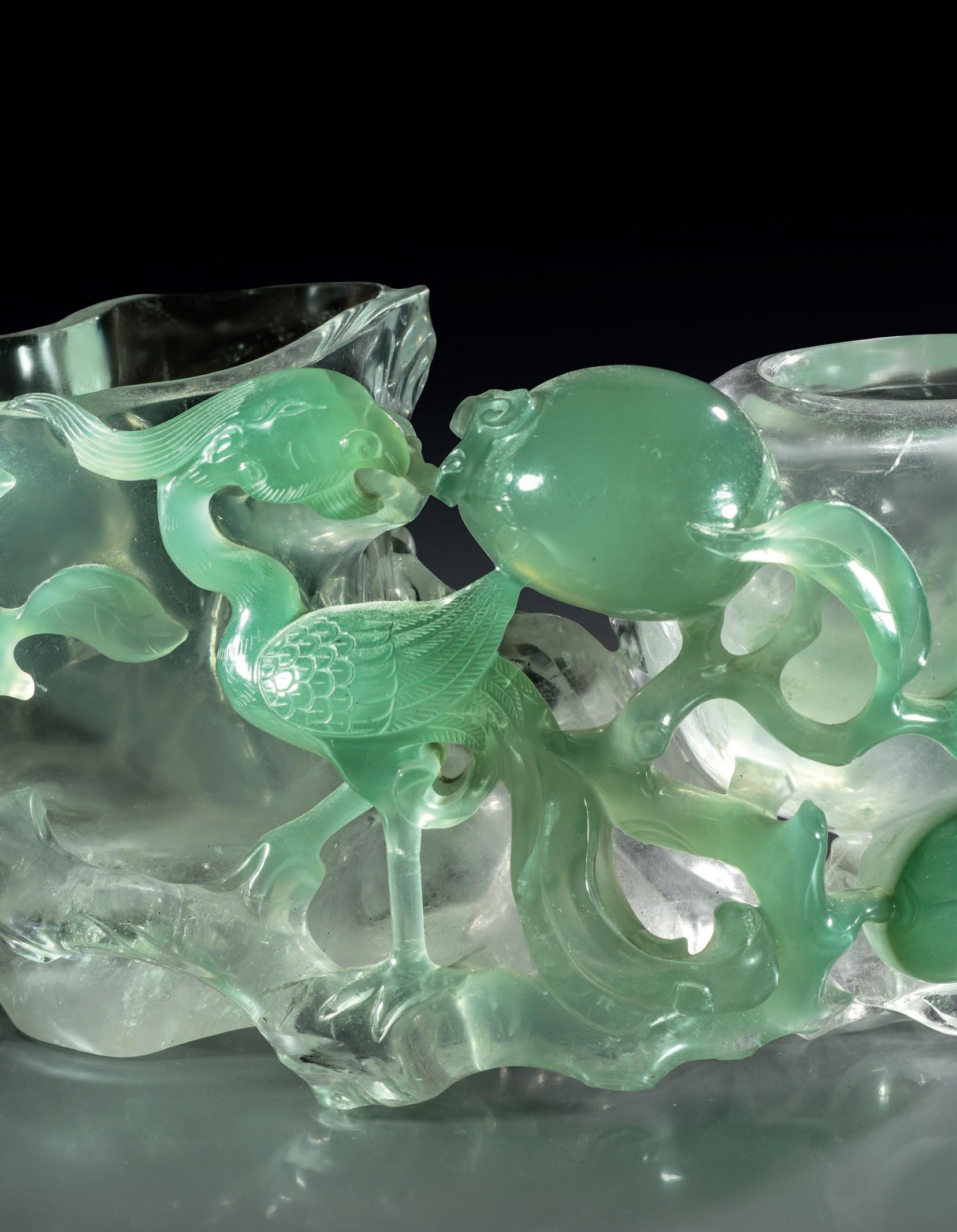
Comprising: a tall tripod incense burner and cover of archaic ding form with butterflies to the neck suspending loose rings and two upright handles formed as leaves, a slender gourd-shaped incense tool vase rising from a short flared foot to an inverted rim, and an oval box with a domed cover, each decorated in relief with stylised floral scrolls and sprays, the deep green stone of each vessel with black specks and dark inclusions, each item raised on an elaborate openwork gilt-bronze base, all supported on a unified wood stand carved and pierced with scrolls and ruyi motifs, 22.9cm max. (6)
Provenance: the Lawrence Collection of jades and hardstone carvings, purchased from Spink & Son prior to 1959.
The incense burner, vase and covered box together form a three-piece incense set, and each item has its own function. The covered box contains incense, usually as powder or in small cakes. The vase holds incense tools such as sticks and spoons, and the large tripod is for burning the incense. The incense burner would be placed in the centre with the vase to its left and the box to its right. One would open the box and then use the sticks to take out the incense and place it into the burner, which would already contain a layer of ash or sand. The incense would then be lit, and the spoon would be used to pull ash around the burning incense, allowing the burning to proceed at a slow pace. After the incense burning, the tools would be put back inside the vase and the incense burner would be covered with its lid. The gourd-shaped vase and round box both have ceramic prototypes, but their decoration shows influences from the Islamic world. The dominant motifs are floral patterns: lotus, poppy, lily, and acanthus leaf, which are also popular on Mughal jades. As in other societies, burning incense is an important part of worship in traditional China. It is performed regularly in front of ancestral tablets and portraits, as well as to Buddhist or Daoist images. In addition to the religious meaning, burning incense also has many health benefits. In the Ming and Qing periods, burning incense became almost a daily activity in royal and scholar-official households. The elaborate design and the very high quality material all suggest that the incense set was likely commissioned by the Imperial palace, possibly the Qianlong Emperor who is known to have admired Mughal jades so much that he ordered his court artisans to copy them.
Cf. The Complete Collection of Treasures of the Palace Museum, Jadeware (III), pp.83-84, no.71 for another Qianlong period altar set in spinach-green jade; see also p.82, no.70 for a related white jade set.
£50,000-80,000

Depicted seated in dhyanasana holding a tablet in his left hand and a brush in his right, he wears long layered robes which fall in folds around his bare left foot, his well-defined face detailed with downcast eyes and wrinkles to his forehead, with finely incised hairs to his long beard and moustache, the deep green stone with brown and dark inclusions, 23.5cm.
Provenance: the Lawrence Collection of jades and hardstone carvings, purchased from Spink & Son prior to 1959.
Several of the Eighteen Luohans are associated with books or Buddhist scriptures, including Nandimitra and Panthaka. The figure depicted here is likely to be Angida, who is often portrayed as a learned old monk who could read scriptures written in Sanskrit. Jade sculptures of this kind have previously been dated to the Ming dynasty, but the style of the representation and carving somehow fits more comfortably with that of the early Qing dynasty.
Cf. Catalogue of the International Exhibition of Chinese Art, 1935-6, no.2860 for a similar figure lent to the exhibition by Mr and Mrs Edward Sonnenschein; see also G Wills, Jade of the East, p.104, nos.63-64 and N Zhou, Ancient Jades in Man, Immortal and Buddha, p.309, nos.360-361 for further related examples; see also Asian Art I, 17th November 2010, lot 337 for a comparable spinach-green jade figure of Buddha of the same size previously sold in these rooms.
£15,000-25,000
來源:勞倫斯珍藏玉石,1958 年前購於 Spink & Son。
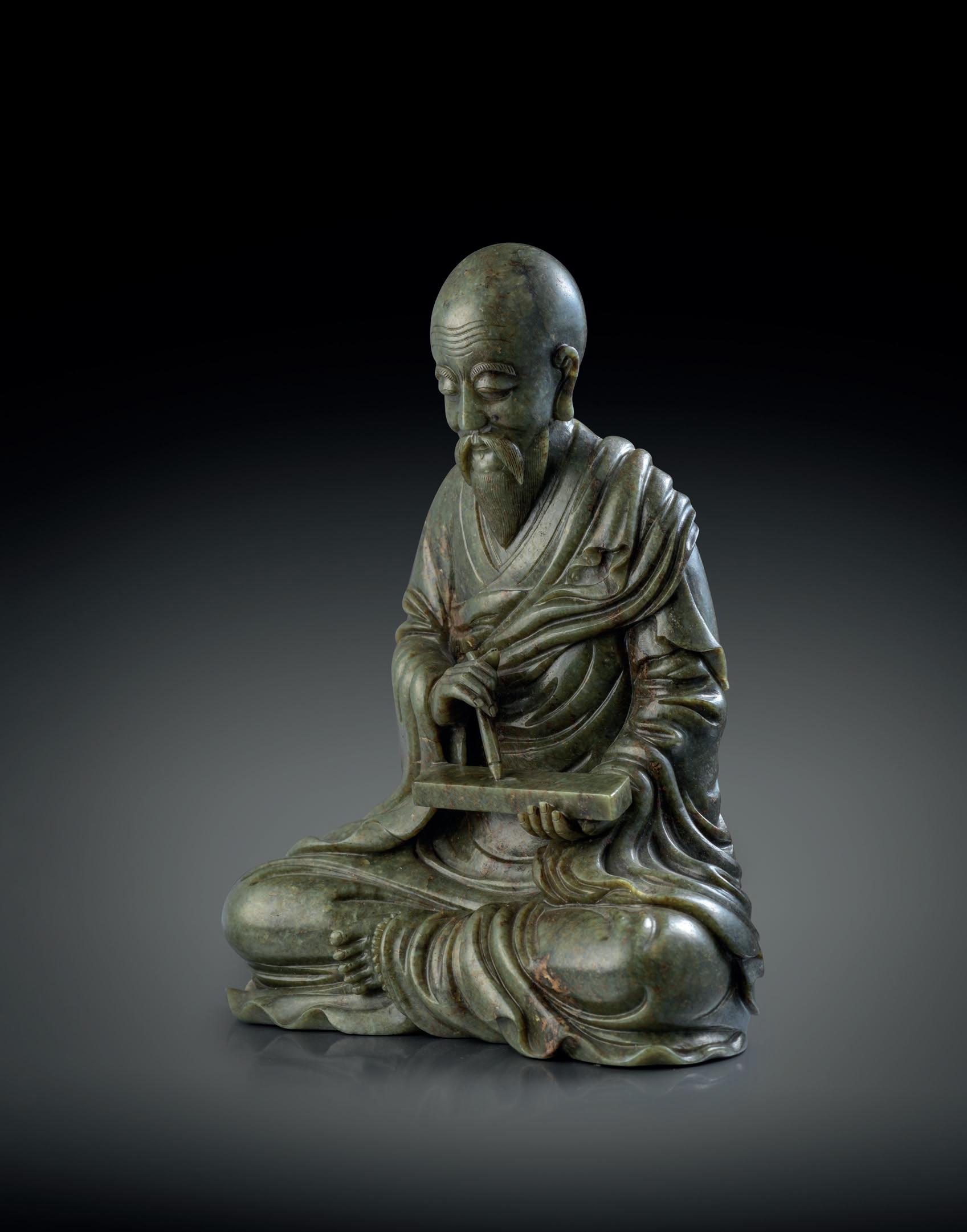
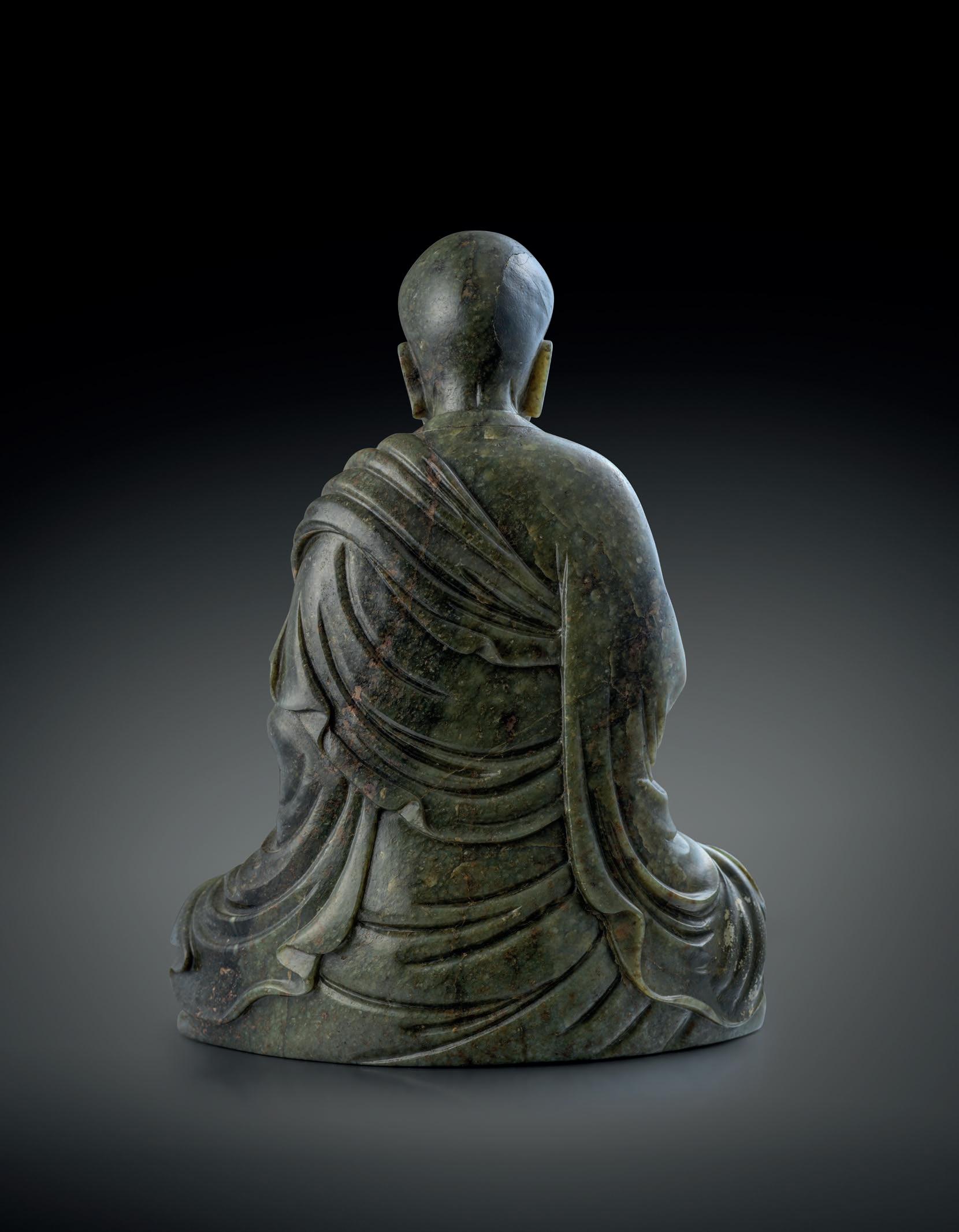
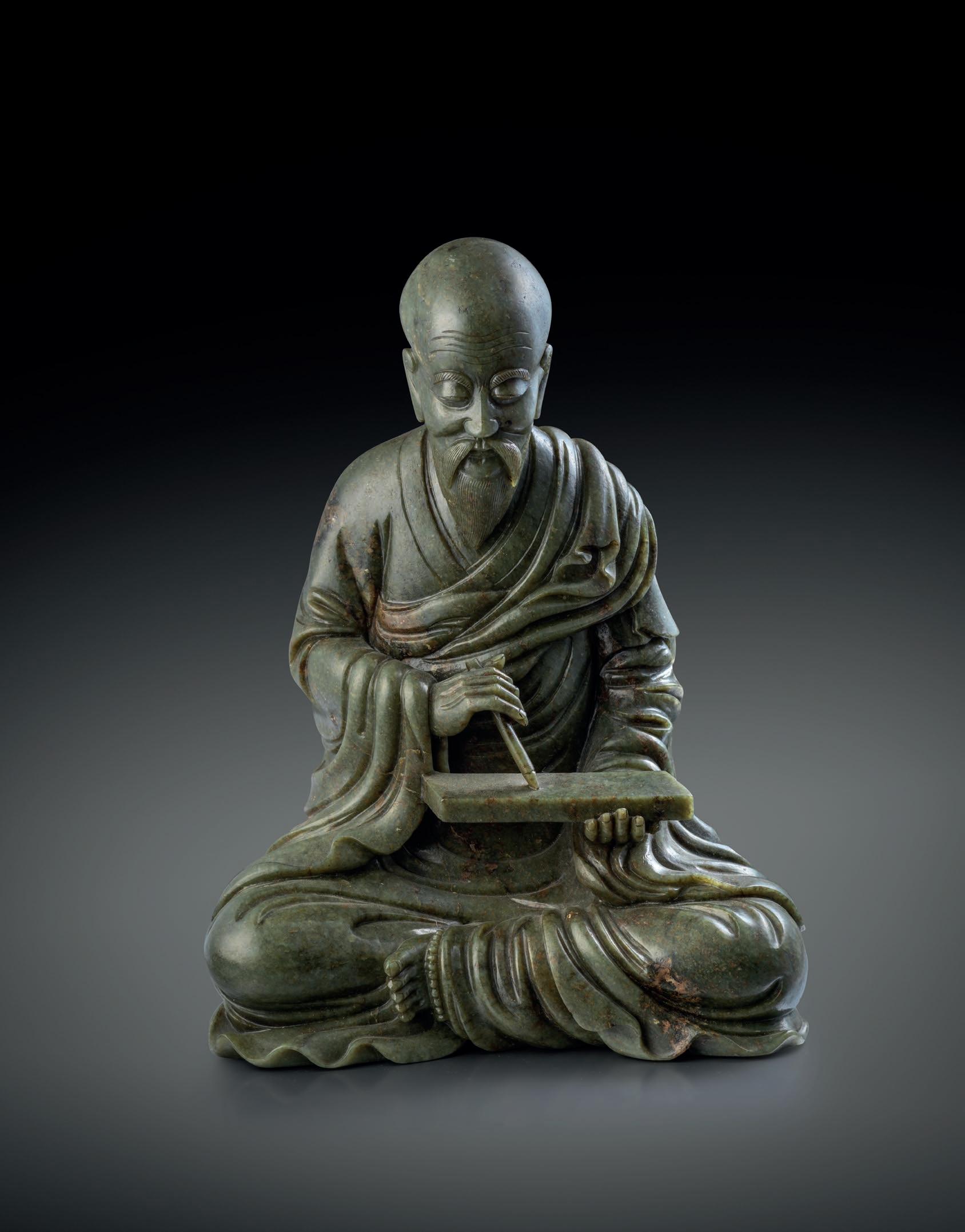
Each with a square-section body, worked in relief and openwork with figures in continuous mountain landscapes, the depicted scenes including two young boys walking along a path, three scholars looking at a painting, an old man and his young attendant beneath a pine tree, and Shoulao accompanied by his deer, with dark speckles dispersed through the pale stone, the waisted spinach-green tops and bases carved with bands of lappets, the ends pierced with flowers surrounded by scrolling foliage, 28.2cm. (2)
Provenance: formerly the collection of Hugh S Whitaker; and then the Lawrence Collection of jades and hardstone carvings, purchased from Spink & Son prior to 1959.
Whitaker was a collector of Oriental art in the early 20th century, and many items from his collection are now in major western museums, including the British Museum and the Victoria & Albert Museum. Whitaker is recorded in the Sparks ledger books between 1914 and 1938 as a buyer.
The incense holder is also known as a perfumier. The incense is placed inside the perfumier and the smoke emerges through the holes while the lighted incense fragrances the room. Perfumiers were popular in the Ming and Qing dynasties, when they were usually made of carved bamboo. They were sought after by the literati class who liked to place them on their desks. Incense holders made of more expensive materials such as jade were usually created for the Imperial Palace.
Such pictorial representations are clearly based on traditional landscape paintings in ink. The subjects express belief in longevity and immortality. In Chinese religion, Immortals are always associated with mountains and hills. The carving is of exceptional quality. One can imagine the incense smoke wafting through the pierced holes, like clouds moving through high mountains, bringing these scenes to life. In the early Qing period, such landscape art was practised by literati artists and was much favoured at the Imperial court, in particular by the Yongzheng and Qianlong Emperors. Here, the jade carver successfully crafted scenes from two-dimensional landscape paintings into his three-dimensional incense burner, creating a masterpiece that can equal any other great works of art.
Cf. Compendium of Collections in the Palace Museum, Jade, vol.8, p.239, no.198, p.242, no.201 and p.243, no.202 for comparable pairs of incense holders in pale celadon jade; see also The Complete Collection of Treasures of the Palace Museum, Jadeware (III), pp.46-49, nos.36-38 for single cylindrical perfumiers with similar decoration; see also R Kleiner, Chinese Jades from the Collection of Alan and Simone Hartman, p.118, no.98 for a related example; see also Asian Art I, 17th November 2010, lot 335 for a comparable incense holder with spinach-green jade fittings previously sold in these rooms.
£40,000-60,000
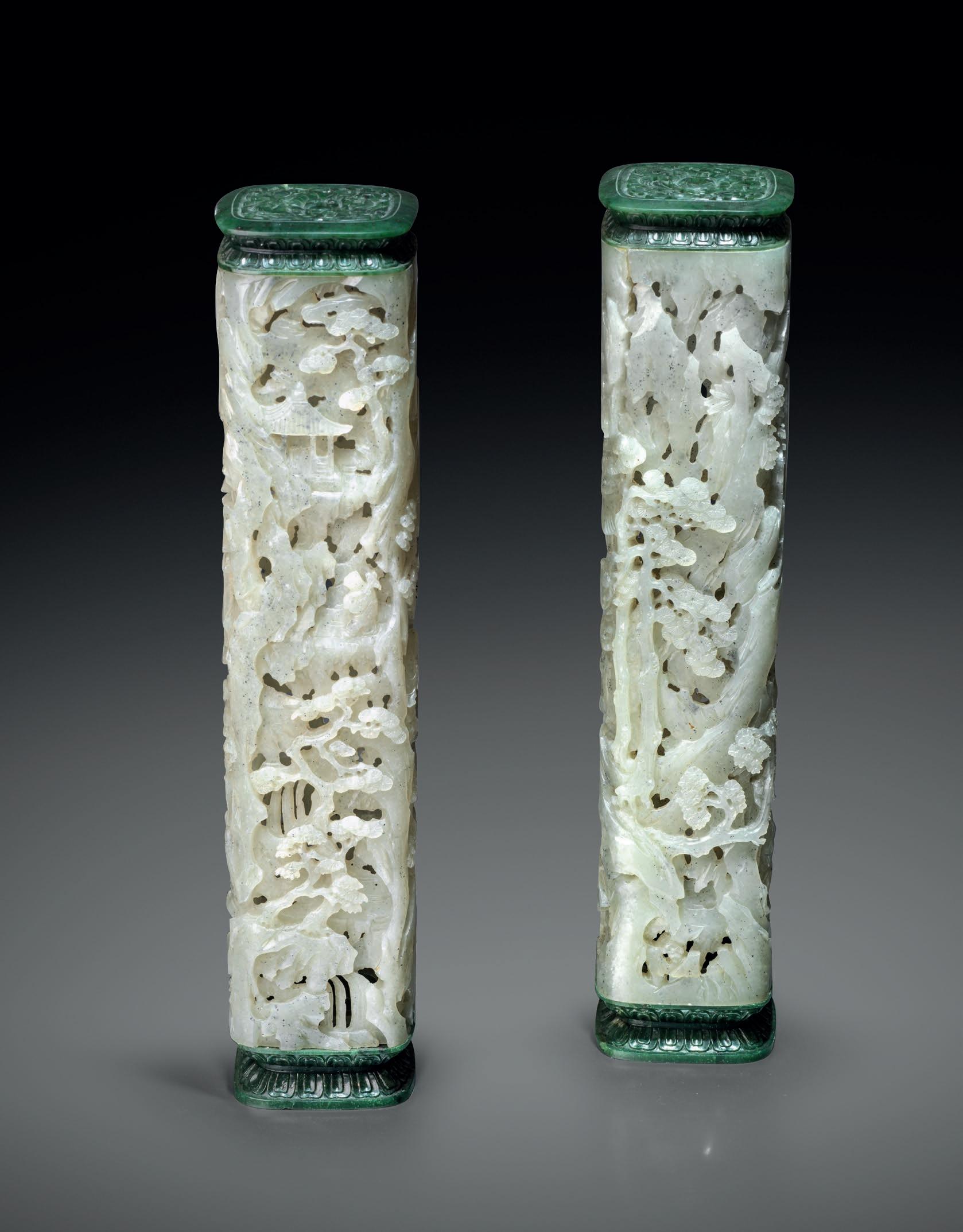
Educated at Eton College and Magdalen College, Oxford, the life of Hugh Sartorius Whitaker had the traditional beginnings of an aristocratic English gentleman. The family fortune was cemented in 1861 when the Ingham's banking empire and the vineyards of Ingham Marsala wine were inherited.

In 1913 he married Helen Bootle-Wilbraham, daughter of the Earl of Lathom, however, they divorced in 1922 and a new chapter of his life began in Italy.
Whitaker lived at Villa Papiniano, Sicily where he housed his extensive collection of Asian art. His principal interest in Oriental doctrines and philosophies led to a lifestyle of meditation, talking to 'heavenly voices' through his spiritual guide and publishing his insights into spiritual teachings.
In 1941 he was classified as an enemy of the Italian state and his remarkable collection of Asian art was confiscated; he was reunited with the collection in 1947. The collection was sold in Florence in 1971 to the acclaim of the antique world.
Hugh Sartorius Whitaker (1885-1971) 曾就讀於伊頓公學和牛津大學莫德林學 院,出身於英國紳士的傳統搖籃。 1861 年,Ingham 的銀行帝國和 Ingham 家族的 Marsala 葡萄酒莊園分掌在眾多繼承人手中,家族財富得到傳承 鞏固。
1913 年,Whitaker 與萊瑟姆伯爵的女兒 Helen Bootle-Wilbraham 結婚。二人 於 1922 年離異,於是他在意大利展開了新生活。
Whitaker 在意大利西西里島的帕皮尼亞諾的故居,擁有龐大的亞洲藝術品 收藏。 他醉心研究東方宗教和哲學思想,將冥想融入生活與「來自天堂的 聲音」交流,亦曾發表對靈性修煉的見解。
1941 年,Whitaker 被列為意大利政府的威脅,他的亞洲藝術珍藏不幸被沒 收,直到 1947 年他和收藏重聚。他為人熟知的藏品其後於 1971 年在佛羅倫 斯釋出古董界市場,成為一時熱話。


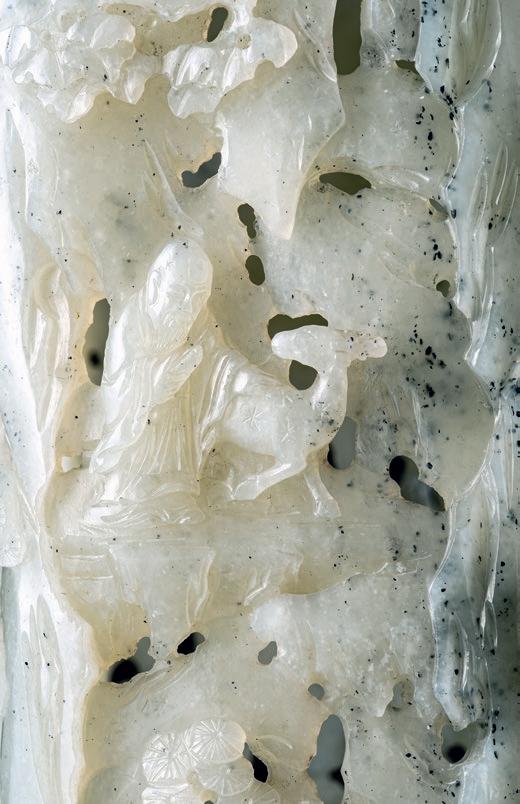
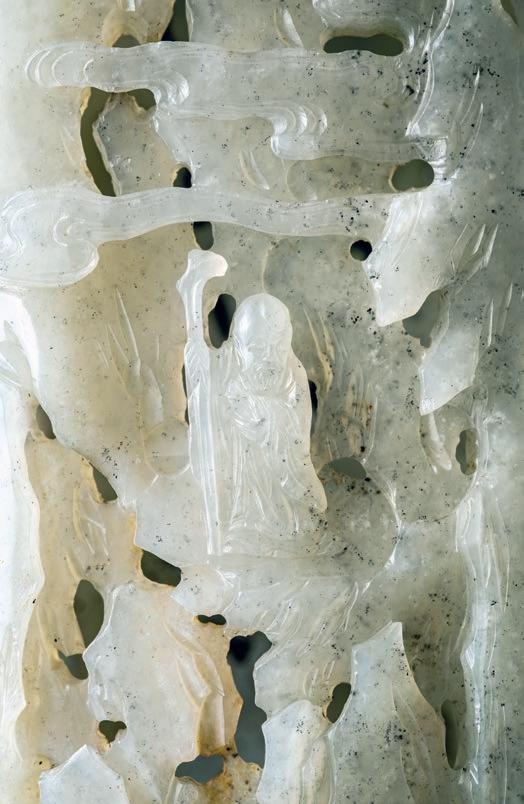
Decorated to the centre with a bat resting upon an openwork shou medallion, the roundel surrounded by four stylised heads of lingzhi, each fungus carved upon a large ruyi-shaped leaf enclosing a small bat, the underside worked with four smaller pointed leaves, all supported on a flared quatrelobed base raised on four ruyi-head shaped feet, incised with the reign mark to the interior of the foot, the green stone with some black specks, 21.6cm.
Provenance: the Lawrence Collection of jades and hardstone carvings, purchased from Spink & Son prior to 1959.
The five bats on this jade stand are symbolic of the Five Blessings of longevity, wealth, health, love of virtue and a peaceful death. The Chinese for ‘five bats’, wufu, is homophonous with that for the ‘Five Blessings’.
£20,000-30,000

來源:勞倫斯珍藏玉石,1958 年前購於 Spink & Son。
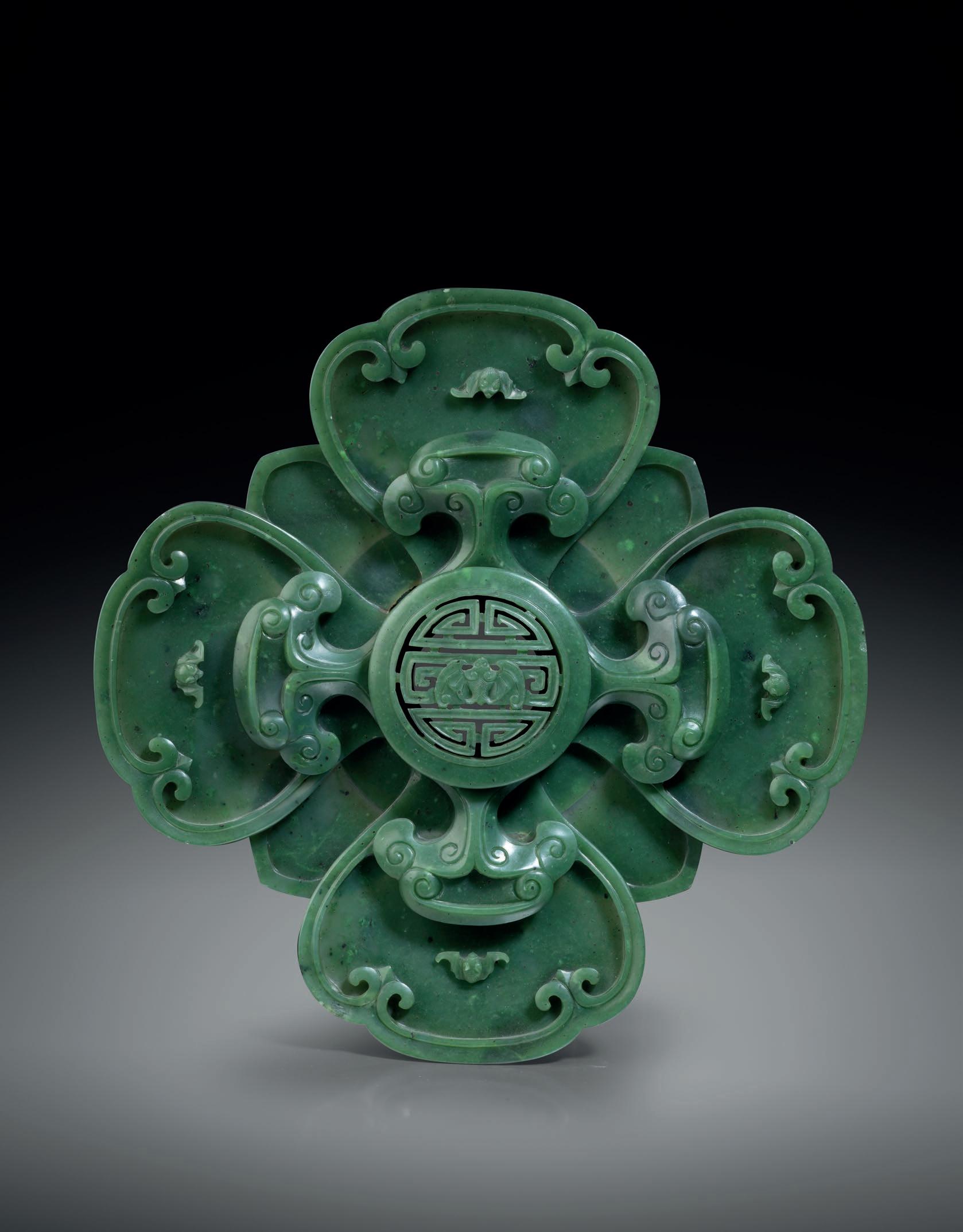


Carved seated in dhyanasana wearing a shawl and long robes, his garments held by a clasp at his left shoulder, he holds a stupa in his left hand whilst raising his right hand behind the precious object in a variation of abhaya mudra, his serene face detailed with a small finely incised moustache and beard, the green stone with brown flecks and inclusions, 23.5cm.
Provenance: the Lawrence Collection of jades and hardstone carvings, purchased from Spink & Son prior to 1959.
In prehistoric times, jade was carved into human form. Such pieces are usually identified as religious worshippers and priests, sometimes as Immortals. The mysterious quality of the jade itself lent a special meaning to the figure it represented. This particular figure is carved from a large boulder of spinach-green nephrite. He has been conventionally identified as a Chinese sage. But his long, flowing robe is closer to the attire of Buddhist monks.
The name Luohan comes from the Sanskrit arhan or arhat, referring to the Buddhist ascetics. They are disciples of Sakyamuni Buddha, who have passed the eight-fold path (right belief, resolve, speech, work, livelihood, training, mindfulness, abstract, meditation), and reached Nirvana or Enlightenment. They are essentially associated with the Hinayana School of Buddhism, and each has the title Samantha prabhasa or general wisdom; they can teach or train others to attain perfection. Luohans are very popular in China, as it is believed they can protect patrons and believers by expelling ignorance and defeating robbers. In the Buddhist legend, there are normally 500 Luohans, but the most famous ones usually appear together in groups of 16 or 18. Luohans are represented in painted portraits as well as in sculpture. All have distinctive attributes: for instance, Pindola the Bharadvaja has elongated eyebrows, Vajraputra is lean, ribbed and hairy; Nakula is always shown with a mongoose. However, it is quite difficult to identify the present figure with a particular Luohan. Many Luohans have a book or staff in their hands, but in this case the figure holds a stupa, perhaps suggesting that he has entered Nirvana.
Cf. Catalogue of the International Exhibition of Chinese Art, 1935-6, no.2860 for a similar figure lent to the exhibition by Mr and Mrs Edward Sonnenschein; see also G Wills, Jade of the East, p.104, nos.63-64 and N Zhou, Ancient Jades in Man, Immortal and Buddha, p.309, nos.360-361 for further related examples; see also Asian Art I, 17th November 2010, lot 337 for a comparable spinach-green jade figure of Buddha of the same size previously sold in these rooms.
£40,000-60,000
來源:勞倫斯珍藏玉石,1958 年前購於 Spink & Son。
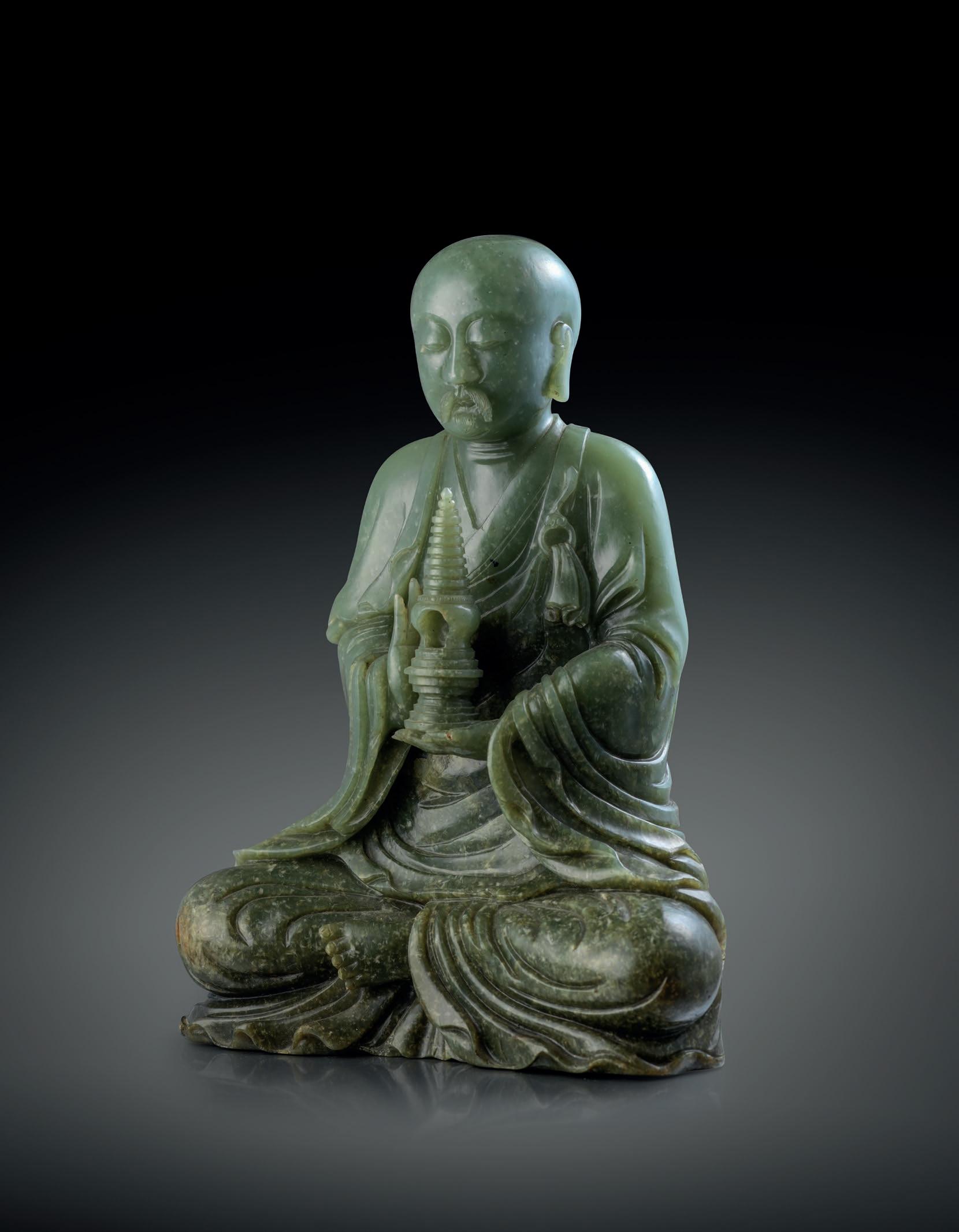
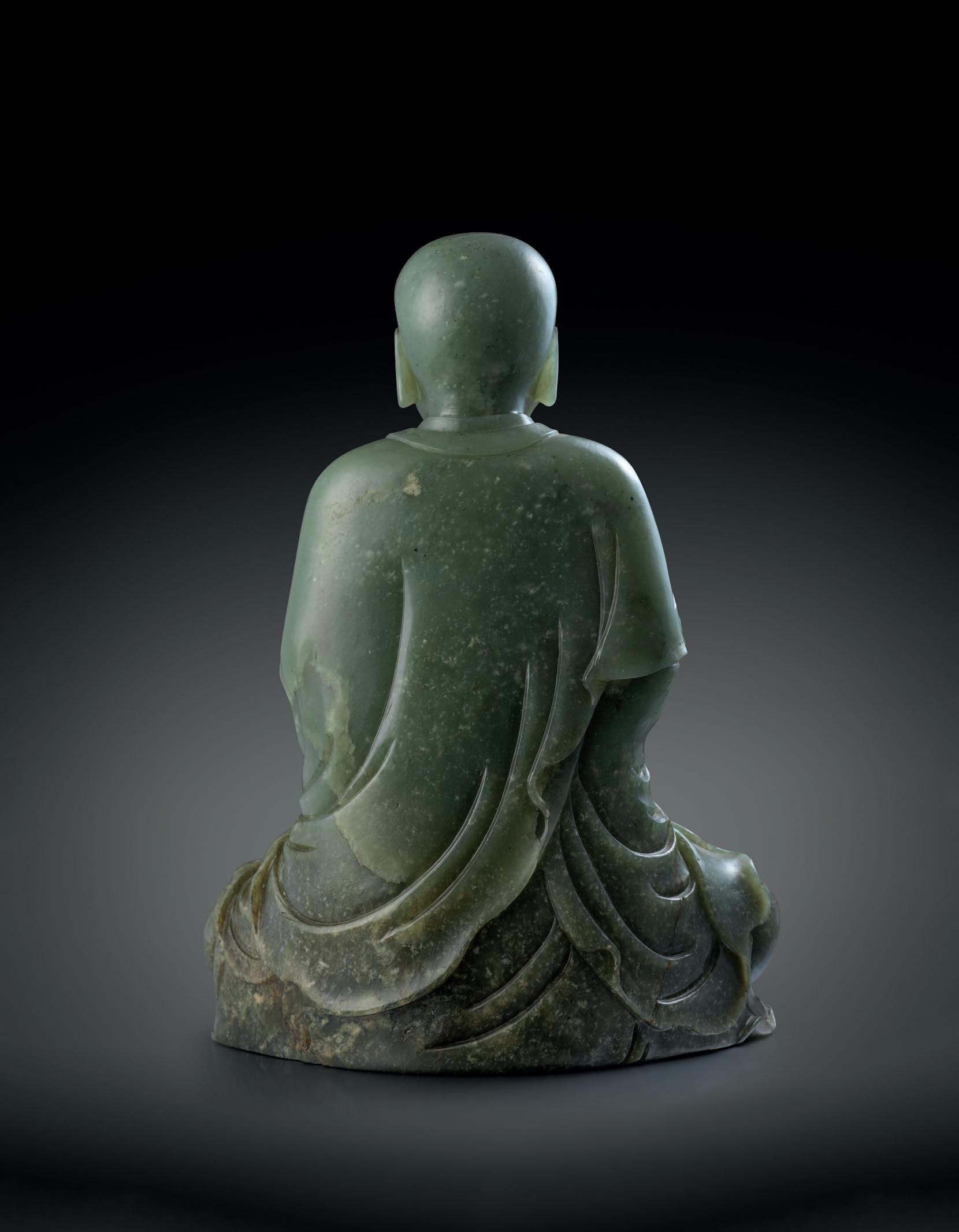

The tall cylindrical bodies carved in pale celadon jade with mountainous landscapes, the continuous scenes depicting figures engaged in various activities, including travellers on horseback crossing bridges and woodcutters returning from the forest, with thatched pavilions and temples dispersed through the rocky setting, with far-off peaks emerging from swirls of mist in the distance, the rims applied with spinach-green jade, each together with a spinach-green jade stand carved with five feet shaped as ruyi-heads, the stands pierced with floral medallions, 14cm. (4)
Provenance: formerly the collection of Hugh S Whitaker; and then the Lawrence Collection of jades and hardstone carvings, purchased from Spink & Son prior to 1959.
Whitaker was a collector of Oriental art in the early 20th century, and many items from his collection are now in major Western museums, including the British Museum and the Victoria & Albert Museum. Whitaker is recorded in the Sparks ledger books between 1914 and 1938 as a buyer.
Cf. T T Bartholomew & H Li, The Tata Collection of Chinese Antiquities in the Chhatrapati Shivaji Maharaj Vastu Sangrahalaya (formerly the Prince of Wales Museum of Western India), p.86, no.57 for a similar single spinach-green example.
£50,000-80,000
Hugh S Whitaker 舊藏,勞倫斯珍藏玉石,1958 年前購於 Spink & Son

The bell-shaped bases carved in low relief with overlapping pendent leaves enclosing geometric scrolls, the tall stems worked with bands of lappets and prunus blossoms reserved on leiwen to the raised bulbous sections, each rising to a central broad drip pan and surmounted by a smaller drip pan set with a metal pin, the flared trays decorated with ruyi motifs, carved with six notched flanges to each principal section, the rims incised with borders of key fret, with black specks dispersed throughout the dark green stone, 32.3cm. (2)
Provenance: the Lawrence Collection of jades and hardstone carvings, purchased from Spink & Son prior to 1959.
Candlestick prototypes can be found in China as early as the Han dynasty, usually in ceramic, bronze and lacquer. Jade candlesticks became especially popular during the Qing dynasty, when they were used together with jade incense burners and vases to perform ceremonies at altars.
The design and decoration of these pieces show an interesting use of traditional elements, but with several innovations. For instance, in addition to the cicada blades, the rims of the pans and base are incised with fine angular spirals, leiwen. While these motifs appeared as early as on the ritual bronze vessels of the Shang and Zhou periods, the lotus and prunus are clearly much later being more common features of Ming and Qing decorative art. In traditional Chinese symbolism the lotus is a sacred flower held in high esteem by both Buddhists and Daoists; it symbolises purity, perfection, summer and fruitfulness. The seat of the Buddha is usually decorated with lotus. The Daoist Immortals also carry a lotus-stem in their hands. Prunus is also well known for its symbolism of seasonality (Winter) and the implication of purity and friendship. By employing these ornamental motifs, the Qing Emperors expressed their desire to be the heirs of ancient Chinese tradition and at the same time, that the objects had to be understood by later generations.
Cf. Compendium of Collections in the Palace Museum, Jade, vol.8, p.261, no.224 for a comparable single candlestick; see also pp.262-264, nos.225 and 227 for related pairs of candlesticks in spinach-green jade; see also G Wills, Jade of the East, p.132, no.124 for another similar pair.
£10,000-20,000
1958 年前購於 Spink & Son。

The God of Longevity stands dressed in loose layered robes, he holds a large openwork flowering prunus branch over his right shoulder and stems of lingzhi in his left hand, the deity typically depicted with a high cranium and a long incised beard, his finely detailed face bearing a cheerful expression, with a crane perched on one leg standing at his feet, the pale stone with russet markings, 12.1cm.
Provenance: the Lawrence Collection of jades and hardstone carvings, purchased from the Oriental Art Gallery Ltd., 1994.
Published: the Oriental Art Gallery Exhibition Catalogue, 7th June 1994, no.42.
The attributes identify the old man as Shoulao, the God of Longevity. Shoulao the Immortal was originally a Daoist deity. The legend is probably based on an actual person who lived during the Song dynasty, but also came to be considered as the personification of the southern polar star. In folk religion, Shoulao is a very popular God of good luck and longevity. In pictorial art, he is represented as an old man with a wide forehead, holding a lingzhi fungus in his hand, and accompanied by a crane, sometimes a black deer or a tortoise.
£10,000-20,000

The crouching child holds a large leafy branch of fruiting peaches in both hands, his finely detailed face bearing a joyful expression, with his incised hair tied up in two buns, depicted wearing bracelets and a loose robe, the pale stone of a fine white tone, with a russet area to one of the peaches, together with a wood stand, 6.9cm. (2)
Provenance: the Lawrence Collection of jades and hardstone carvings, purchased from Roger Keverne Limited on 15th June 2010. A copy of the invoice is available.
Published: R Keverne, Summer Exhibition 2010, pp.116-117, no.90.
Children are one of the most popular subjects in Chinese art, and they are often portrayed holding plants. Representations of young boys holding leafy branches appeared in jade carvings as early as the Song dynasty and, whilst the subject matter varies, they are often depicted with branches of lotus rather than peaches. As peaches are believed to be the food of the Immortals, and thus a symbol of longevity, this may suggest that the present figure was intended as a birthday gift.
Cf. R Kleiner, Chinese Jades from The Collection of Alan and Simone Hartman, pp.230-231, no.181 for a comparable jade; see also J Rawson, Chinese Jade from the Neolithic to the Qing, no.27:3 for another similar example; see also Symposium on Chinese Jades from Sui and Tang to Qing Dynasties, p.205, figs.31 and 32 for related items in the collection of the Shanghai Museum; see also G Xue, Zhongguo Yuqi Shangjian, p.215, no.408 for another comparable piece; see also G Zhang, Mingdai Yuqi, p.189, fig.129 for a related carving dated as Ming in the collection of the Palace Museum, Beijing.
£6,000-8,000
來源:勞倫斯珍藏玉石,1958 年前購於 Spink & Son。
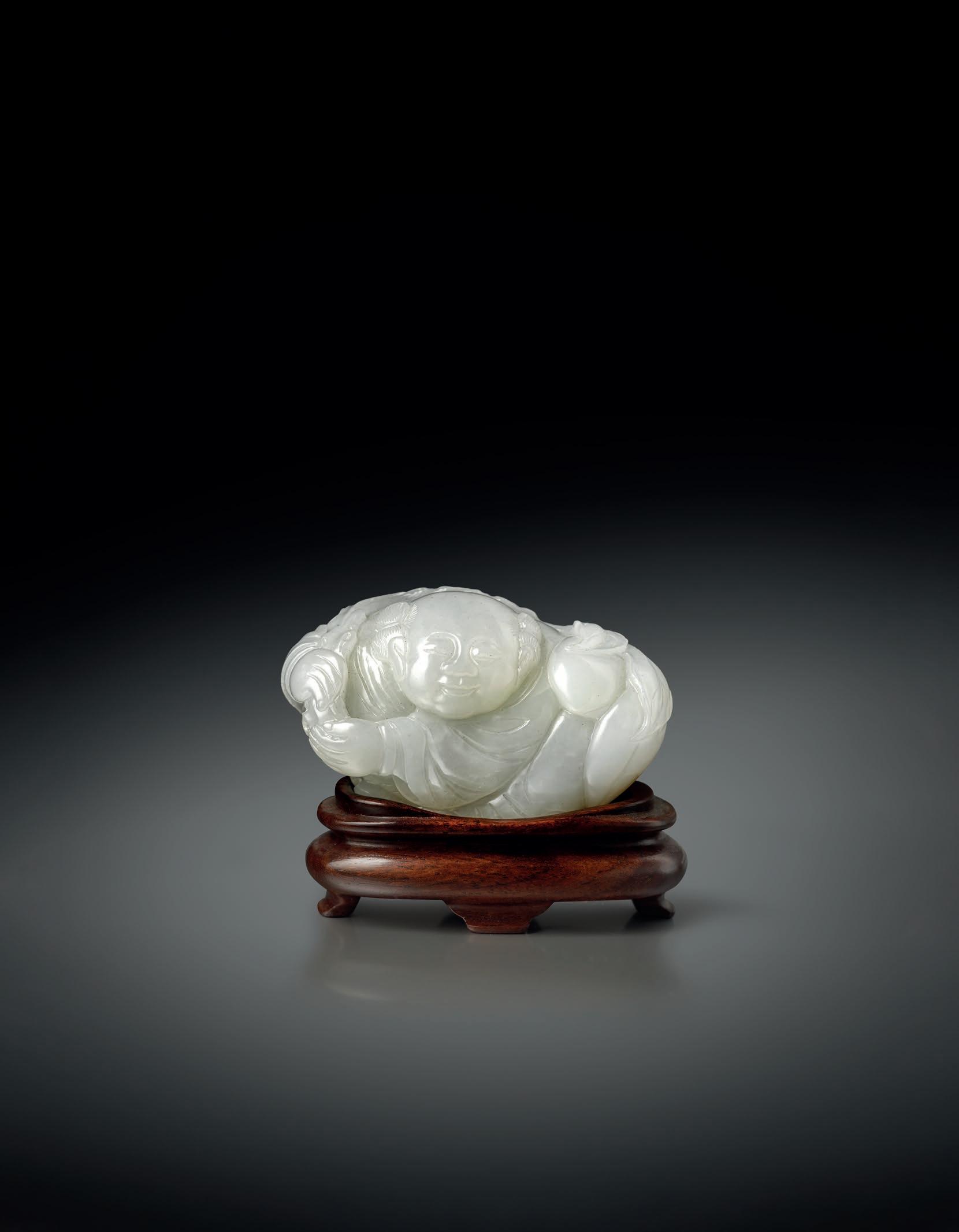
Formed as a section of the trunk of a hollowed pine tree, finely detailed with knots and scales to the wood, the exterior pierced and carved in high relief with gnarled branches of pine, prunus and bamboo, the base incised with tree rings, with speckles and natural pale areas in the dark stone, 15.9cm.
Provenance: formerly the collection of Hugh S Whitaker; and then the Lawrence Collection of jades and hardstone carvings, purchased from Spink & Son prior to 1959.
Whitaker was a collector of Oriental art in the early 20th century, and many items from his collection are now in major western museums, including the British Museum and the Victoria & Albert Museum. Whitaker is recorded in the Sparks ledger books between 1914 and 1938 as a buyer.
Cf. Compendium of Collections in the Palace Museum, Jade, vol.8, p.227, no.186 for a comparable black and pale celadon jade vase carved with a phoenix amidst bamboo and lingzhi.
Pine, prunus and bamboo together are collectively called the ‘Three Friends of Winter’, or Suihan sanyou. As these three plants are particularly durable in winter, they have long been admired for their natural ability to withstand and even thrive in adversity. Objects bearing these motifs are often made for someone considered to be a valued friend. The origin of this notion is found in literature as early as the Song dynasty. Pine, bamboo and prunus were the favourite plants for any scholar’s residence. In Chinese thought, the pine is always green and upright, symbolising a gentleman who stands for his principles. As for bamboo, whilst it may not be as imposing or as sturdy as the pine, it too remains mostly green through the winter. Moreover, the stalk of the bamboo is hollow, and has come to symbolise tolerance and open-mindedness. The flexibility and strength of bamboo also represents cultivation and integrity in which one may yield but not break. Prunus is renowned for its gnarled hardiness during winter that bursts into fragile blossom at the first breath of spring. The fragrance of the prunus also serves as a reminder of a person’s inner beauty.
£5,000-8,000

Depicting a lone scholar gazing up towards a steep cliff face, the elderly gentleman contentedly enjoying the scenery, with pine trees and smaller shrubs growing in the rocky landscape, the reverse carved with a waterfall crashing down the cliff, the russet markings in the greenish stone cleverly used within the design, 12.7cm.
Provenance: formerly a western private collection; and then the Lawrence Collection of jades and hardstone carvings, purchased from Roger Keverne Limited on 18th December 2008. A copy of the invoice is available.
Published: R Keverne, Winter Exhibition 2008, pp.96-97, no.76.
The subject on this carving is inspired by traditional Chinese landscape painting. The Chinese word for ‘landscape painting’ is shanshui, literally translating as ‘mountains and water’. Landscape painting has long held an important position in Chinese art, but its principles were not applied to three-dimensional jade carvings until the early Qing dynasty. Landscape painting was not only valued as a means of expressing an admiration of nature, but also as a way of representing the philosophical relationship between man and the natural world. As is typical in landscape painting, the figure on this jade boulder is presented as a passive spectator within the free and undomesticated vastness of the natural setting.
Cf. L Chang, The Refined Taste of the Emperor: Special Exhibition of Archaic and Pictorial Jades of the Ch’ing Court, pp.158-159, no.48 for a similar example in the collection of the National Palace Museum; see also Schätze Chinas aus Museen der DDR, pp.242-243, no.138 and Tianjin Shi Yishu Bowuguan Cang Yu, no.226 for further comparable pieces; see also R Keverne, Jade, p.352, fig.3 for another related item.
£5,000-8,000
2008 年 12 月 18 日購於 Roger Keverne 古董店(附發票複印件)。
出版:R Keverne, Winter Exhibition 2008,頁 96-97,編號 76。
來源:西方私人舊藏,勞倫斯珍藏玉石,
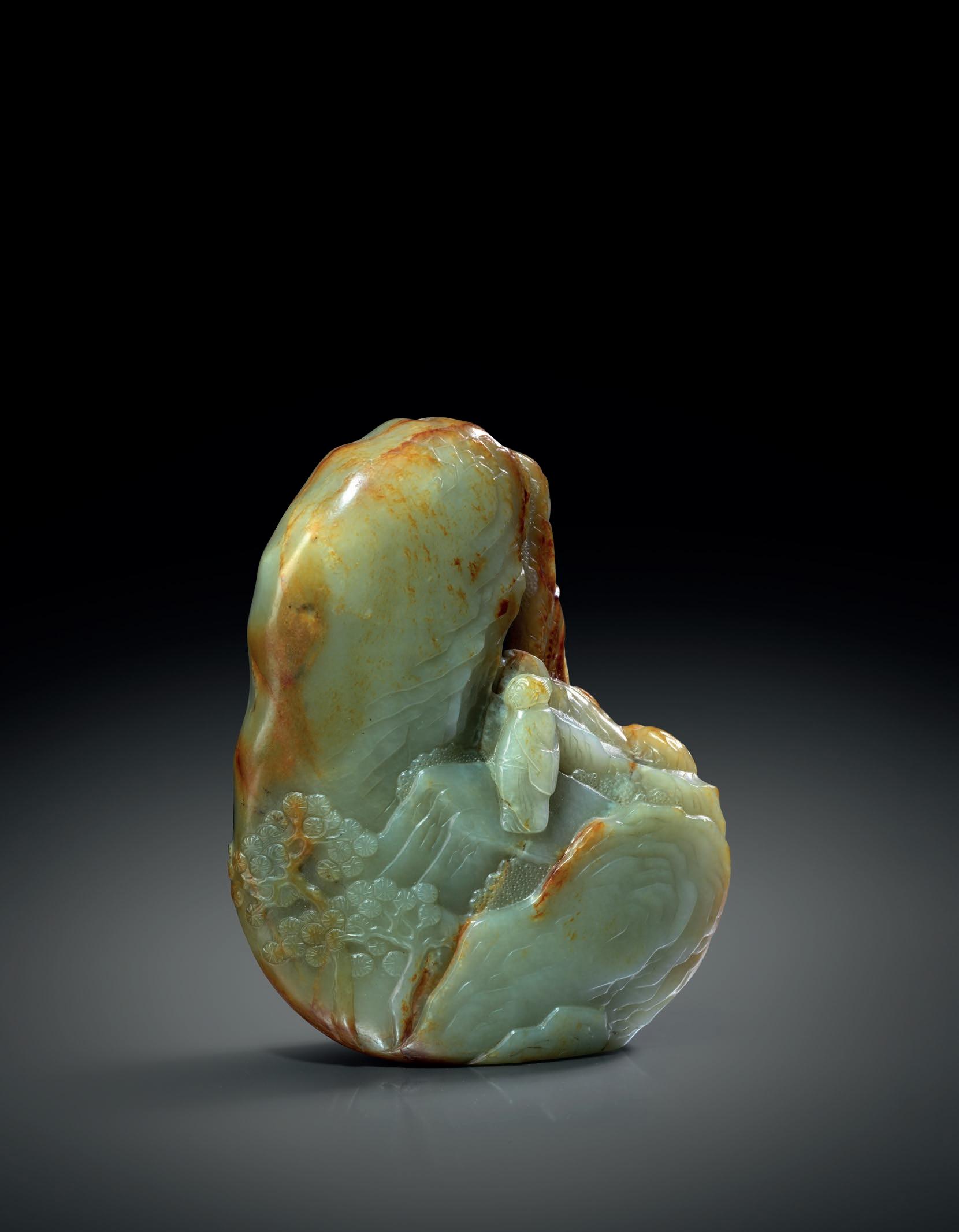
Depicted in a recumbent pose with its legs neatly tucked under its body, the horse turns its head back towards its tail which is flicked up over its haunches, its body rendered with details of its ribs and muscles, with finely incised hairs to its forelock, mane and tail, the mottled stone with inclusions, varying in tone from a pale greenish-grey to a dark brown, 7.8cm.
Provenance: the Lawrence Collection of jades and hardstone carvings, purchased from Spink & Son prior to 1959.
Jade animal carvings have a long history in China. They are thought to have first appeared in prehistoric times when they were probably used for religious or ritual purposes. By the Tang dynasty, miniature jade animals were used as decorative objects and playthings, and they remained popular throughout the following dynasties. Of the twelve Chinese zodiac animals, the horse represents wealth and prosperity. This jade horse was probably made as a ‘handling piece’, but could also have been used as a paper weight. The mottled nephrite with dark brown inclusions gives this miniature sculpture an archaic feel. This aligns with tastes of the Song, Yuan and Ming dynasties when the archaic style was highly prized by the literati class and many jades were worked to simulate those of antiquity.
£8,000-12,000
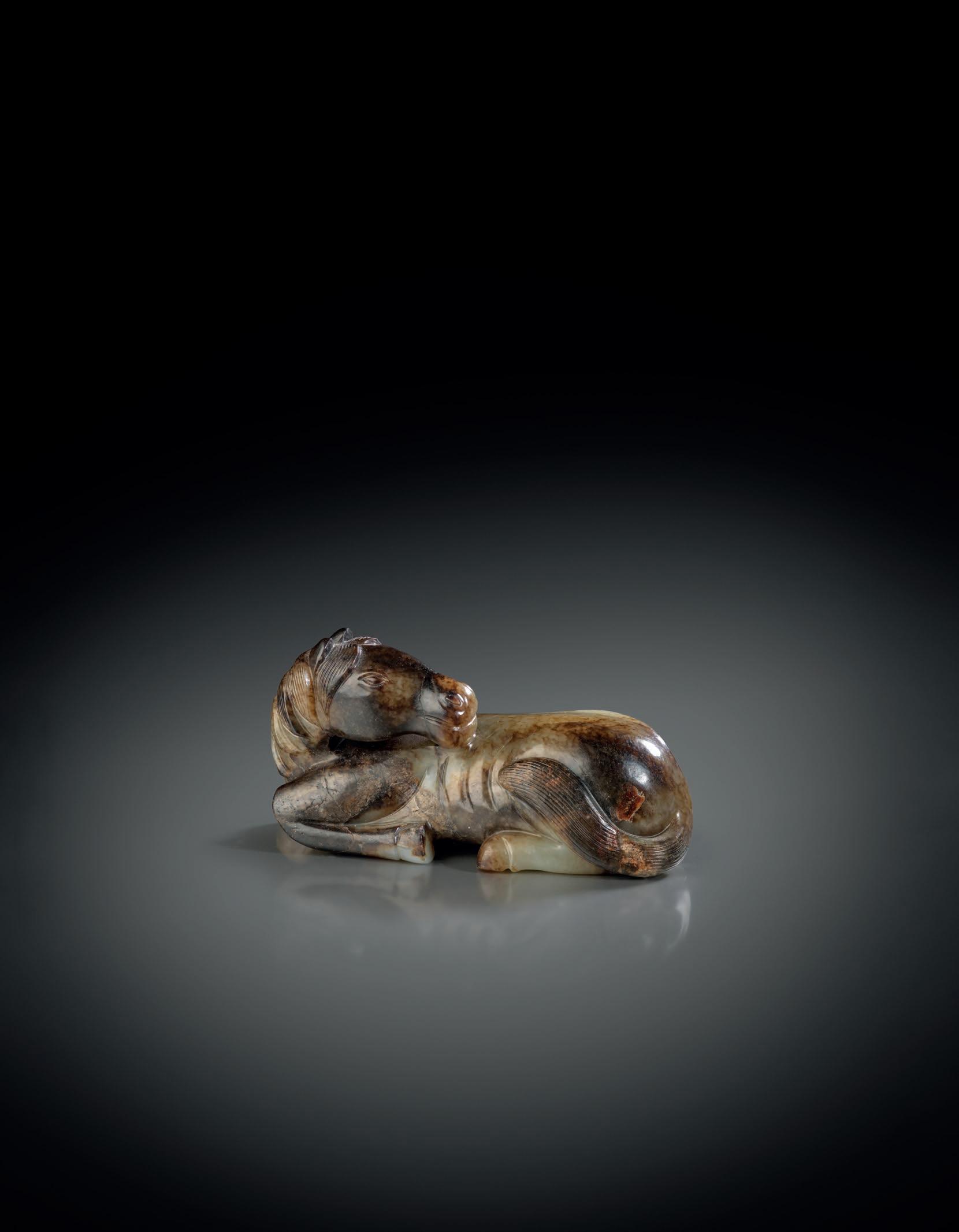
The flattened body rising to a waisted neck and upright rim, worked in low relief to each principal side with a fylfot and a qing tied with flowing ribbons, the archaic chime decorated with simple scrolls and a shou character, with large ruyi motifs below the design, the body set with a curved handle formed as a split branch and a slender spout terminating in an animal mask, with a simple loop knop to the top of the domed cover, the pale stone with a russet and cloudy white marking to one side, 18.4cm. (2)
Provenance: the Lawrence Collection of jades and hardstone carvings, purchased from Roger Keverne Limited on 25th June 2007. A copy of the invoice is available.
Published: R Keverne, Jade, p.170, fig.106; and also R Keverne, Summer Exhibition 2007, p.126, no.110.
The fylfot is a sacred symbol in many religions; in China it is usually associated with Buddhism, and is one of the 65 auspicious signs on the footprint of Buddha. It is also regarded as the impression of the Buddha, and is often seen on the chest of Sakyamuni Buddha. The name swastika is derived from Sanskrit, meaning ‘so be it’. The Chinese, however, read it as the character ‘wan’ ten thousand, which is descended from heaven. In popular belief, it represents auspiciousness. The symbolism in the decoration of this ewer suggests that it was probably made as a birthday present for an important member of the Imperial palace.
Cf. R Kleiner, Chinese Jades from the Collection of Alan and Simone Hartman, pp.58-59, no.52 for a related ewer; see also Zhongguo Yuqi Quanji, vol.6, pp.2-3, nos.2 and 3 for further ewers in the collection of the Palace Museum.
£4,000-6,000
2007 年 6 月 25 日 Roger Keverne 古董店(附發票複印件)。
出版:R Keverne, Jade,頁 170,圖 .106;and also R Keverne, Summer Exhibition 2007,頁 126,編號 110。
來源:勞倫斯珍藏玉石,
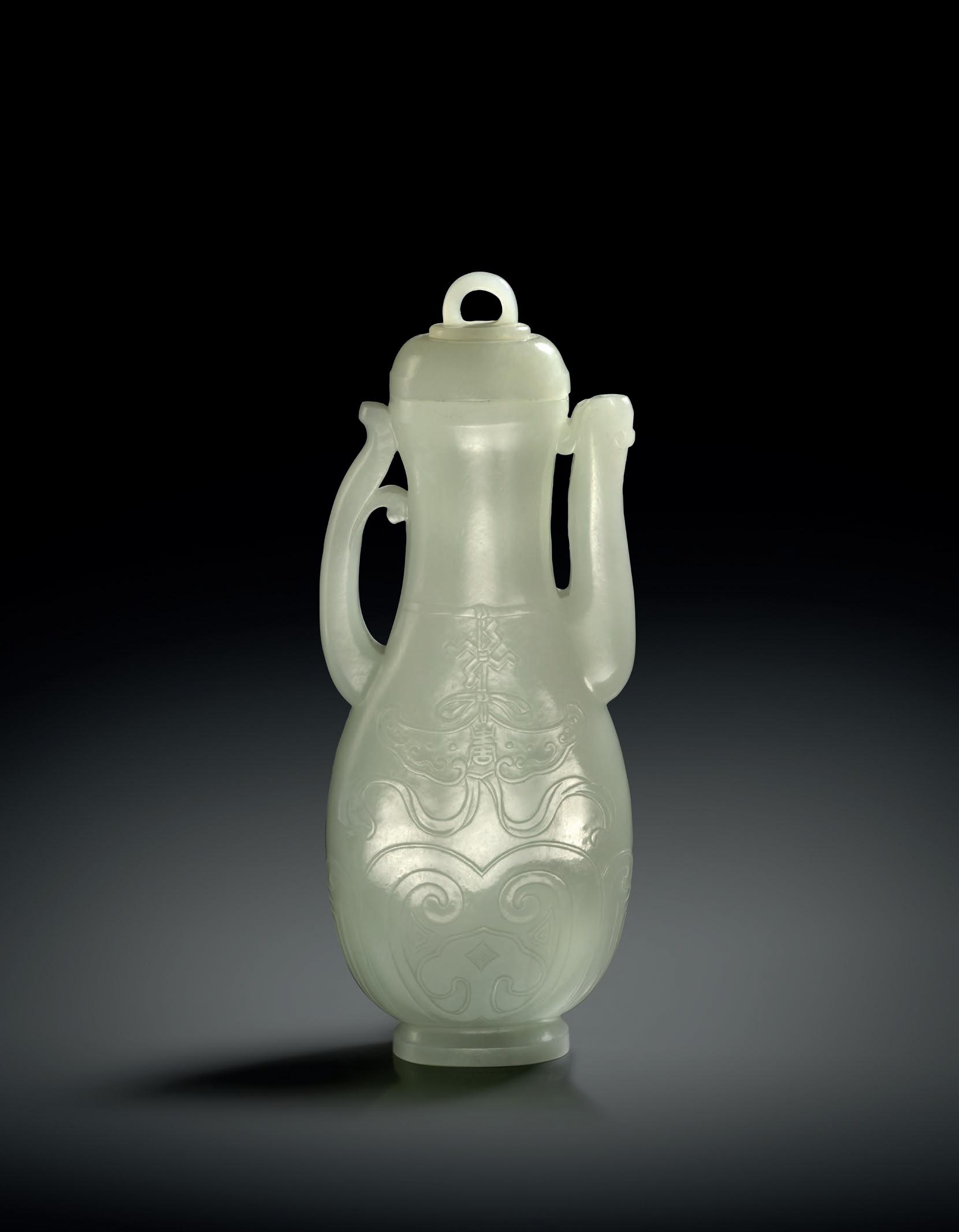
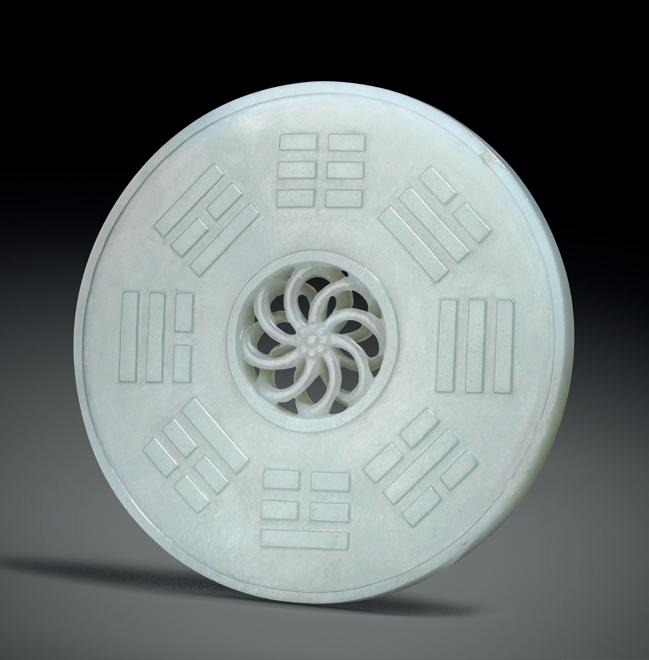
The circular disc delicately pierced to the centre with intertwined petals forming an elegant flowerhead, carved to one side in low relief with The Eight Trigrams, Bagua, with the names of The Ten Heavenly Stems, Tiangan, in seal script beneath a continuous band of ruyi-heads to the reverse, the stone of an even white tone, 9.2cm.
Provenance: formerly a western private collection; and then the Lawrence Collection of jades and hardstone carvings, purchased from Roger Keverne Limited on 23rd October 2007. A copy of the invoice is available.
Published: R Keverne, Winter Exhibition 2007, pp.124-125, no.111.
The Eight Trigrams consist of broken and solid lines, which represent yin and yang respectively. They were probably first used by ancient diviners and later developed into a system of philosophy. Each trigram represents a natural force: heaven, marsh, fire, thunder, wind, water, mountain and earth. They also symbolise movement, emotions and human relationships and have been used in China to predict patterns and cycles in nature and humanity. From the eight trigrams developed sixty-four hexagrams that are the foundation of one of the most important Chinese classics, the Yijing or The Book of Changes. Each of the Ten Heavenly Stems is associated with one of the Five Elements (wood, fire, earth, metal and water) and they combine with the Twelve Earthly Branches to form the sexagenary cycle, which is the traditional Chinese calendar based on sixty-day and sixty-year cycles.
Cf. K R Tsiang, Radiance and Virtue: The R Norris Shreve Collection of Chinese Jade and Other Oriental Works of Art, p.19, pl.4 for a disc with spiral decoration made from a material of similarly high quality; see also Schätze Chinas aus Museen der DDR, p.244, no.139 for a related pendant.
£10,000-20,000
2007 年 10 月 23 日 Roger Keverne
出版:R Keverne, Winter Exhibition 2007,頁 124-125,編號 111。
來源:勞倫斯珍藏玉石,

Formed as a simple ten-petalled flowerhead, finely decorated with a stylised blossom to the centre of the shallow domed cover, the box with a well-hollowed interior, the pale translucent stone with a lustrous polish, 14.2cm dia. (2)
Provenance: the Lawrence Collection of jades and hardstone carvings, purchased from Spink & Son prior to 1959.
There are a number of similar pieces found in the old Imperial collection, now housed in Beijing and Taipei.
£20,000-30,000
來源:勞倫斯珍藏玉石,1958 年前購於 Spink & Son。
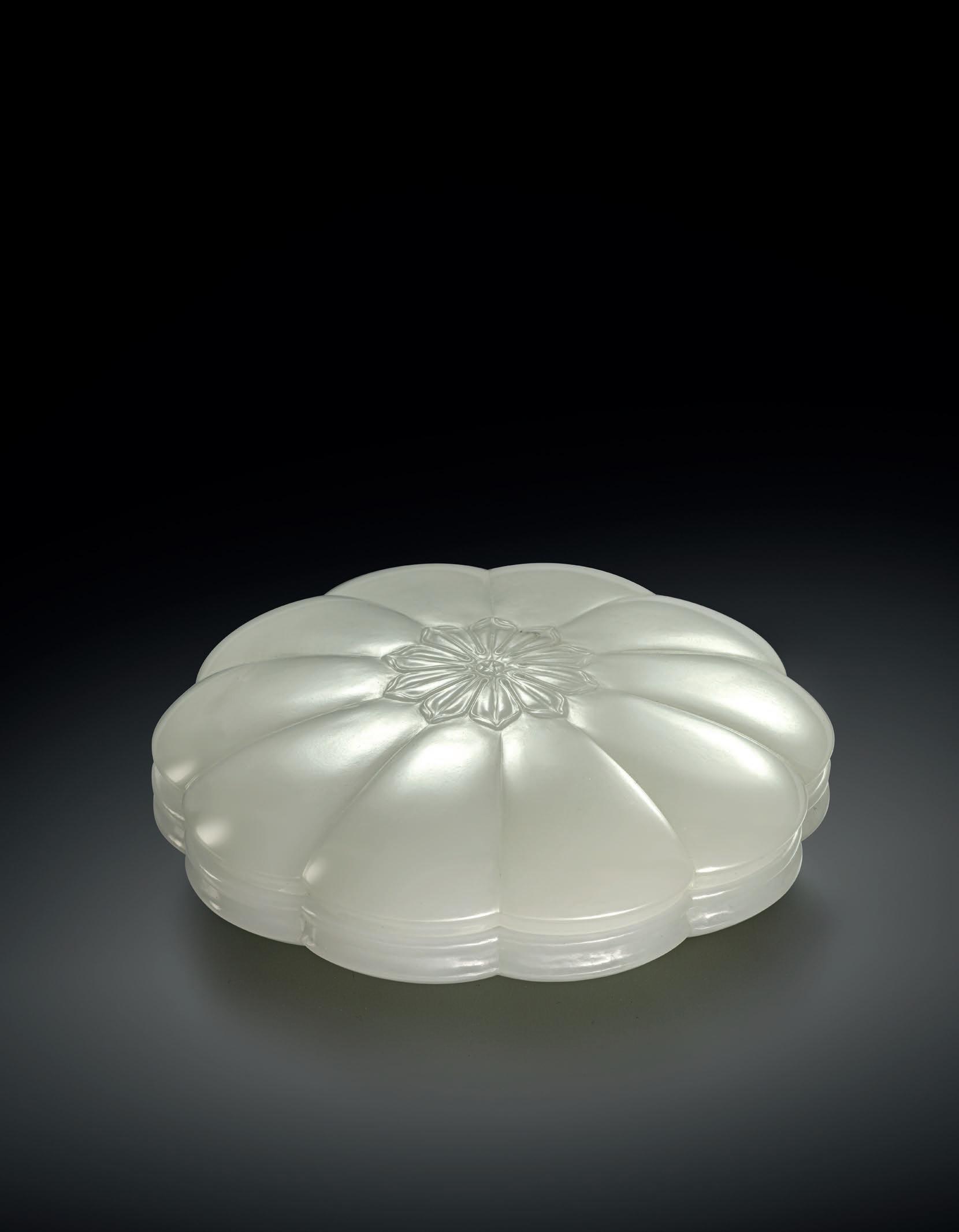
18TH CENTURY
The elegant ovoid body gently tapering towards the ends, carved in low relief to the shoulder and around the foot with bands of archaistic triangular blades alternating with ruyi-heads beneath stylised scrolls, all supported on a short foot with convex sides and a recessed base, the pale stone with a lustrous polish, 10.2cm.
Provenance: the Lawrence Collection of jades and hardstone carvings, purchased from Roger Keverne Limited on 1st December 2009. A copy of the invoice is available.
Published: R Keverne, Winter Exhibition 2009, pp.114-115, no.100.
The shape of this vase is based upon that of a barrel stool.
Cf. G Wong & E Goh, Imperial Life in the Qing Dynasty: Treasures from the Shenyang Palace Museum, China, p.5 for a cup with comparable archaistic decoration.
£10,000-20,000
來源:勞倫斯珍藏玉石,2009 年 12 月 1 日購於 Roger Keverne 古董店(附發票複印件)。
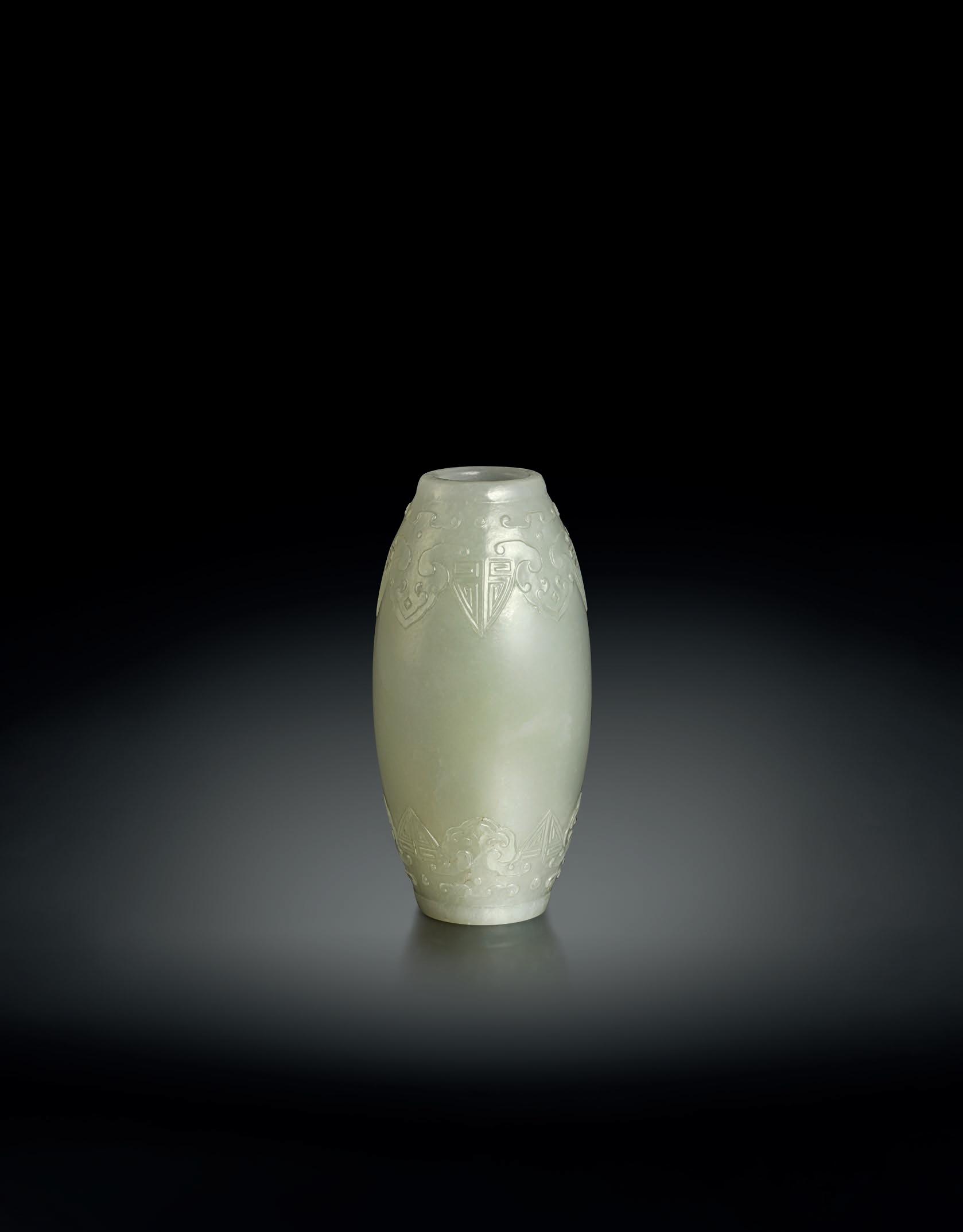
Each with a square-section body surmounted by a crouching dragon in pursuit of a flaming pearl, the mythical beasts depicted with long whiskers and finely incised beards and manes, their scaly coiled bodies partially concealed by billowing clouds, each seal with four characters to the underside, one worked in intaglio, yinwen with the characters jian lan bo zhao, the other marked zhi cheng yu ling in relief, yangwen, the mottled green stone with dark specks and pale inclusions, 6.4cm wide. (2)
Provenance: formerly the collection of Major-General Charles Gordon (1833-85); and then the Lawrence Collection of jades and hardstone carvings, purchased from Spink & Son prior to 1959.
Seals played an important role in Chinese Imperial life. The famous story goes that when the First Emperor Qin Shi Huangdi united China, he made a jade seal with the inscription: ‘Having received the mandate from heaven, may the Emperor enjoy a long life and eternal prosperity.’ Traditionally, the Imperial seals represented not only the order and identity of the ruler, but also the universal principles. During the Qing dynasty, many jade seals were made under Imperial orders. They usually have a standard form and decoration. The present two seals were probably made during the Qianlong reign or slightly later.
£100,000-200,000
來源:Charles Gordon(1833-85
印文:兼覽博照(陰文)、至誠與鄰(陽文)
)大將軍舊藏,勞倫斯珍藏玉石,1958 年前購於 Spink & Son。
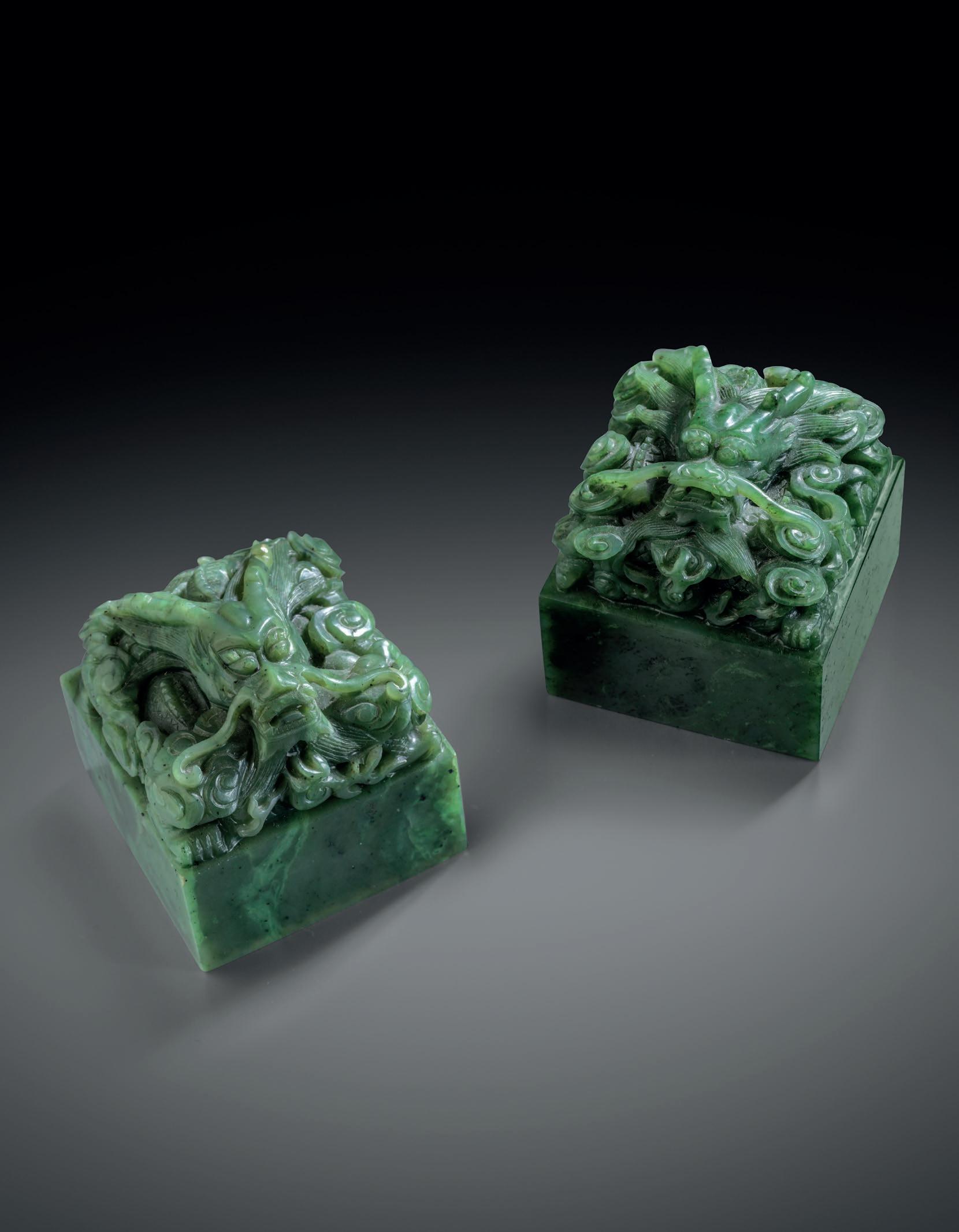

Major-General Charles Gordon was in China from 1860 to 1864. In 1863, he was placed in command of the Ever Victorious Army, a force of Chinese soldiers directed and trained by European officers which was instrumental in putting down the Taiping Rebellion. The Emperor conferred on him the highest rank in the Chinese army and awarded him with the Imperial yellow jacket in recognition of his services in China. Gordon soon gained the popular nickname 'Chinese Gordon'.
The inscription jian lan bo zhao may be translated as 'observe all varieties, be enlightened by their depth'. The phrase first appears in the Hou Hanshu, or the 'History of the Later Han', by Fan Ye (398445). When the Han government decided to reform the civil service examination system, making it a requirement to study the classic texts, several ministers wrote in criticising the policy. They argued that the ruler's virtue was based on his ability to 'observe all varieties and be enlightened by their depth', and that a minister's loyalty hinged on his readiness to correct ill-founded policies. The phrase later acted as a reminder to emperors of the importance of observance and enlightenment in good governance.
The inscription on the other seal, zhi cheng yu ling, translates as 'be a close neighbour with the utmost sincerity.' This originally comes from a traditional temple hymn that was recorded in the Quan Tang Shi, or 'The Complete Collection of Tang Poems', which was commissioned by the Kangxi Emperor in 1705. The full verse reads: 'The Way of Heaven is not personal, be a close neighbour with the utmost sincerity; worship spreads over mountains and rivers, the court music refreshed; the offerings of jades and silks are not rich, meet the truth with wisdom and enlightenment; verify this unique virtue, then communication is enabled with one hundred gods.'

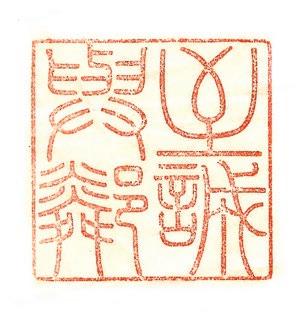
查理.戈登將軍在 1860 年至 1864 年期間駐守中國。1863 年,他接任常勝軍的指揮官,聯同英美 等外國軍官指揮及培訓中國士兵,組成部隊鎮壓太平軍勢力。戈登曾獲兩宮太后授予「常州提督」 軍銜及賜穿黃馬褂,以表彰他在中國的軍事功勛。因此,戈登很快獲得了「中國戈登」的綽號。
方印上的陰文「兼覽博照」意思是明察四方,從而悟得世間的奧義。出自范曄(398-445)的《後 漢書.胡廣傳》:「君以兼覽博照為德,臣以獻可替否為忠。」漢朝政府決定改革文官考試制度, 強制要求研習古籍,而幾位大臣以大力批評這項新政。他們認為當權者的美德基於他對「明察四 方」的能力,而大臣的忠誠取決於他是否有明辦是非善惡的意識。「兼覽博照」一詞後來成為警 示皇帝,治國須明察秋毫的金石良言。
另一方印上的陽文「至誠與鄰」則是以至誠之心待人。出自一首傳統的寺廟詩歌,被記載在康熙 皇帝於 1705 年委託編纂的《全唐詩》中。完整的詩句如下:「天道無親,至誠與鄰。山川遍禮, 宮征維新。玉帛非盛,聰明會真。正斯一德,通乎百神。」
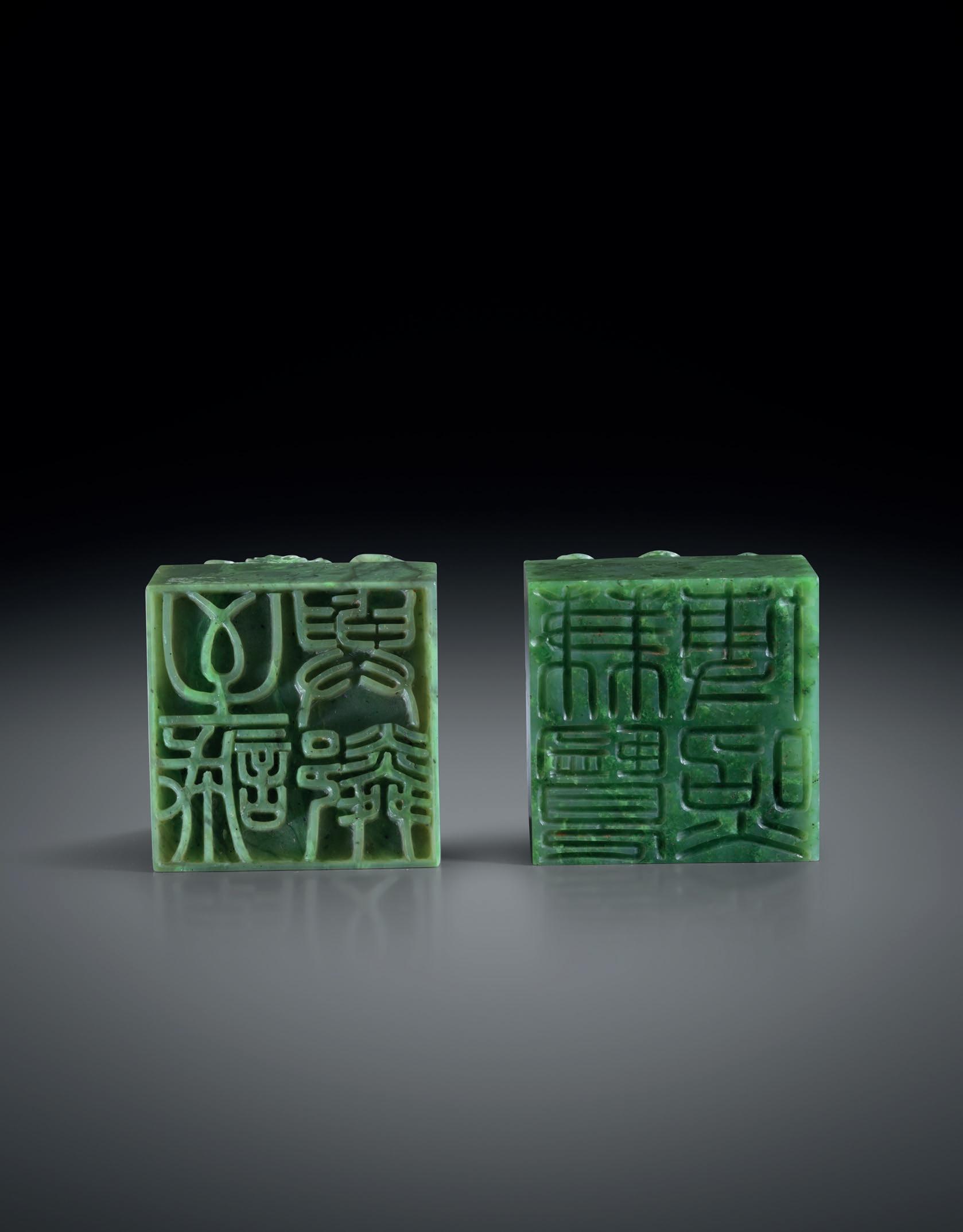
Each with a fluted body surmounted by a short wide neck, the rounded bodies tapering towards the feet, the domed covers pierced with scrolling leafy branches and flowers set beneath stylised concave petals, each surmounted by a knop decorated with a central shou medallion surrounded by eight ruyi-heads, the pale stone of a fine white tone and with a lustrous polish, 11.4cm dia. (4)
Provenance: formerly the collection of HM Queen Maria of Yugoslavia (1900-61); and then the Lawrence Collection of jades and hardstone carvings, purchased from Spink & Son prior to 1959.
Cf. C T Loo, Exhibition of Chinese Arts, no.341 for a pair of related bowls; see also The Complete Collection of Treasures of the Palace Museum, Jadeware (III), p.82, no.70 for an incense set decorated with comparable ribbed sides.
£100,000-200,000

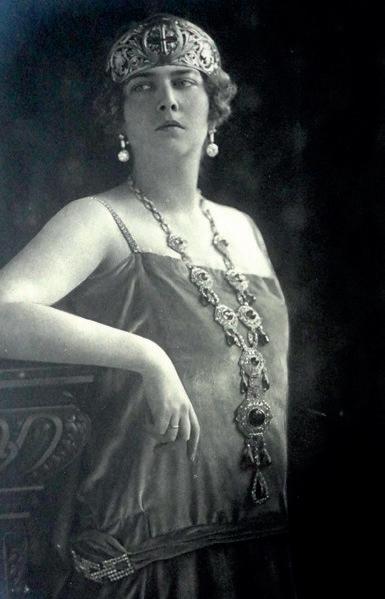
HM Queen Maria of Yugoslavia was Queen Consort to King Alexander I of Yugoslavia. Her titles included HM Queen Maria of Yugoslavia (1929-45), HM The Queen of Serbs, Croats, and Slovenes (1922-29), and HRH Princess Maria of Romania (1900-22). Maria was born in Gotha, Thuringia, Germany during the reigns of her maternal grandfather Duke Alfred of Saxe-Coburg and Gotha and her great uncle King Carol I of Romania. Her father was Crown Prince Ferdinand of Romania and her mother was Princess Marie, a daughter of Prince Albert, Duke of Edinburgh, who was one of Queen Victoria's sons. She was also the great-granddaughter of Tsar Alexander II of Russia on her mother's side. Maria married King Alexander I of the Kingdom of Serbs, Croats and Slovenes on 8th June 1922. Following the assassination of King Alexander in Marseille in 1934, her eldest son became Peter II of Yugoslavia, the last Yugoslav king, and she later became the Queen Mother of Yugoslavia. Maria's citizenship was revoked by the Yugoslav Communist regime in 1947 and she died in exile in London on 22nd June 1961. She is interred at the Royal Burial Ground at Frogmore. Queen Maria of Yugoslavia is known to have been a keen collector of Oriental art, and her collection was dispersed in the 1930s and 1940s.
南斯拉夫王后瑪利亞為亞歷山大國王的妻子,她的頭銜包括 HM Queen Maria of Yugoslavia (1929-45)、HM The Queen of Serbs、Croats、Slovenes (1922-29)
及 HRH Princess Maria of Romania (1900-22) 王后生於德國哥達,顯赫的家族 族譜中有她的爺爺是 Alfred of Saxe-Coburg 哥達公爵。她的叔父是羅馬尼 亞的卡羅國王;父親是羅馬尼亞王儲費迪南德,而母親是瑪利亞公主。 1934 年,亞歷山大國王在法國馬賽被暗殺之後,他們的長子成為了南斯拉 夫新國王彼得二世,也是南斯拉夫最後一位國王。1947 年瑪利亞王后的南
斯拉夫國籍被當時的政權撤銷,流亡到了倫敦,並於 1961 年 6 月 22 日逝世, 後被埋葬在位於伯克郡的浮若閣摩爾莊園。瑪利亞王后是一個非常熱愛 東方藝術品的收藏家,她的藏品在 1930 至 1940 年代被分散傳承。
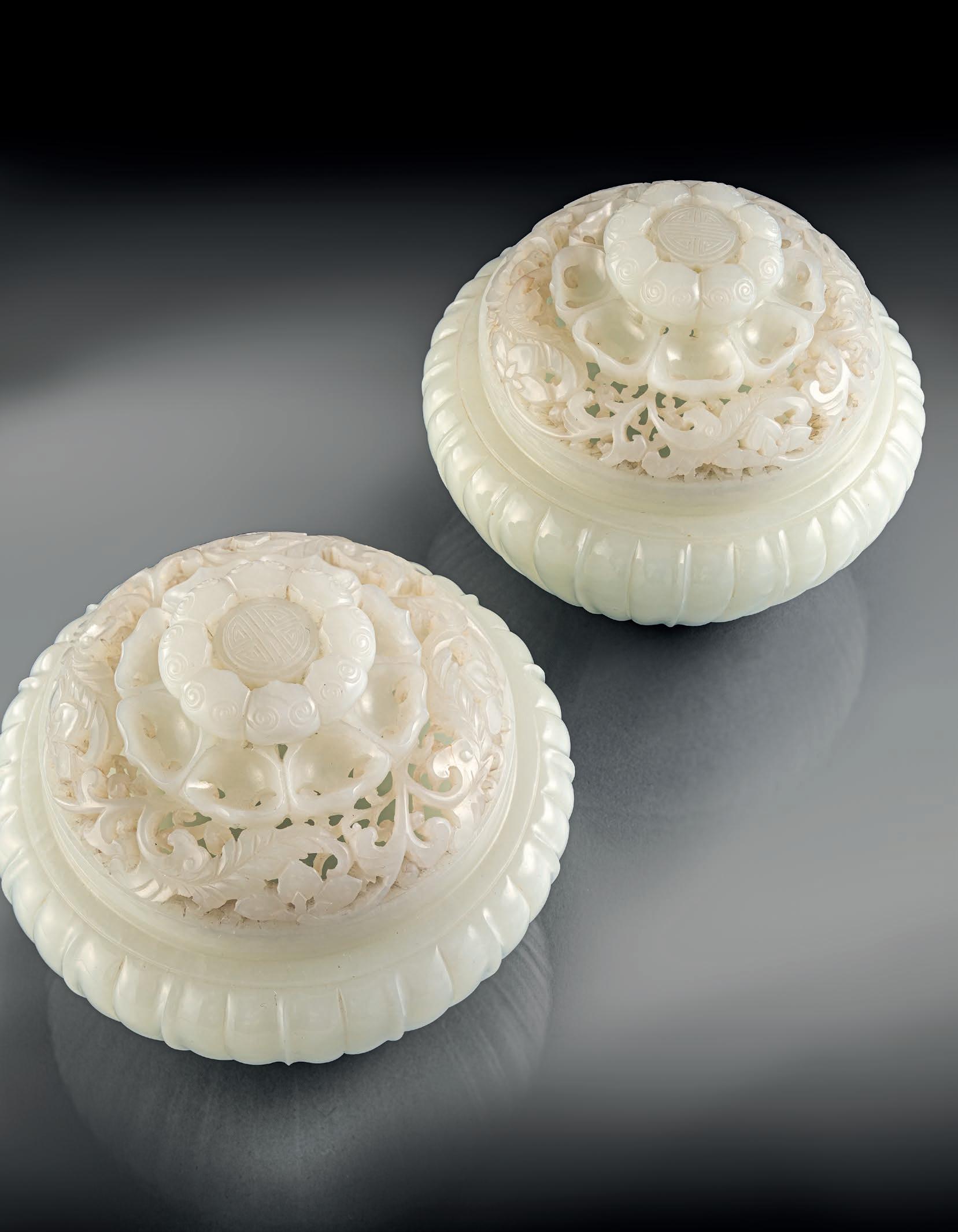
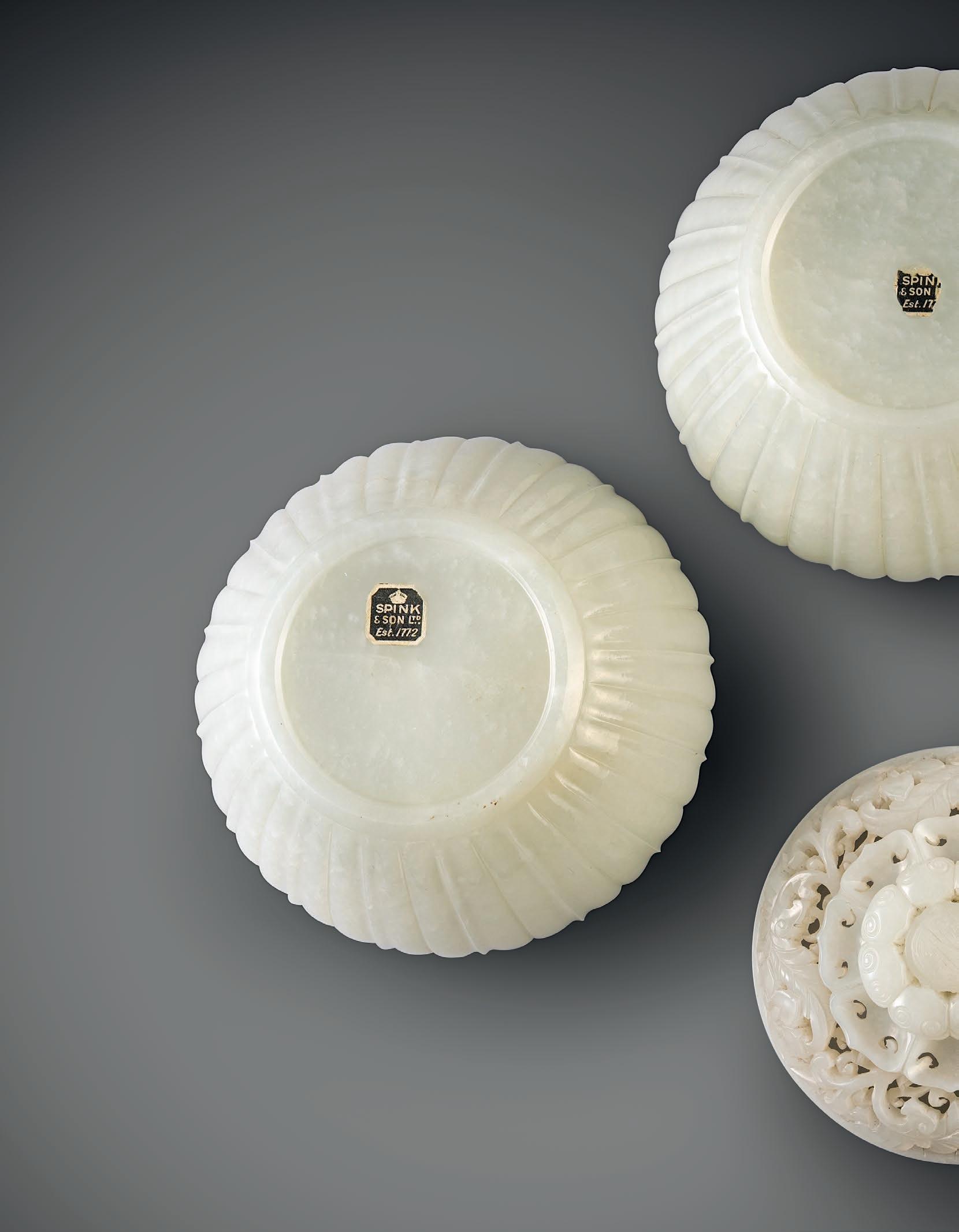
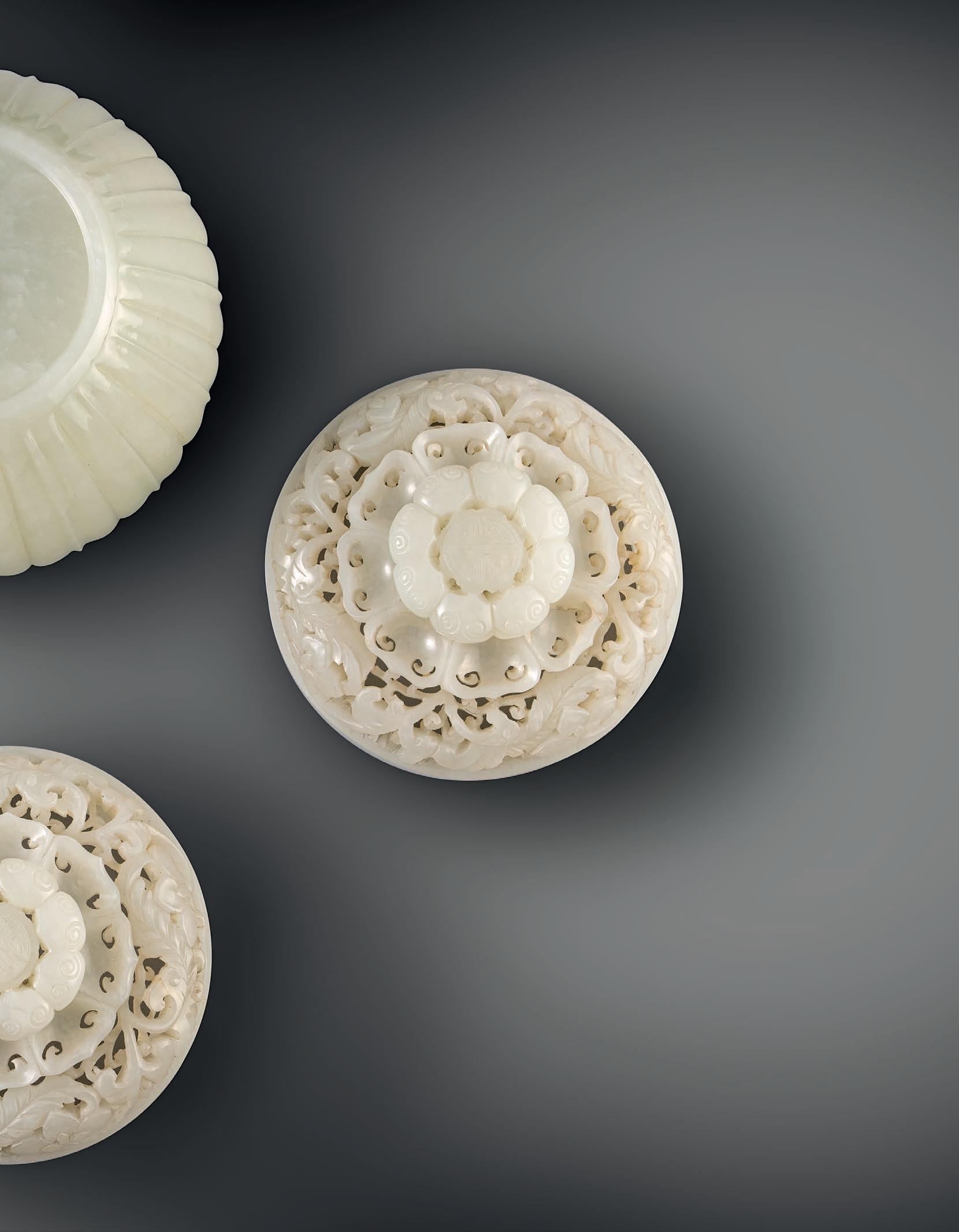
Based on the form of an archaic bronze gui, the low rounded body supported on a broad flared foot, subtly decorated in low relief to the shoulder with a narrow band of ruyi-heads, with two slender S-shaped handles rising from the sides, the domed cover surmounted by a compressed circular knop, the finial carved with narrow petals radiating from a central medallion incised with swirling petals, the translucent stone of a superb even white tone, 13.1cm wide. (2)
Provenance: the Lawrence Collection of jades and hardstone carvings, purchased from Spink & Son prior to 1959.
The beauty of this object lies essentially in the quality of the stone. The Chinese rank jades according to their colour tones, with the most prized jades being the yangzhiyu, ‘mutton fat’ nephrite that is sourced from the rivers in Khotan. The jade carver used nephrite of the highest quality, and kept a simplicity in its design. The collector’s appreciation derives from the creamy-tone of the jade and its simple form.
Cf. J Li, Chinese Jades Throughout the Ages - Connoisseurship of Chinese Jades, vol.12, pp.186-187, no.93 for a related incense burner and cover in the collection of the Palace Museum carved in jade of a comparable high quality; see also Asian Art I, 18th May 2011, lot 471 for an Imperial Qianlong period white jade teapot and cover previously sold in these rooms, which was worked in similarly high quality stone.
£150,000-250,000

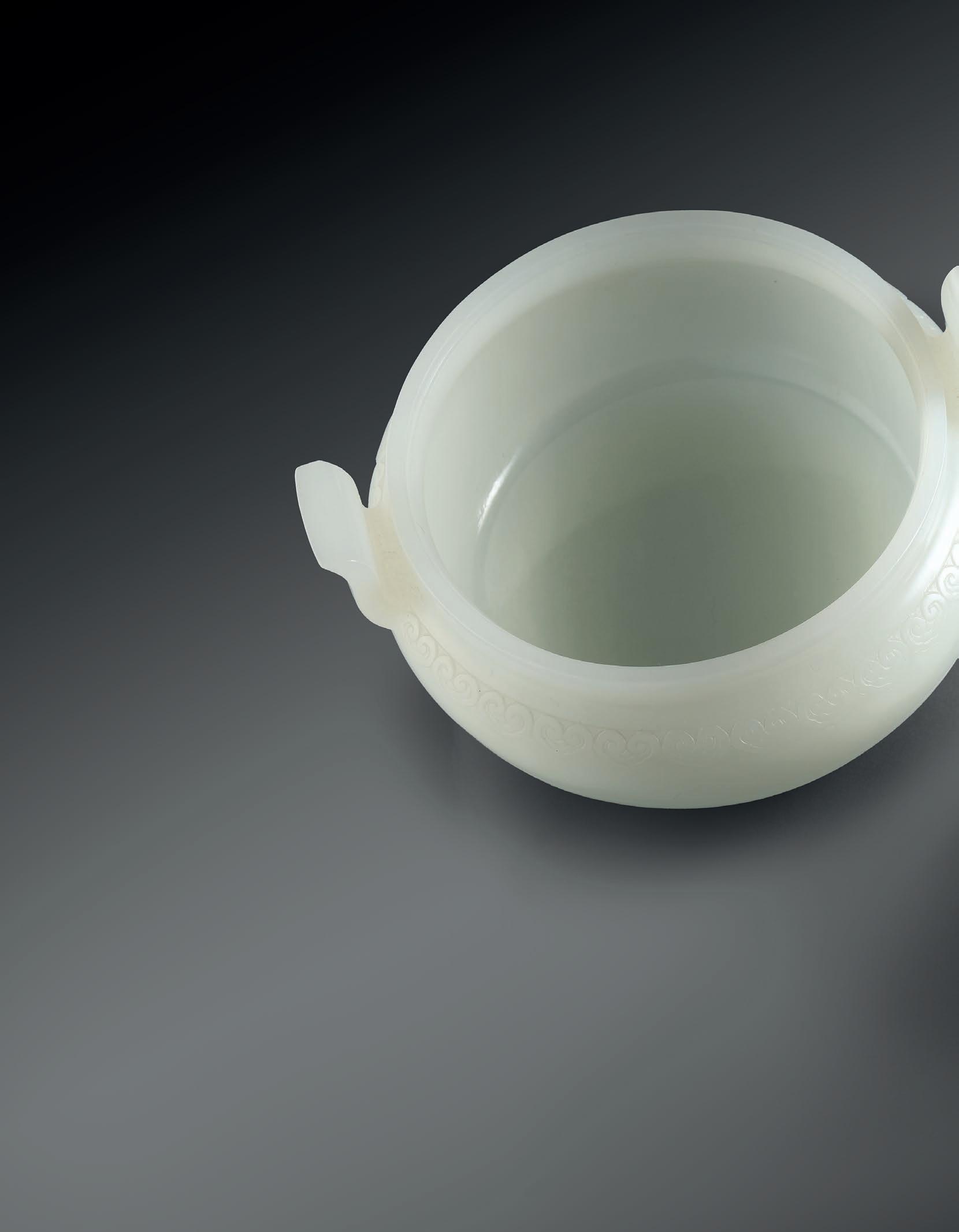

Naturalistically formed as a section of bamboo culm gently tapering towards the top, each segment separated by a raised and incised node, with fluted lower sections, carved in relief with two smaller leafy bamboo branches issuing from the base and extending over the exterior, the pale stone with areas of russet and light grey, 18.4cm.
Provenance: the Lawrence Collection of jades and hardstone carvings, purchased from Spink & Son prior to 1959.
This jade vase is carved from a white nephrite of exceptional quality, which was sourced from Khotan in Xinjiang. It represents the best of the jade craftsmanship of the early Qing dynasty. Bamboo grows widely in East Asia and has culinary, medicinal, textile and construction uses, as well as being admired as an artistic material. It has an important symbolism in Chinese culture, where it is associated with a gentleman’s virtue and endurance. There is an old Chinese saying: “A gentleman’s residence cannot be without bamboo”. A vase in bamboo-form was usually for holding flowers, but could also be used as brush pot on the scholar’s desk. Similar objects were made for the Imperial household.
£50,000-80,000
1958 年前購於 Spink & Son。
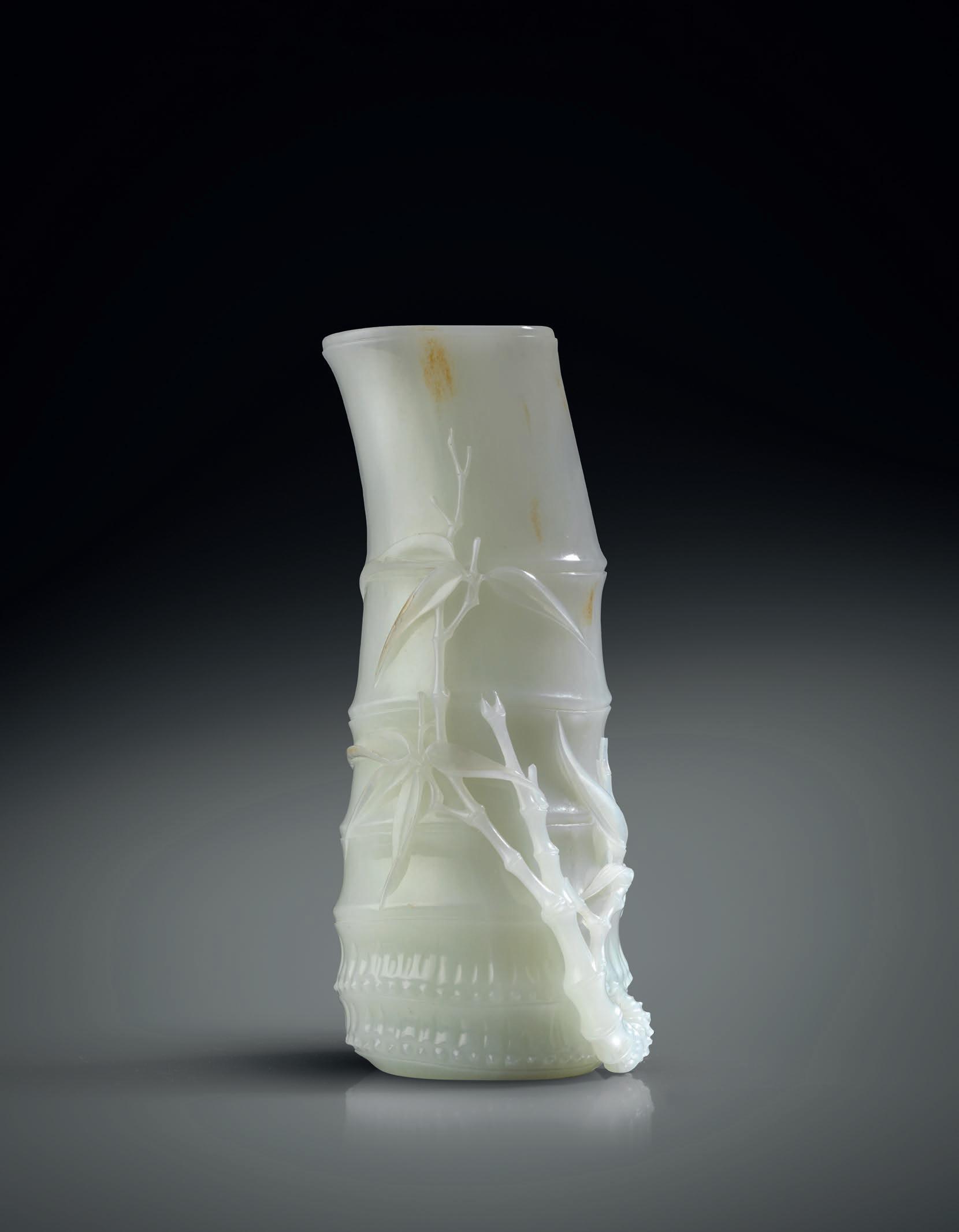


Carved in low relief to the exterior with archaistic masks, the stylised design divided by notched high-relief flanges with incised decoration, the squat body flanked by two handles worked as two-horned dragons suspending loose rings, the domed cover surmounted by a flared circular knop surrounded by three recumbent goats, the animals well-depicted with incised details to their spines and beards, all raised on three short feet shaped as animal paws issuing from the mouths of mythical beasts, taotie, the mottled spinach-green stone with a lustrous polish, 24.8cm across. (2)
Provenance: formerly the collection of Sir John Buchanan-Jardine Bt; and then the Lawrence Collection of jades and hardstone carvings, purchased from Spink & Son prior to 1959.
Sir John William Buchanan-Jardine, 3rd Baronet (1900-69) was Chairman of Jardine, Matheson & Co. Eighty-one Chinese works of art from his collection were exhibited at the Royal Academy exhibition of 1935-36. Sotheby’s held sales of his superb collection in the late 1940s.
This incense burner was inspired by the prototype of the archaic bronze gui vessels of the Shang and Zhou periods. The bronze gui was a food container used for ancestral worship. It first appeared in ceramic form in the Neolithic period, and came to have an important role in traditional rituals. In the Ming and Qing periods, the archaic forms of early bronze ritual vessels were recreated in various materials, such as ceramic, lacquer and jade. The present jade incense burner is smaller in size than the original archaic bronze vessels. It was also used in a very different context, as an incense burner rather than a food container. The taotie refers to a two-eyed mask that appears on almost every Shang ritual bronze. The ancient belief was that the taotie mask represented a wanton spirit. However, modern scholars are divided in their opinions of what the motif really meant, or whether it had any meaning. To employ such a motif from antiquity indicated the revival fashions of the later periods.
Cf. The Complete Collection of Treasures of the Palace Museum, Jadeware (III), pp.83-84, no.71 for a related incense burner, which is part of a set.
£40,000-60,000
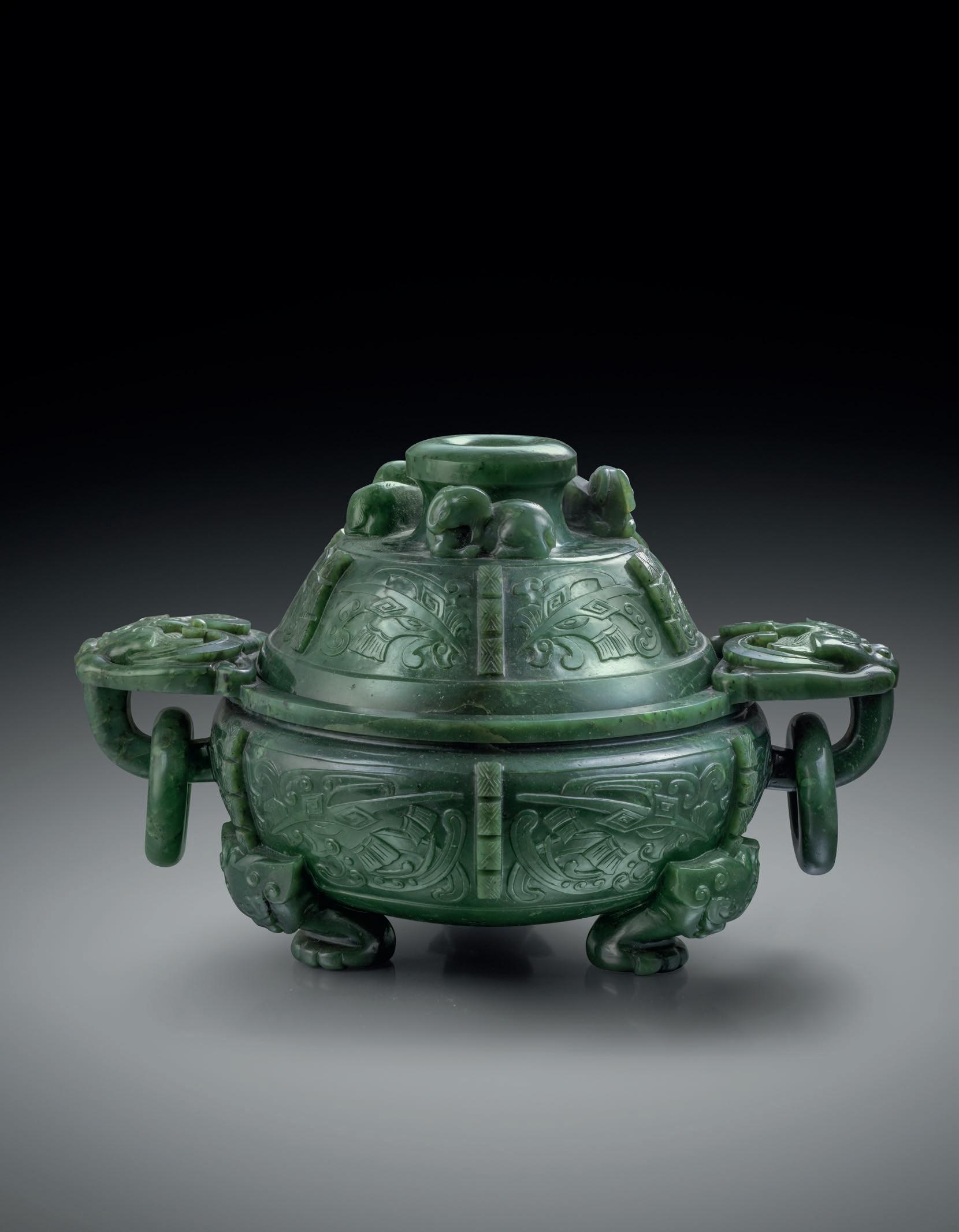
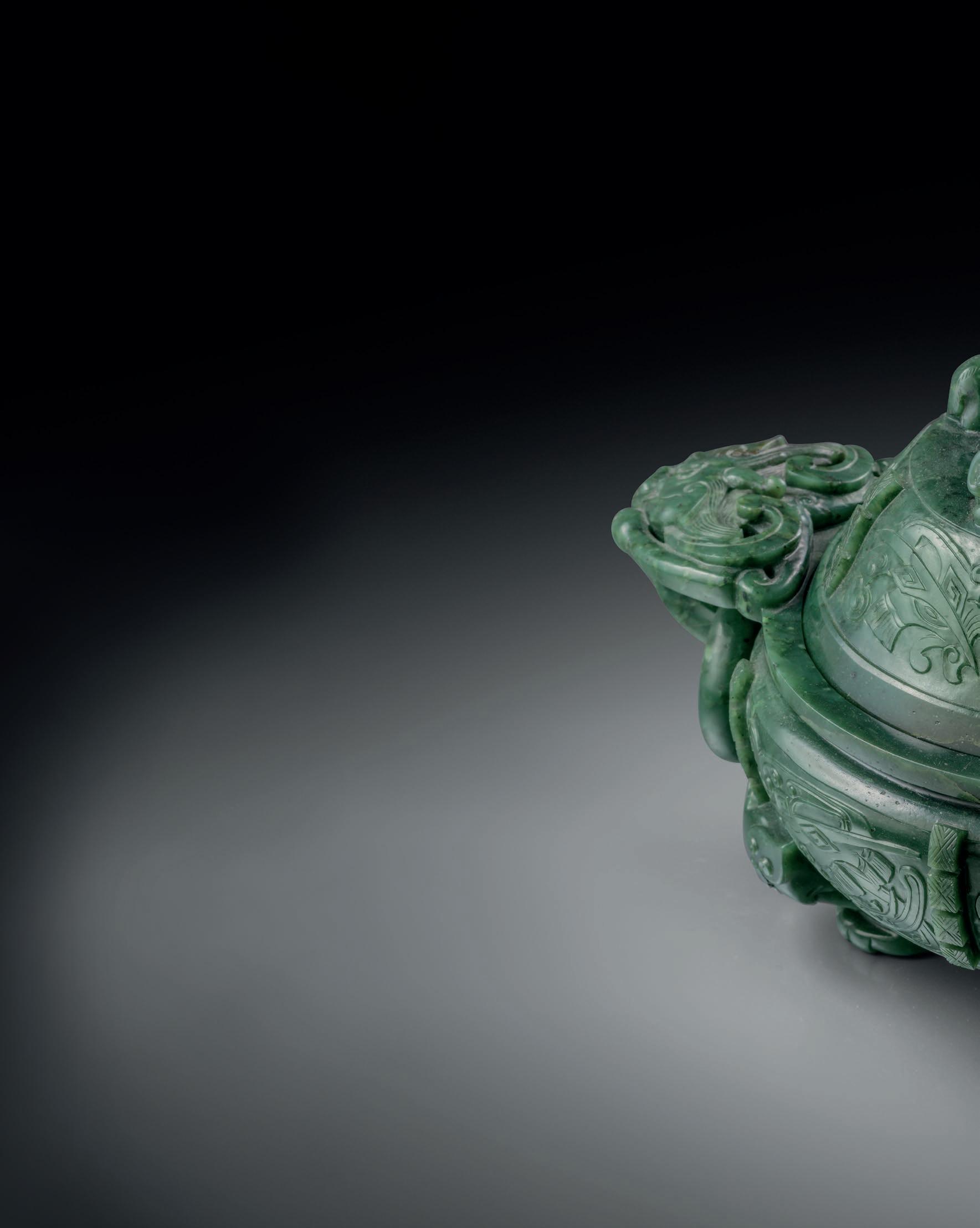

Each with an elegant U-shaped body gently flaring at the rim, raised on short spread feet, with the reign marks incised to the bases in clerical script, lishu, the stone of an even white tone and with a good polish, 12.4cm dia. (2)
Provenance: formerly the Cottreau Collection, sold at Galerie Georges Petit, Paris, on 29th April 1910, lot 119; and then the Lawrence Collection of jades and hardstone carvings, purchased from Roger Keverne Ltd on 25th October 2009. A copy of the invoice is available.
Published: R Keverne, Winter Exhibition 2009, pp.122-123, no.105.
Both their perfect form and the quality of the stone from which they are carved make these bowls exceedingly rare. The few known comparable examples occasionally bear Qianlong reign marks, but they are more often unmarked. In Chinese Jade from the Neolithic to the Qing, Jessica Rawson illustrates a pair of similar unmarked bowls, p.400, no.29:13. Here, it is noted that “Undecorated jade vessels in porcelain shapes, as here, probably represented the highest quality of eating and drinking vessels. Both the sumptuary laws, which restricted the use of jade vessels, and passages in novels that mention the use of jade cups and bowls for eating and drinking, make it evident that jade was highly valued and used for these purposes.”
Cf. F Dunand, The Baur Collection Geneva, p.43, B38 for one of a pair of similar Qianlong mark and period bowls; see also J Rawson & J Ayers, Chinese Jade Throughout the Ages, no.436 and B Yang, A Romance with Jade: From the De An Tang Collection, p.178, no.115 for further Qianlong mark and period examples; for other comparable bowls without reign marks, see also J C Y Watt, Chinese Jades from Han to Ch’ing, p.178, no.152 and B Yang, A Romance with Jade: From the De An Tang Collection, p.176, no.113 and p.179, no.116.
£50,000-80,000
來源:Cottreau 舊藏,購於巴黎 Galerie Georges Petit1910 年 4 月 29 日,編號 119,勞倫斯珍藏玉石,
2009 年 10 月 25 日購於 Roger Keverne 古董商(附發票複印件)。
出版:R Keverne, Winter Exhibition 2009,頁 122-123,編號 105。
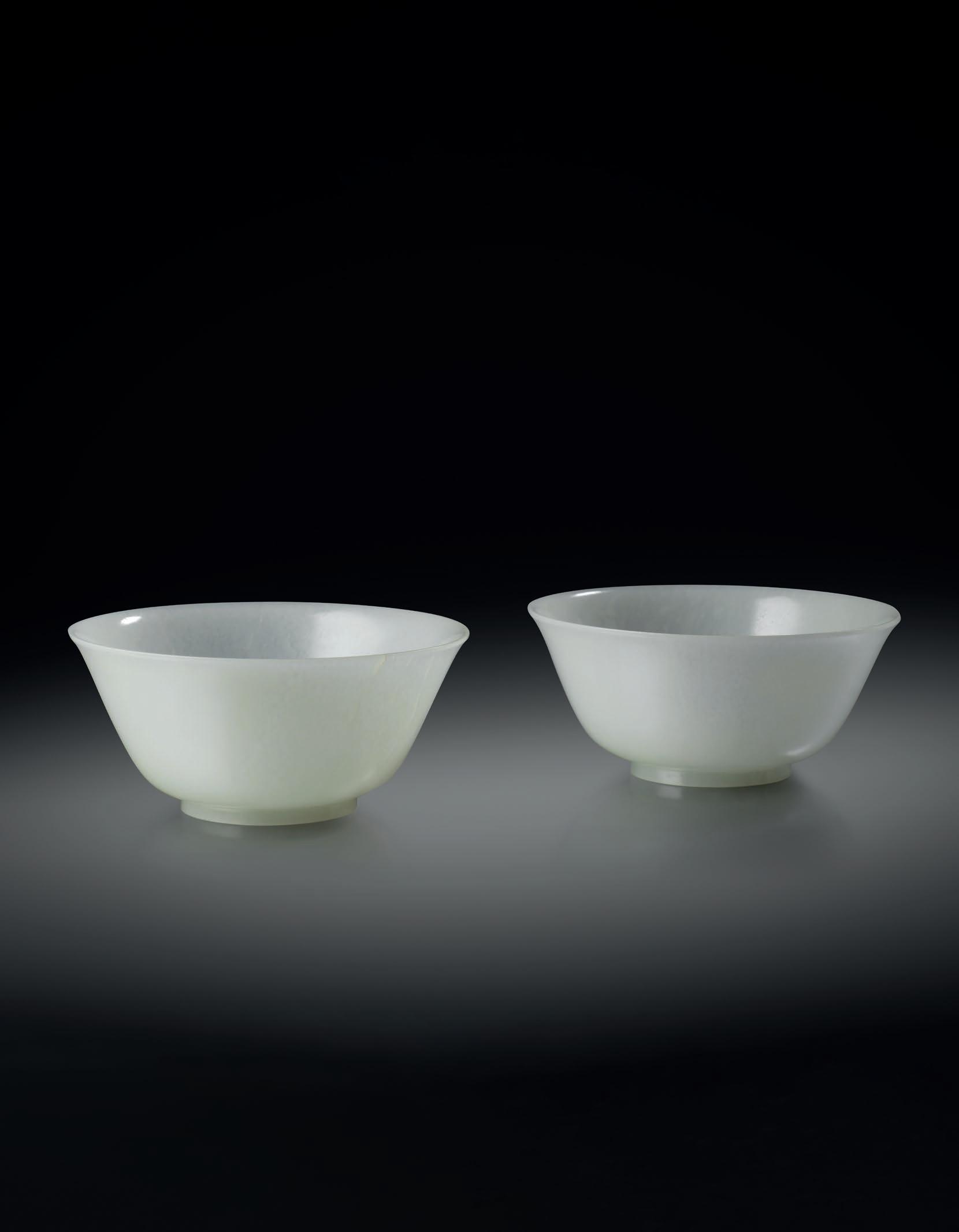

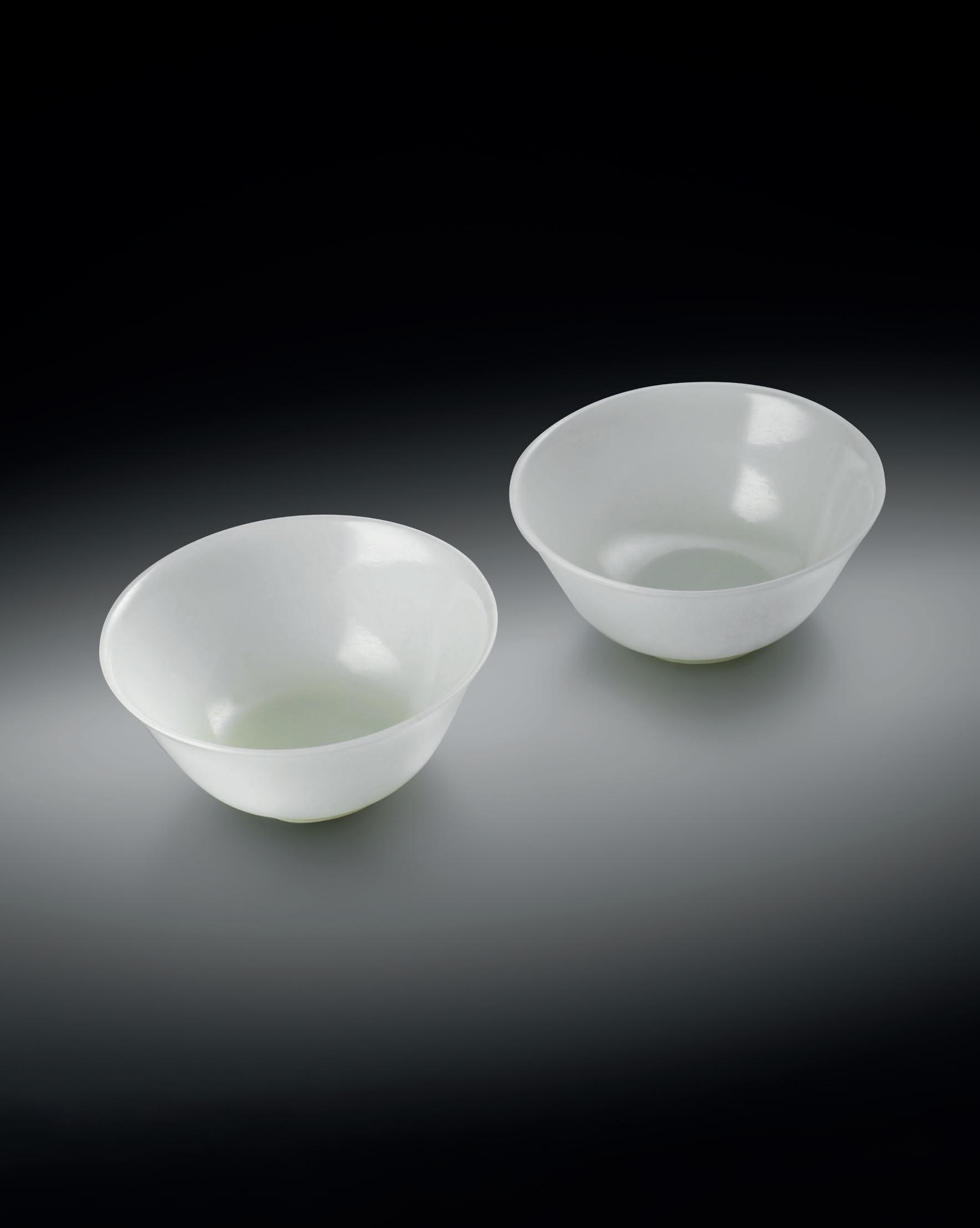
The vessel naturalistically formed as a large lotus leaf furling at the edges, the surface finely incised with the leaf’s veins, carved in relief with lotus flowers, leaves and seed pods growing over the exterior, with a single crane gazing over its back as it perches on one leg amidst the plants, the bird finely rendered with details of its feathers, the natural red skin and the white stone cleverly incorporated in to the design, together with a wood stand, 17.8cm. (2)
Provenance: the Lawrence Collection of jades and hardstone carvings, purchased from Spink & Son prior to 1959.
£4,000-6,000
來源:勞倫斯珍藏玉石,1958 年前購於 Spink & Son。

Comprising a brush washer and waterpot, the waterpot formed as a hollowed peach upon a rock, the brush washer worked as a tree trunk carved in relief with a bat and lingzhi, with an elegant phoenix and a peach uniting the two vessels, the mythical bird and small fruit picked out in a green section of the stone, the base incised with three characters reading Tian lai ge, The Pavilion of Heavenly Sound, 20.3cm.
Provenance: the Lawrence Collection of jades and hardstone carvings, purchased from Spink & Son prior to 1959.
The Pavilion of Heavenly Sound was the name of the private library of the famous connoisseur Xiang Yuanbian (1525-1590). Xiang was born in Jiaxing in Zhejiang province into a family of wealthy merchants and officials. Over his life, Xiang built an excellent collection of rare books, paintings and calligraphy, many of which later became part of the Imperial collection of the Qing court.
£8,000-12,000
來源:勞倫斯珍藏玉石,1958 年前購於 Spink & Son。
天籟閣是著名收藏家浙江項氏家族項元汴(1525-1590)珍藏金石書畫的地方,據傳因得古琴天籟而命名。
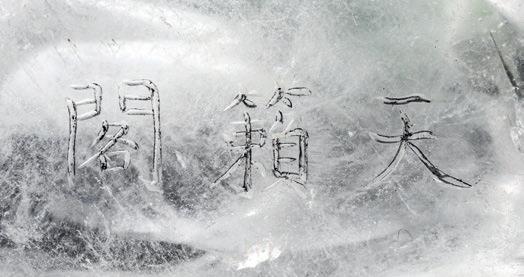
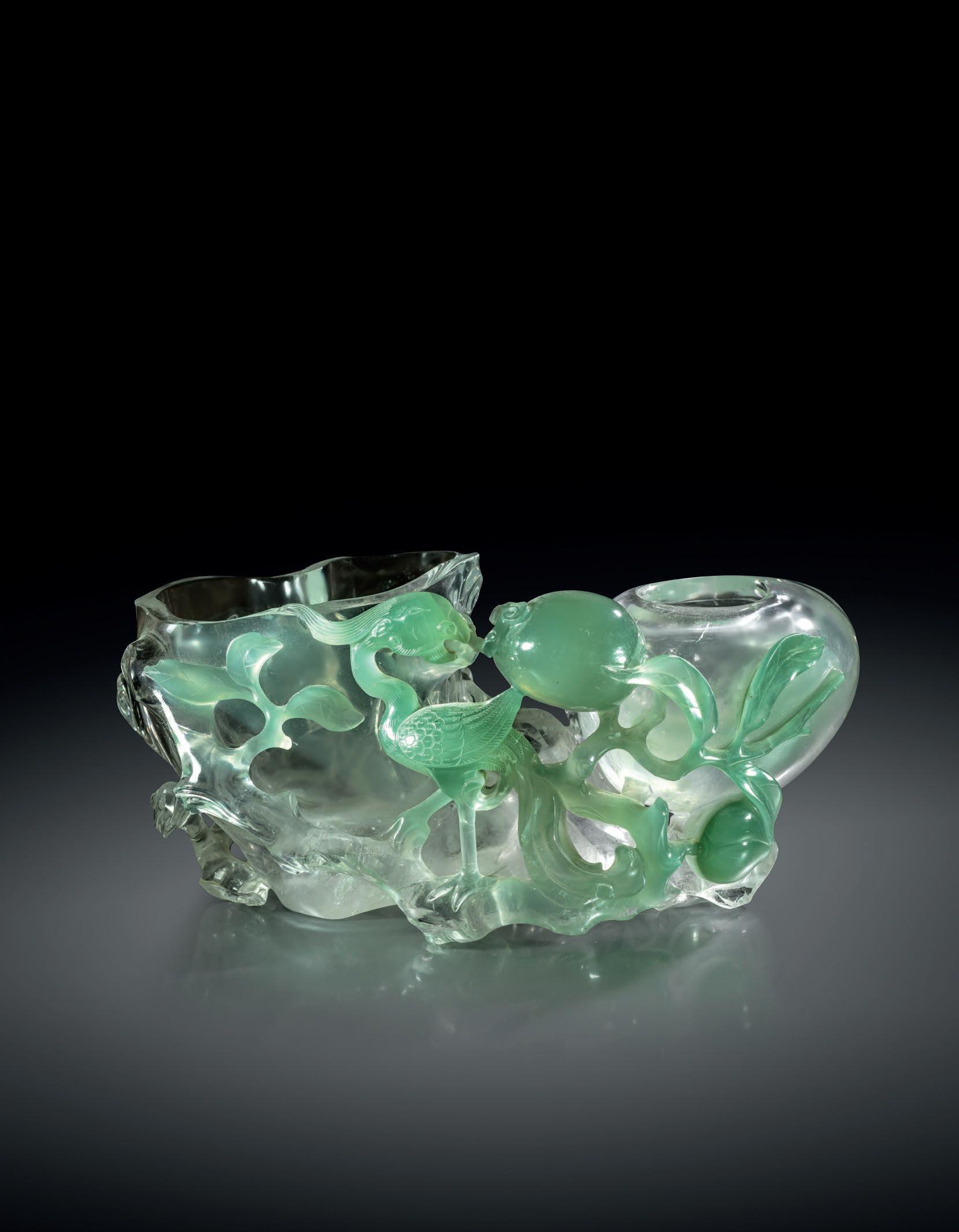
Carved as a vase in the form of a hollowed tree trunk with a ruyi-shaped waterpot to one side, decorated in relief with lingzhi and leafy pomegranate branches bearing fruits trailing over the surface, with one branch uniting the two vessels, with swirls and knots imitating a section of the tree to the base, the stone of a bluish-grey tone with some natural russet inclusions, together with a pierced wood stand similarly decorated with fungi growing amidst blossoming and fruiting pomegranate branches, 26.6cm across. (2)
Provenance: formerly the collection of Hugh S Whitaker; and then the Lawrence Collection of jades and hardstone carvings, purchased from Spink & Son prior to 1959.
Whitaker was a collector of Oriental art in the early 20th century, and many items from his collection are now in major Western museums, including the British Museum and the Victoria & Albert Museum. Whitaker is recorded in the Sparks ledger books between 1914 and 1938 as a buyer.
Chalcedony is a cryptocrystalline quartz, and has a variety of colour tones that are mainly determined by the presence of trace elements such as chromium and iron. It is treated as a ‘jade-like’ gemstone and is commonly used by Chinese craftsmen for carving because of its hardness and waxy lustre. Both pomegranate and peach are fruits that symbolically represent abundance and numerous offspring. But, while peach is an indigenous fruit of China, the pomegranate is a foreign plant introduced from Central Asia, along the Silk Road to China. The lingzhi fungus has a strong symbolism in Chinese culture, representing longevity and immortality. The combination of all these auspicious symbols suggests that the vase was probably made for a special occasion such as a birthday.
£5,000-8,000
來源:Hugh S Whitaker 舊藏,勞倫斯珍藏玉石,1958 年前購於 Spink & Son。
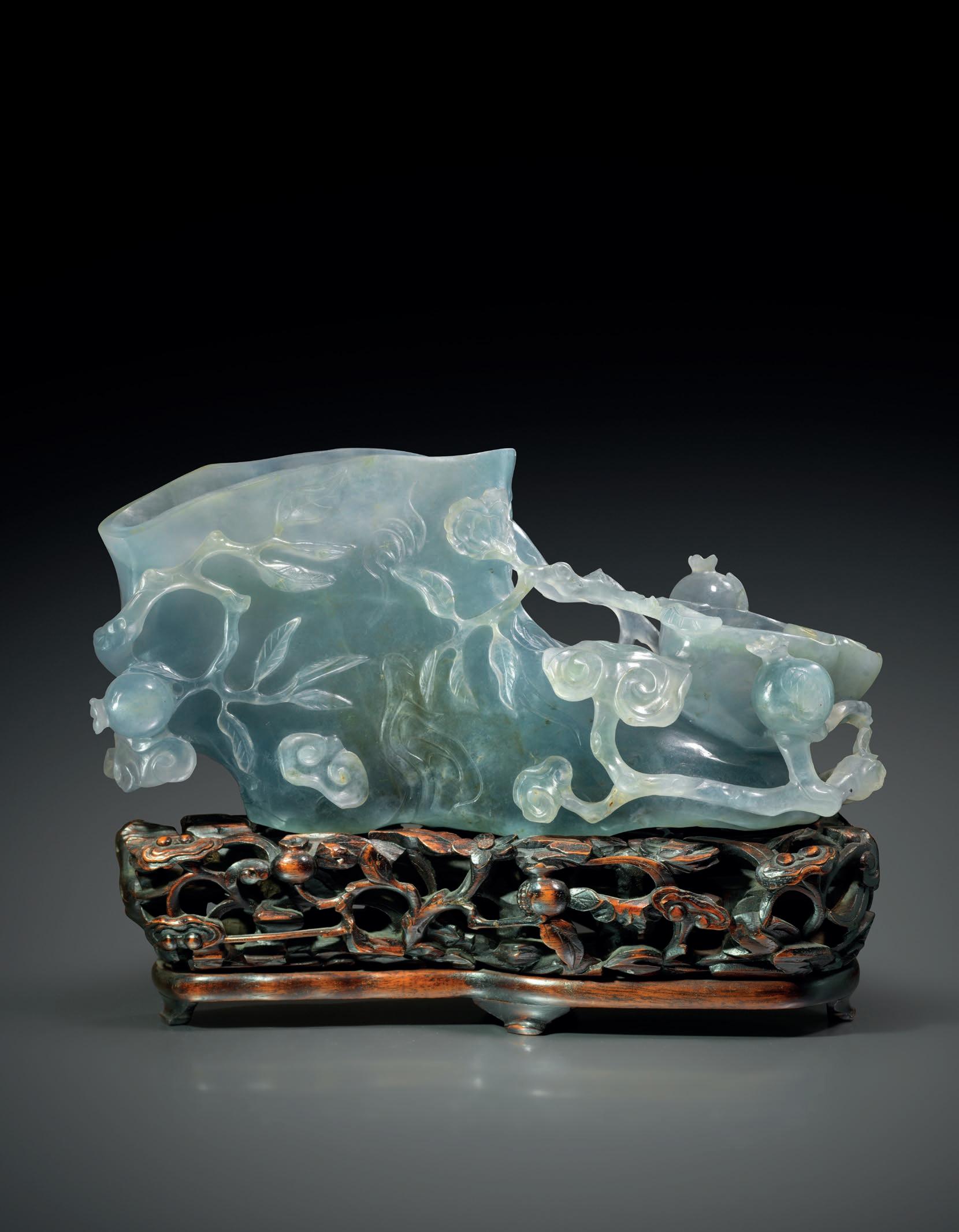
Formed as a mandarin duck standing upon a large lotus leaf finely detailed with incised veins, the aquatic bird depicted with a short crest and long wing and tail feathers, it turns its head whilst holding a reed in its beak, decorated in high relief with a shell, lotus and other plants trailing over the body of the duck, with a circular aperture to its back, the cover doubling as a water dropper, the stone cleverly worked with the duck picked out in white and the plants in dark orange, together with a wood stand carved and pierced with lotus motifs, 10.8cm. (3)
Provenance: the Lawrence Collection of jades and hardstone carvings, purchased from Spink & Son prior to 1959.
The Chinese call mandarin ducks yuanyang. The bird is a metaphor for conjugal affection and fidelity, and designs featuring mandarin ducks are commonly used at weddings. In Chinese pictorial art, mandarin ducks are frequently depicted in pairs swimming in a lotus pond. This waterpot was probably made as a desk piece, for painting and calligraphy, perhaps given as a present at a special occasion such as a wedding. This form was popular in jade carving of the early Qing period, in particular the Qianlong reign.
£5,000-8,000
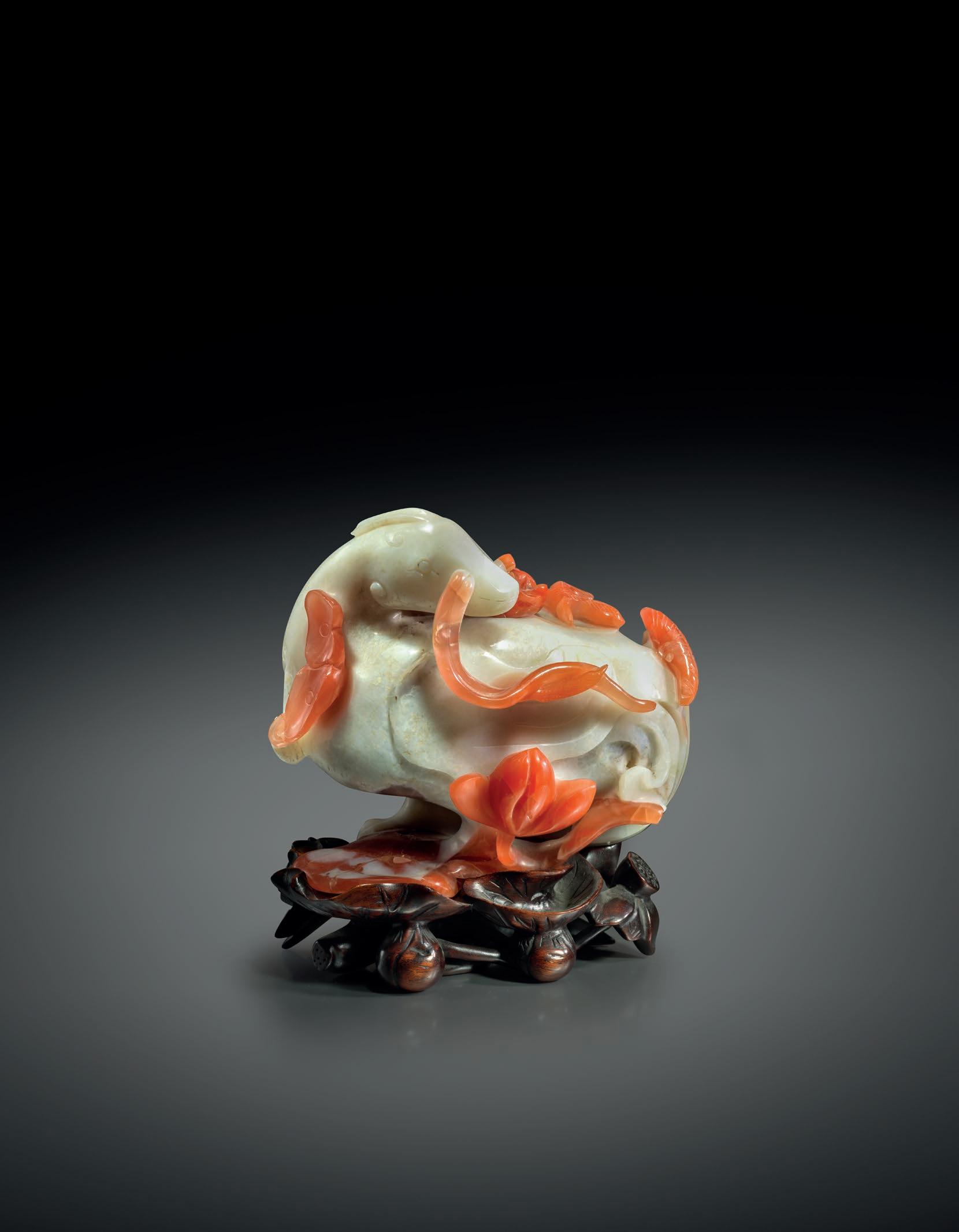
Carved in pale translucent stone as a vase and a waterpot, the vase formed as the hollowed trunk of a gnarled pine tree, with a waterpot shaped as lingzhi growing from the root of the tree, decorated in high relief to one side in a green section of the stone with a phoenix perching amidst bamboo, with pine needles and further lingzhi detailed to the reverse, the base worked to simulate tree rings, 12.7cm.
Provenance: the Lawrence Collection of jades and hardstone carvings, purchased from Spink & Son prior to 1959.
The motifs in this group are full of auspicious symbolism. The lingzhi represent longevity, whilst the pine and bamboo are emblematic of endurance and friendship. The phoenix is regarded as a sacred bird which carries various meanings, including prosperity, power, grace and virtue. The mythical bird was also adopted as a symbol of the Empress.
£4,000-6,000

Each intricately decorated in gilt with three cartouches enclosing birds perched amongst blossoming branches, the panels set against a diaper ground incorporating flowerheads and fylfots, all contained between bands of ruyi-heads and lappets, each with rich scrolls of lotus blooms amidst leafy tendrils to the interior, with continuous scrolling bands to the short flared feet, the bases with the reign marks contained in double squares and surrounded by further foliage, 9.5cm. (2)
Provenance: the Lawrence Collection of jades and hardstone carvings, purchased from Spink & Son prior to 1959.
These bowls are carved in bowenite, which is also known as ‘Suzhou jade’ as the material was traditionally mined in the Suzhou region. Some scholars believe that jade bowls with gilt decoration were influenced by Mughal jades, which were popular during the Qianlong period. Gold had previously been applied to lacquer and ceramic pieces, but the use of gilt decoration on jade objects was a new development during the Qing dynasty. The method involved mixing gold powder with special glue and then painting the gilt directly on to the jade. This was a luxury that could only be afforded by the Imperial household and the extremely wealthy and powerful. The present examples were clearly manufactured in Beijing by the Imperial workshops. Similar jade bowls with gilt decoration can be found in the collections of the Palace Museum, Beijing.
Cf. J C S Lin, The Immortal Stone: Chinese Jades from the Neolithic Period to the Twentieth Century, p.126 for a pair of larger bowls with the same decoration from the Oscar Raphael Bequest now in the collection of The Fitzwilliam Museum, Cambridge, accession nos.O.31A & B-1938; see also the Catalogue of the International Exhibition of Chinese Art, 1935-6, no.2331 for a pair of related bowls and covers decorated with dragons and described as ‘lavender jade’ from the collection of Queen Mary, Buckingham Palace.
£10,000-20,000

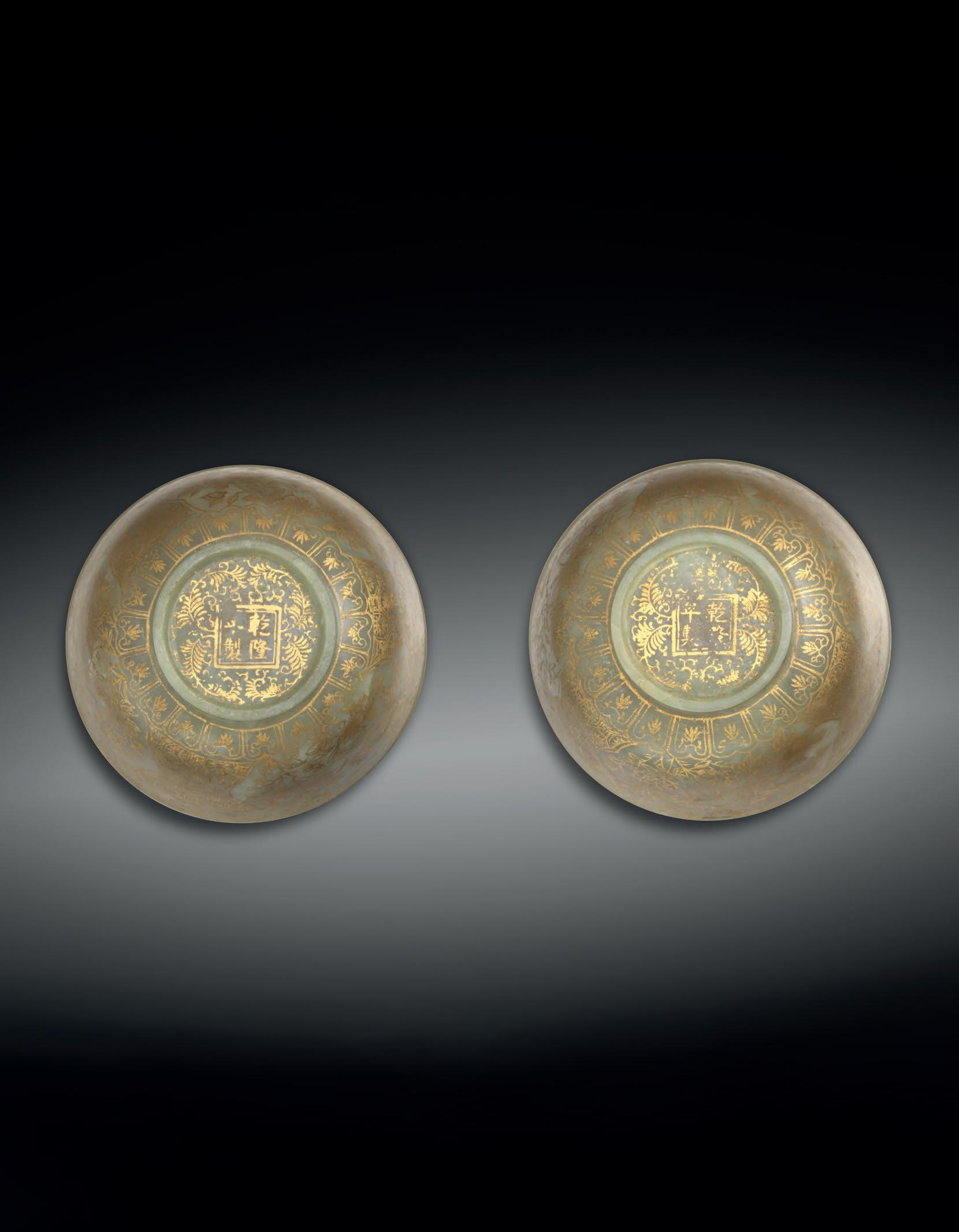
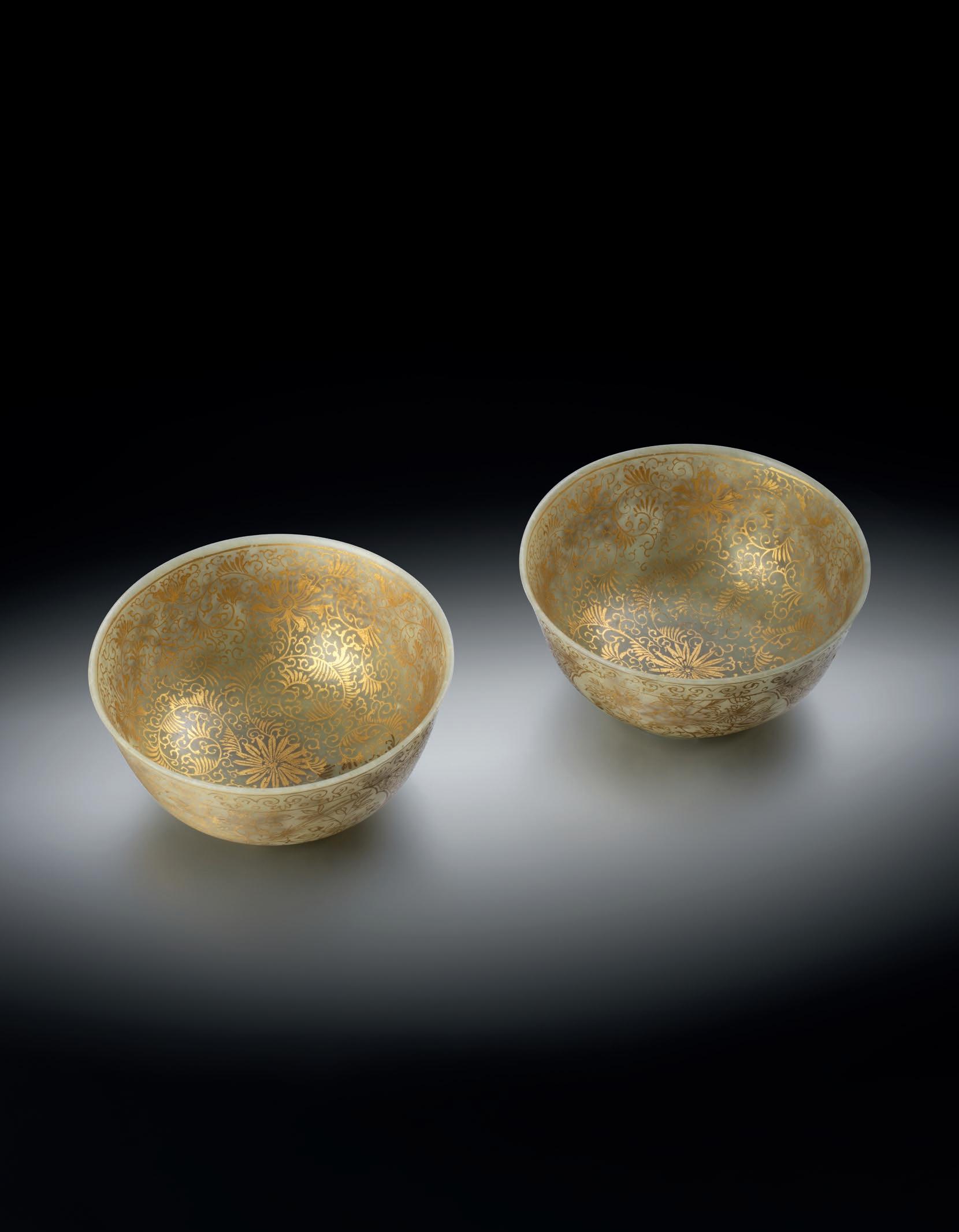
The U-shaped vessels gently flaring at the rims, each decorated in low relief with the Eight Daoist Emblems to the bowl and cover, the precious objects tied with ribbons, with finely incised bands of key fret bordering the edges, each raised on a short circular foot, the thinly-worked jade of a translucent icy-white tone, with a few minor apple-green and russet flecks in the stone, 11.2cm dia. (4)
Provenance: formerly the collection of Hugh S Whitaker; and then the Lawrence Collection of jades and hardstone carvings, purchased from Spink & Son prior to 1959.
Exhibited: Burlington Fine Arts Club, 1915, case no.2, illustrated pl.30.
Published: E Gorer & J F Blacker, Chinese Porcelain and Hardstones, London, 1911, vol.2, pl.244; also Burlington Fine Arts Club, 1915, case no.2, illustrated pl.30.
Whitaker was a collector of Oriental art in the early 20th century, and many items from his collection are now in major western museums, including the British Museum and the Victoria & Albert Museum. Whitaker is recorded in the Sparks ledger books between 1914 and 1938 as a buyer.
The Bajixiang, or Eight Daoist Emblems, are the attributes of the Eight Daoist Immortals. They consist of the sword of Lu Dongbin, the fan of Zhong Liquan, the flower basket of Lan Caihe, the lotus of He Xiangu, the flute of Han Xiangzi, the gourd of Li Tieguai, the castanets of Cao Guojiu, and the drum of Zhang Guolao. They represent difficult conditions in life: poverty, wealth, aristocracy, plebeianism, age, youth, masculinity and femininity. The eight Daoist emblems should not be confused with the eight Buddhist emblems. Although the Qing emperors were not enthusiastic Daoists, the practice of Daoism was popular in society. The Yongzheng Emperor to a degree encouraged the belief in immortality and the practice of some Daoist rituals.
Cf. Pearl of the Orient: Treasures of the Hong Kong Museum of Art, p.104, no.131 for a pair of similar bowls decorated with dragons and phoenix; see also Catalogue of a Special Exhibition of Hindustan Jade in the National Palace Museum, pp.276-277, pl.75 for another comparable pair; see also J R Finlay, The Chinese Collection: Selected Works from the Norton Museum of Art, pp.244-245, no.108 for another related bowl.
£6,000-8,000
來源:Hugh S Whitaker 舊藏,勞倫斯珍藏玉石,1958 年前購於 Spink & Son。
展覽:伯靈頓藝術俱樂部,1915 年,展櫃編號 2,圖 30。
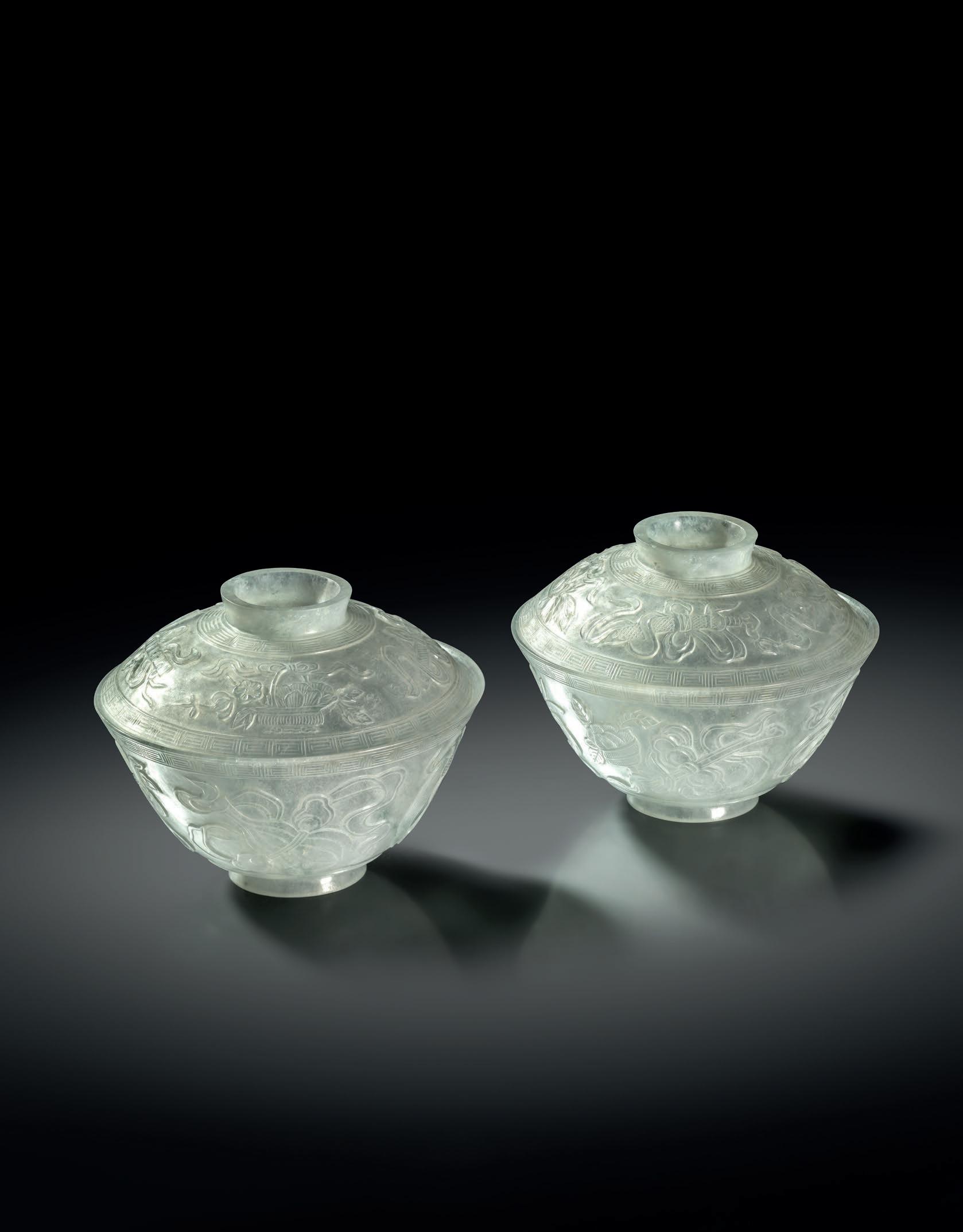

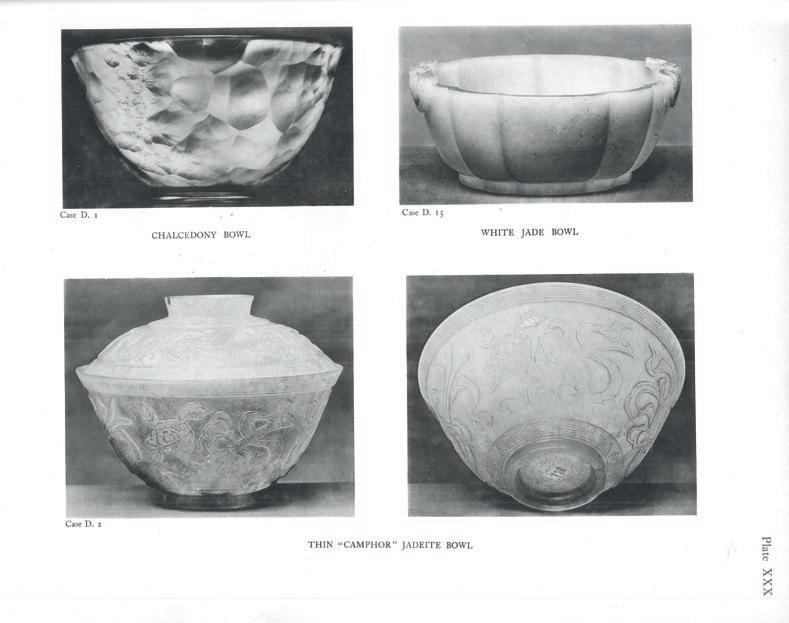


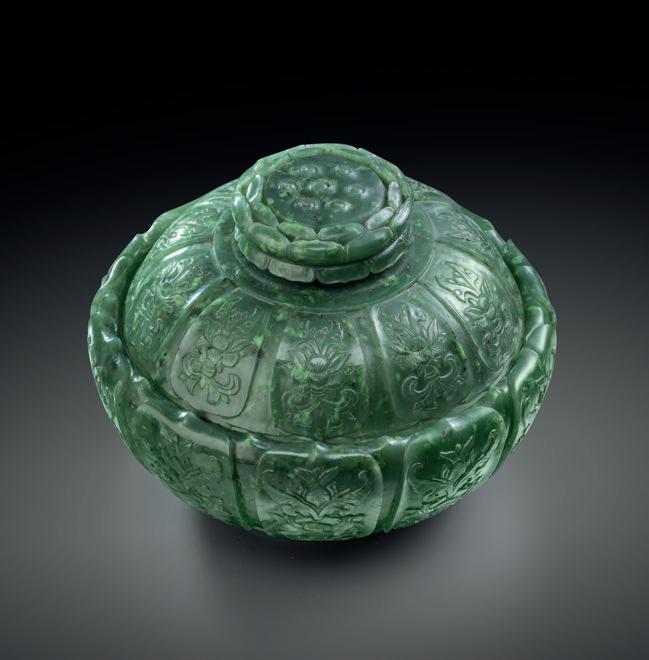
The well-rounded sides rising to an inverted mouth, worked to the exterior with ten large petals enclosing stylised lotus sprays, the tips of the petals resting on the rim, with similar decoration to the domed cover, surmounted by a finial formed as a lotus flowerhead detailed with seven seeds, all raised on a short waisted foot, the stone of a dark green tone, 13.4cm dia. (2)
Provenance: formerly the collection of Mrs Christian R Holmes; then sold at the Parke-Bernet Galleries on 16th April 1942, lot 278; and then the Lawrence Collection of jades and hardstone carvings, purchased from Roger Keverne Limited on 25th October 2007. A copy of the Roger Keverne invoice is available.
Mrs Christian R Holmes was a noted American collector and philanthropist who died in 1941.
Published: R Keverne, Winter Exhibition 2009, pp.120-121, no.104.
Cf. J Li, Chinese Jades Throughout the Ages: Connoisseurship of Chinese Jades, vol.11, pp.164-165, no.82 and vol 12, pp.178-179, no.89, and also pp.212-215, nos.106 and 107 for comparable white lotus-shaped vessels in the collection of the Palace Museum.
£20,000-30,000
10 月 25 日購於 Roger
Christian R Holmes 女士收藏,1942 年 4 月 15 日於 Parke-Bernet 畫廊售出,編號 278, Holmes 女士(逝於 1941 年),曾是美國著名收藏家及慈善家。勞倫斯珍藏玉石, 2007 年
Keverne 古董店(附發票複印件)。

With shallow bodies and low domed covers, each cover finely carved and pierced with a medallion enclosing peony blooms and buds amidst leafy branches, the sides similarly worked with many peonies set amongst trailing foliage, the slightly convex bases left undecorated, the stone of a creamy white tone with some cloudy striations, 10.2cm dia. (4)
Provenance: the Lawrence Collection of jades and hardstone carvings, purchased from Spink & Son prior to 1959.
Boxes of this type were used as incense containers. The fragrance would be released slowly through the pierced holes. Such pieces were very popular in wealthy and Imperial households, particularly in ladies’ inner chambers.
The peony is indigenous to China. Among the many different species of peony, the Chinese are particularly fond of the Paeonia suffruticosa, Chinese: mudan, also known as fugihua, which is regarded as the flower of riches and honour. In ancient times, the city of Luoyang was renowned for its peony festivals, and many famous poems have been written about the flower. The most memorable one is probably by the Tang dynasty poet Bai Juyi (772-846) who himself was a resident of Luoyang. He wrote:
“I’m saddened by the peonies before the steps, so red, As evening came I found that only two remained. Once morning’s winds have blown, they surely won’t survive, At night I gaze by lamplight, to cherish the fading red.”
In the early 20th century, the peony was crowned as China’s ‘national flower’, and there are frequent peony exhibitions and shows.
Cf. The Complete Collection of Treasures of the Palace Museum, Jadeware (III), p.53, no.42 for a related incense burner with comparable decoration.
£15,000-25,000
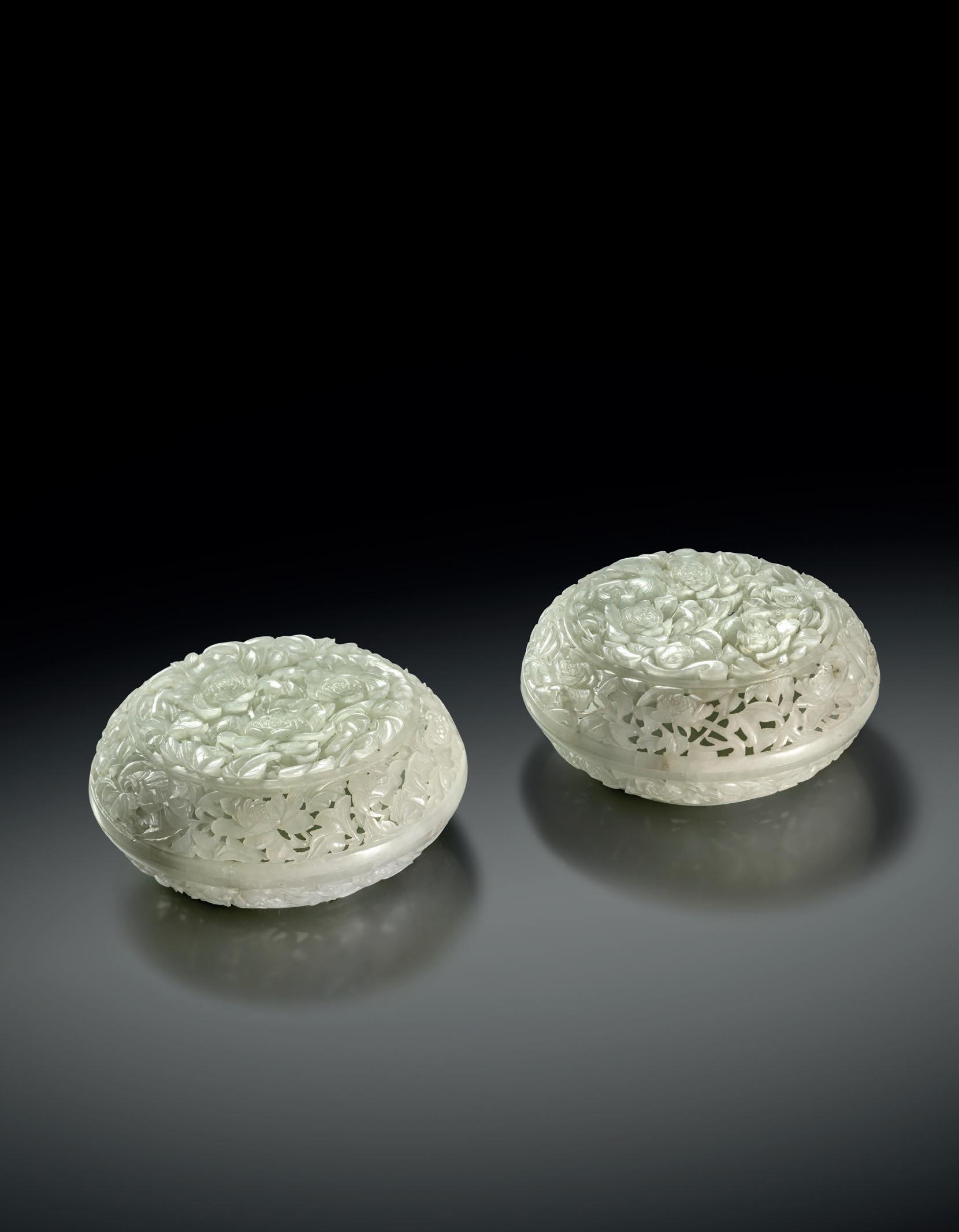
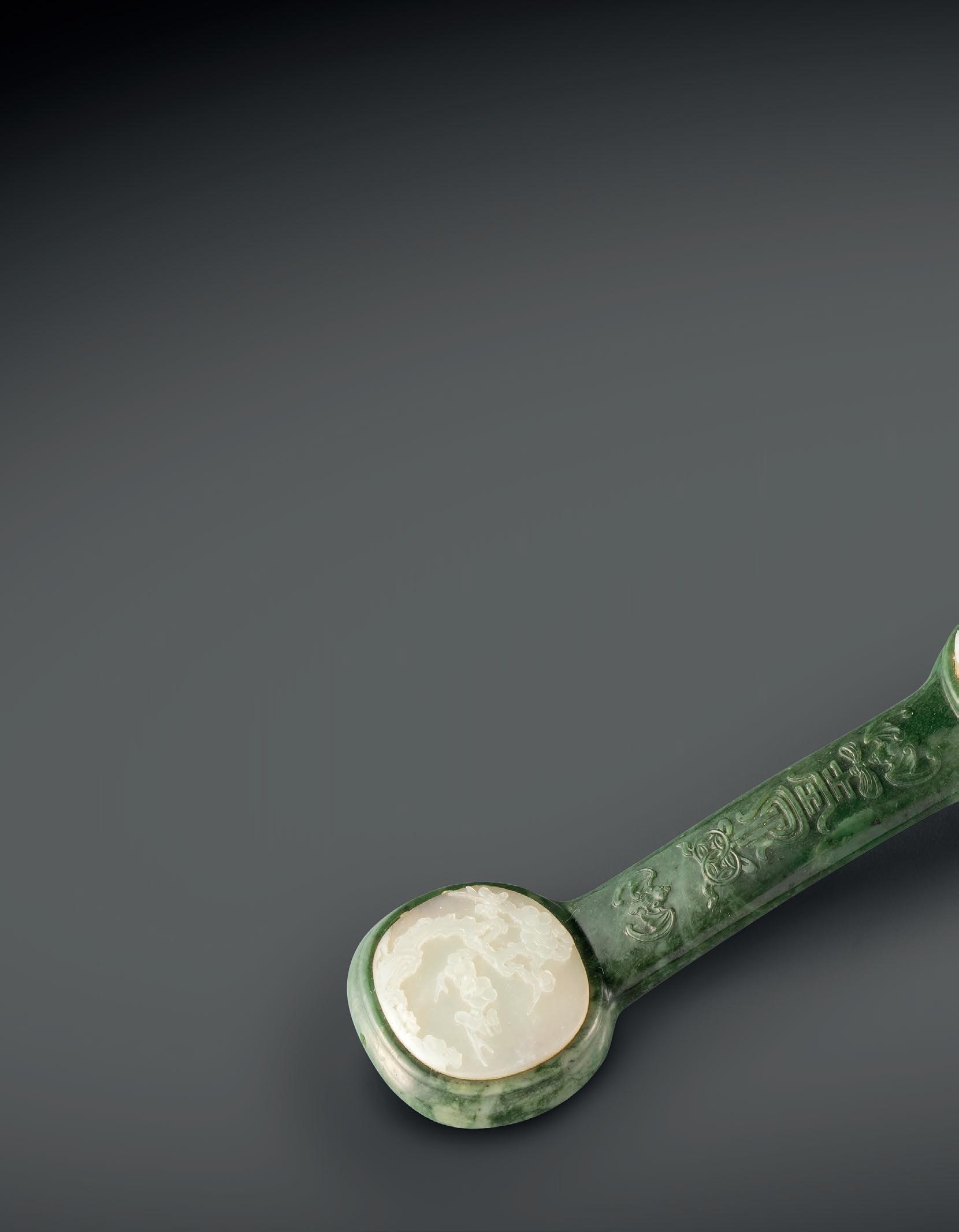
The mottled dark green sceptre inset with three oval white jade plaques to the head, stem and terminal, the largest worked in relief with two butterflies fluttering above blossoming peony and aster in a mountainous landscape, the central panel carved with a flowering chrysanthemum branch growing amidst rockwork, the smallest plaque depicting a gnarled prunus tree, with twin-fish and a small bat surrounding a fylfot and qing to the upper section of the curved stem, the lower section of the shaft decorated with a pair of bats encircling a shou character and beribboned cash, the undecorated underside with a ribbed edge, 42.5cm.
Provenance: the Lawrence Collection of jades and hardstone carvings, purchased from Spink & Son prior to 1959.
Whilst ruyi sceptres hold great significance in Chinese culture, their exact origins are unknown. It is commonly believed that the form derives from that of a lingzhi fungus, but it has also been argued that the shape developed from that of a rod used by ancient diviners, or even from a constellation. The word ruyi literally translates to ‘as you wish’, and it conveys the meaning of good wishes and blessings. Ruyi sceptres were used as ritual objects in both Buddhism and Daoism. According to an early 20th century account by Stephen W Bushell (1844-1908), these treasured objects were placed on a table before the throne in every reception room of the Emperor’s palace. Bushell also writes that ruyi sceptres were included amongst the Imperial gifts presented to dignitaries as a mark of special distinction.
Cf. The Complete Collection of Treasures of the Palace Museum, Jadeware (III), p.36, no.28 for a spinach-green jade sceptre inlaid with celadon plaques.
£30,000-40,000
來源:勞倫斯珍藏玉石,1958 年前購於 Spink & Son。
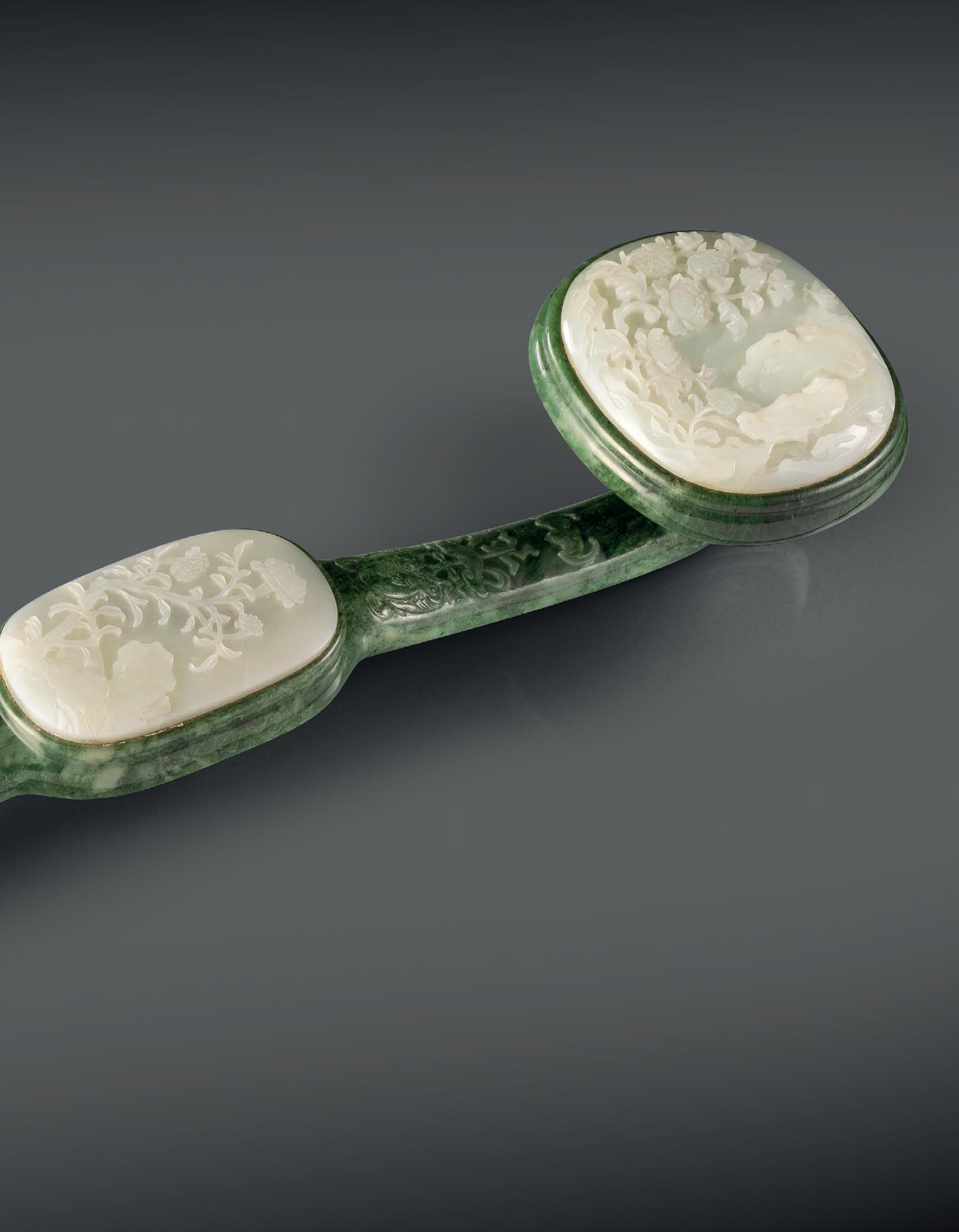

The long rectangular slab worked with curved ends, carved in relief with two scaly dragons contesting a flaming pearl, one beast emerges dramatically from crashing waves whilst the other descends from the sky above, each sinuous creature depicted with two horns and long whiskers, the pale creamy stone with a fine polish, 23.8cm.
Provenance: formerly the collection of Vice-Admiral Sir George John Scott Warrender of Lochend 7th Bt (1860-1917), who fought in the Boxer Rebellion in 1900 and when by repute acquired this jade; and then the Lawrence Collection of jades and hardstone carvings, purchased from Spink & Son prior to 1959.
The imagery of two dragons contesting a pearl is known in Chinese as er long xi zhu. An interpretation of this motif is that one dragon is male whilst the other is female, and the jewel is their egg. The symbolism is thus associated with harmony and reproduction. During the Ming and Qing dynasties, this image was frequently used as decoration on objects belonging to ladies of the court, and so it is possible this scroll weight previously belonged to an Imperial concubine.
Cf. B Bronson & C Ho, Splendors of China’s Forbidden City: The Glorious Reign of Emperor Qianlong, p.86, no.88 for a similar piece; see also The Complete Collection of Treasures of the Palace Museum, Jadeware (III), p.213, no.173 for a comparable item; see also The Complete Collection of Treasures of the Palace Museum, Jadeware (II), p.240, no.200 for another related example.
£30,000-50,000
來源:George John Scott Warrender of Lochend 上將 (1860-1917), 曾經在 1900 年參加過太平天國戰爭。

The domed cover decorated with a central medallion enclosing a coiled confronting dragon, the mythical creature writhes amidst leaves as it pursues a sacred pearl, the beast finely detailed with bulging eyes and scaly skin, with fine fluted chrysanthemum petals to the sides of the box and cover, carved to the interior and base with large stylised chrysanthemum blooms, the flowerheads worked with rows of many narrow petals radiating from the centre, the thin translucent jade of a dark green tone with some black specks, 12.1cm dia. (2)
Provenance: the Lawrence Collection of jades and hardstone carvings, purchased from Spink & Son prior to 1959.
Whilst the central decoration of the dragon in pursuit of a jewel is typically Chinese, the form of this box, with its thin wall and fine flower petals, is likely to have been influenced by Mughal jades.
Cf. F Gu, The Complete Collection of Jades Unearthed in China, vol.1, p.235 for a comparable box and cover with floral decoration to the cover which was excavated from Zhang Zhidong’s residence at Nanpi, Hebei, and is now in the collection of the Hebei Provincial Centre for Cultural Heritage Preservation.
£6,000-8,000
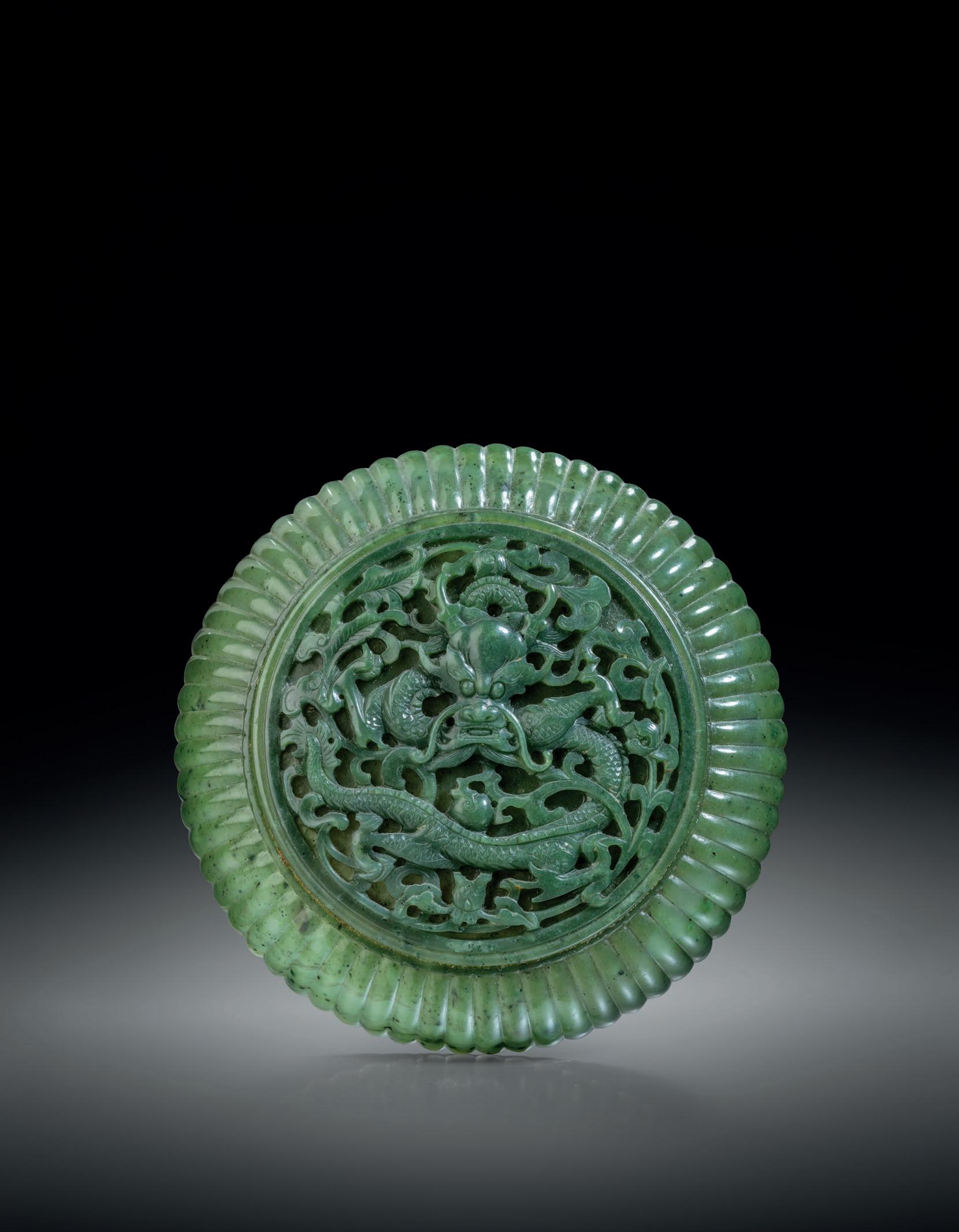

The Grand View of Chao Mountain
Sold £2,641,000 *
(*Price includes buyer’s premium)
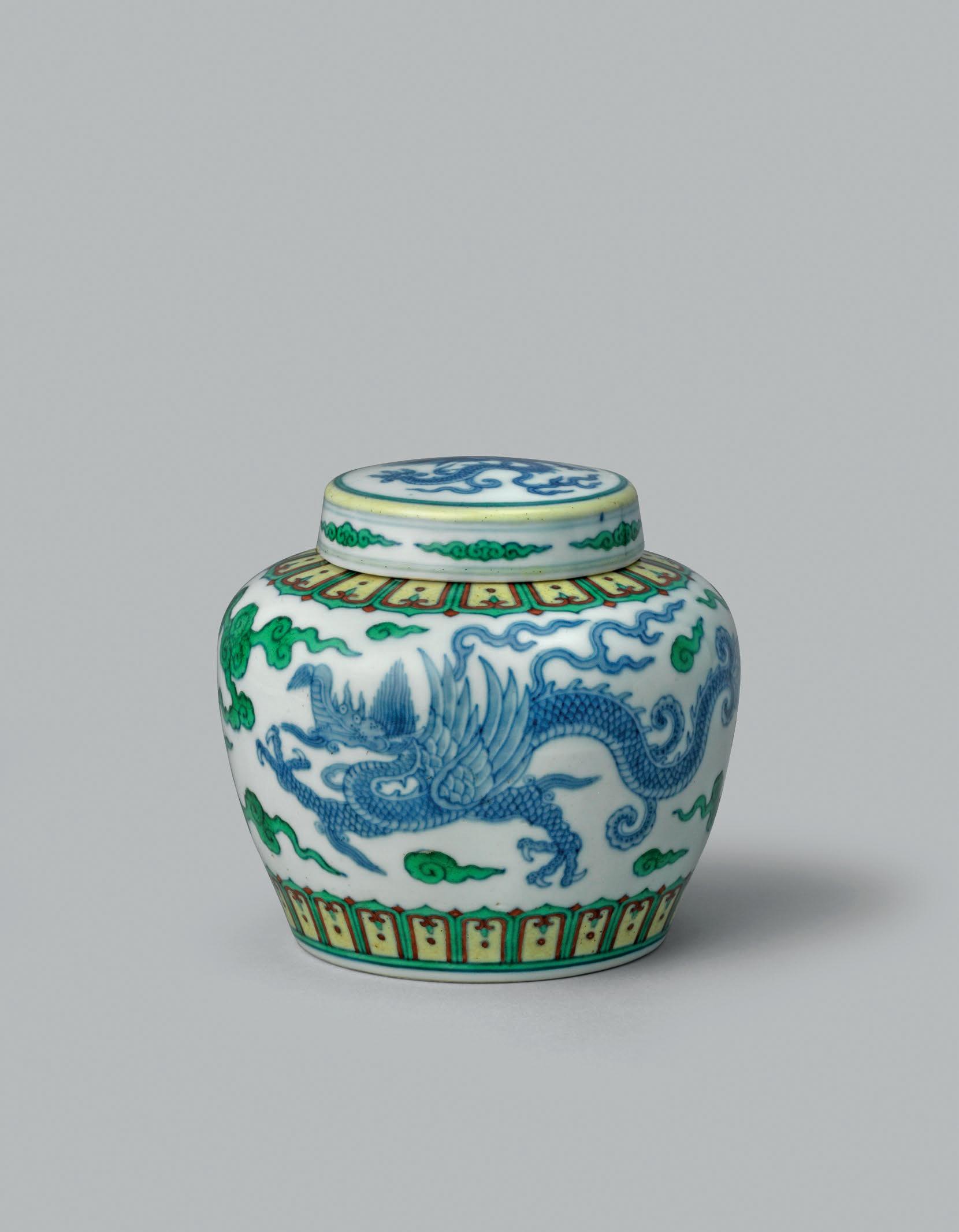
Sold £968,000 *
(*Price includes buyer’s premium)
Castle Street Salerooms
Monday to Friday 9.00am – 5.00pm
Castle Gate Offices
Monday to Friday 9.00am – 5.00pm
VIEWING
All our auctions are on view at least two days prior to the sale and details will be found in the relevant catalogues.
All first time buyers need to register with us.
To register, you will need to provide two forms of identification:
1. a passport or photographic driving licence
2. a utility bill or document showing your name and address
You can register in person or by contacting the office on +44 (0)1722 424500 or emailing enquiries@woolleyandwallis.co.uk
You will be asked to show your documents, or email copies.
PLEASE NOTE: Registering with thesaleroom.com or through our website does not automatically register you with us.
See below for the different options for bidding. Please note that you may be asked to provide two forms of identification, even if you have bid with us before, in order that we are compliant with Money Laundering Regulations.
To bid at auction you will need a paddle number. This can be obtained from the office either during the view or on the day of the sale.
If you are unable to attend the sale you can leave a commission bid. This will be executed on your behalf by the auctioneer who will purchase the lot as cheaply as possible bearing in mind any reserve price and other bids.
It is usually possible to bid on the telephone by prior arrangement with the office.
Live online bidding is now available free of charge for most of our auctions via bid.woolleyandwallis.co.uk, enabling you to take part in the bidding from anywhere in the world live as it happens.
The Buyer shall pay the hammer price together with a premium thereon of 26% plus VAT @20% (totalling 31.2% inclusive) on the first £500,000 and 20% plus VAT @20% (24% inclusive) thereafter.
The relevant department will be pleased to give condition reports on any lot, where practical. All weights and measures given in the catalogue should be regarded as approximate. The colours printed in the catalogue are not necessarily true.
These will be posted on our website shortly after the sale.
Woolley & Wallis do not offer a packing and despatch service but the following are carriers in our area.
Alban Shipping +44 (0)1582 493099 info@albanshipping.co.uk www.albanshipping.co.uk
Kimdan Ltd +44 (0)7973 389436 andy@kimdan.co.uk
Mailboxes +44 (0)1962 622133 mbewinchester@btconnect.com www.mbe.co.uk/winchester
Pack & Send +44 (0)1635 887237 newbury@packsend.co.uk
www.packsend.co.uk/newbury
ZIXIS Fine Art Limited +44 (0)7873 981026 zixisfineart@163.com www.zixisfineart.co.uk
Please note that we cannot be held responsible for any damage or loss to items once they are in the hands of a carrier.
If you are exporting your property, import taxes, customs duties and other fees may apply at the country of destination. It is also your responsibility to ensure that your shipment can be lawfully imported to the destination country.
Please note that due to the withdrawal of the Retail Export Scheme by HMRC, we are unable to provide VAT refund documentation (C88) for hand-carried exports.
In order to qualify for a VAT refund, your lots must be exported by a shipper and valid export documentation must be provided.
Payment is due immediately after the auction in pounds sterling. If you are a first time buyer we will need your name, address and bank details and will require funds to be cleared before purchases can be released.
The following methods of payment may be made:
Bankers draft, cashiers cheque, personal cheque, travellers cheques, debit and credit cards and cash up to a sterling equivalent of €10,000. We are no longer able to accept card payments of over £1,000 where the card-holder is not present. Wire transfers should be sent to:
Lloyds Bank plc, Blue Boar Row, Salisbury SP1 1DB.
Account no. 00957707
Sort code 30-97-41
IBAN no. GB20LOYD30974100957707
BIC code LOYDGB21063
Debit and Credit cards: Visa, Mastercard, Amex or Union Pay
Where practical, payment can be made and purchases collected during the auction.
We reserve the right to add storage charges to all lots not collected within 30 calendar days of the sale. This will include a handling fee of £20 (+ VAT) per consignment and a storage charge of £2 (+ VAT) per lot per day. No goods will be allowed to be collected until these charges have been paid.
Lots marked with a dagger (†) are subject to VAT on the hammer price. Lots marked with an omega (Ω) have been temporarily imported from outside the EU and are subject to VAT at 5% on the hammer price and the buyer’s premium. In online catalogues, the Sales Tax % column indicates the rate of VAT on hammer price.
Please note that lots marked λ may be subject to CITES Regulations when exported.
The CITES Regulations may be found at www.defra.gov.uk/ahvla-en/imports-exports/cites/
Lots marked with a Φ symbol are potentially subject to a levy. Droit de Suite is a royalty payable to a qualifying artist or the artist’s heirs each time a work is resold during the artist’s lifetime and up to a period of 70 years after the artist’s death.
Royalties are calculated on a sliding percentage scale based on the hammer price excluding the buyer’s premium. The royalty does not apply to lots selling below the sterling equivalent of €1,000 and the maximum royalty payable on any single lot is the sterling equivalent of €10,000.
Droit de Suite, which is not subject to VAT, will be added to the buyer’s purchase price and then passed on to the relevant collecting agency.
Please enquire for the accepted exchange rate on the day of the sale.
Royalties for Droit de Suite are as follows:
4% Up to €50,000
3% €50,000.01 - 200,000
1% €200,000.01 - 350,000
0.5% €350,000.01 - 500,000
0.25% In excess of €500,000
Up to a maximum levy of €10,000
Lots marked Ƒ in the catalogue, or by any other means identified as controlled firearms, are subject to the UK firearms/shotgun licencing regime, and should only be viewed/ purchased by individuals with appropriate licences. It is the responsibility of the bidders to ensure that they are legally authorised to acquire the lot that they are bidding for. In the event that such a lot is successfully bid for by an individual who is not authorised to possess it, that individual will be required to pay for it, but are not allowed to take physical possession of it. The auctioneers will reoffer the lot on behalf of the buyer in a future auction; or may accept instructions to dispose of it by some other legal means, at their discretion.
營業時間:
週一至週五9:00-17:00
拍賣前預展: 本公司所有拍賣預展都會在正式拍賣的前兩天舉 行,詳細資訊請查閱相關拍賣圖錄。
登記競投:
競買人應在拍賣日前於公司前臺接待處申領競投號 牌。本公司現提供永久競投號牌,競買人登記後可 在未來的拍賣中使用。
登記時,您需要出示身份證、護照(如果有)和 地址證明(有注明住址的水電煤帳單或駕駛證) ,或者將以上資料以郵件的形式發送至enquiries@ woolleyandwallis.co.uk
委託競投: 不能出席拍賣的競買人可通過書面形式委託本公司 代為競投,工作人員將參考底價,盡力以最低價進 行競投。
電話競投:
委託人可在拍賣會進行時通過電話競投,該項服務 須在拍賣會開始前與本公司前臺接待處預約。
威立士網上競投:
本公司提供免費網上即時競投,請登錄bid. woolleyandwallis.co.uk登記競投賬戶。
付款可以通過以下方式:
銀行匯票、現金匯票、個人支票、旅遊支票、信用 卡、銀行借記卡和不超過相當於€10,000的現金。
如果持卡人不在現場,本公司將不能收取超過 £1,000的引用卡付款。
本公司電匯資訊:
Lloyds Bank plc, Blue Boar Row, Salisbury SP1 1DB.
Account no. 00957707
Sort code 30-97-41
IBAN no. GB20LOYD30974100957707
BIC code LOYDGB21063
信用卡:VISA或者MASTERCARD會有2%的手續費 和增值稅(VAT)
借記卡:Visa, Mastercard, Amex or Union Pay 付款和取貨都可以在拍賣現場進行。
傢具和鐘錶類的拍品通常會在拍賣結束後留在拍賣 現場三個工作日,然後轉移至倉庫。請買家取貨時 請務必提前和本公司預約。
拍賣結束三十天后開始徵收存放費用,費用包括: 保管費:每件拍品£20(+增值稅VAT) 存放費:每天每件拍品£2 (+增值稅 VAT) 以上所有費用全部結清才能取貨。
增值稅VAT:
帶有星號(†)的拍品需要在落錘價上徵收增值 稅。帶有希臘字母(Ω)的拍品表示從歐洲以外的 國家進口,並且在落錘和買家支付之傭金上收取5% 的增值稅。在本公司網上圖錄‘the Sales Tax %’ 一欄顯示的是在落錘價上徵收的增值稅比例。
拍品情況報告:
本公司會提供有關拍品的品相報告,所有拍品的尺 寸或重量可以在相關圖錄裏瞭解。
注:所有測量數據視為近似值,因印刷或攝影造成 圖錄作品的色調、顏色等與原物有誤差者,以原物 為准。
成交價:
所有拍品的成交價會在拍賣會結束後在本公司網站 上公佈。
付款:
競買成功後,所有拍品的購買款項應以英鎊支付, 本公司收到款項後方可領取拍品。第一次在威立士 拍賣行交易的買家需提供姓名、地址和銀行資訊。
如果您要將拍品運出英國,請留意在目的地國家可 能需要支付進口稅、關稅和其他費用,賣家需承擔 確保貨物可以合法進口到目的地的責任。
注:由於英國稅務海關總署(HMRC)已撤銷零 售出口法案(Retail Export Scheme),本公司將 無法提供手持出口增值稅退稅文件(C88)機場退 稅單。
若您慾退增值稅,您的拍品必須由貨運公司運送, 並且必須由運輸公司提供有效的出口文件。
瀕危野生動植物種國際貿易公約 (CITES)
標註λ的拍品在從英國出口之前需要查詢其進口 地的進出口條例,詳細信息請登錄網站查詢www. ukcites.gov.uk
藝術家的追續權:
追續權是付給藝術家的專利稅。如果藝術家還在世 或者去世以後的70年內,那麼每次出售和轉售都要 付給該藝術家或者其繼承人專利稅。追續權不是增 收稅,會加在競買人購買價格之上,然後轉給相關 仲介機構。
專利稅是在落錘價錢(不包括買家支付之傭金)上 以百分率的方式徵收。€1,000以下的拍品不收取專 利稅,每個拍品的專利稅最高可以收取€10,000.
請詢問拍賣當天的英鎊匯率。
追續權的專利稅百分比率請參照下表:
4% €50,000以下
3% €50,000.01 – 200,000
1% €200,000.01 – 350,000
0.5% €350,000.01 – 500,000
0.25% €500,000以上
最高的專利稅可以收取€10,000. 帶有‡符號的拍品需要在成交價上收取專利稅。
包裝和運送: 威立士拍賣行不提供包裝和運送的服務。以下是在 本公司周邊的運送公司及其聯繫方式:
Alban Shipping +44 (0)1582 493099 info@albanshipping.co.uk www.albanshipping.co.uk
Kimdan Ltd +44 (0)7973 389436 andy@kimdan.co.uk
Mailboxes +44 (0)1962 622133 mbewinchester@btconnect.com www.mbe.co.uk/winchester
Pack & Send +44 (0)1635 887237 newbury@packsend.co.uk www.packsend.co.uk/newbury
ZIXIS Fine Art Limited +44 (0)7873 981026 zixisfineart@163.com www.zixisfineart.co.uk
若拍品已轉交運輸公司,任何丟失及損壞威立士將 不承擔一切責任
**注:本須知如有任何詮釋上的問題,一概以英文 版本爲準。
競買人須知
1. 簡介:本規則適用於本公司的買家,特別是對 於新加入拍賣的競買人。所有拍賣品的資訊和 估價都可以在相關拍賣圖錄中翻閱。如果您有 任何疑問,本公司的工作人員將非常樂意為您 服務。本中文條款如有任何詮釋上的問題,一 概以英語版本爲準。
2. 仲介:作為拍賣行,本公司通常以代理買方的 身份簽署合同。爲了保護客戶隱私權,本公司 不會公開競買人的資訊。
3. 估價:估價是爲了提供競買人一個大概的價格 浮動範圍。所有提供的拍賣品均設有賣家所定 的保密的最低價,拍品不會以低於此價出售。 圖錄上較低的估價價格即可能是該拍賣品的底 價。估價不包括競買人支付的傭金和VAT增值 稅。估價會在拍賣之前提供給競買人。
4. 買入價格:競買人需要府成交價和佣金(每 件拍品的成交價低於£500,000 取26%,超過 £500,000 部分取 20%)+ VAT增值稅。
5. VAT增值稅:買家須以有關法律所規定的稅率 及時間繳付增值稅。增值稅會在成交價和傭金 之上收取。帶有星號(*)的拍品是從歐盟國 家進口的,將徵收20%進口VAT增值稅。帶有 雙星符號(**)的拍品是從歐盟以外的國家進 口的,當下的VAT增值稅為5%。如果沒有以上 敘述的兩種符號,該拍品就不需要徵收VAT增 值稅。
6. 威立士拍賣行:本公司是賣家的仲介,所有拍 品的資訊均源自於賣家,同時也會檢查拍品的 情況。本公司在關於拍品的目錄、品相報告和 另外口頭與書面的所有陳述,均只屬於意見的 表述,而不應依據為事實的陳述。目錄和品相 報告中所提及的有關瑕疵和未經修復的敘述只 作為對該拍品的參考,不應被依據為拍品的真 實狀況。所以競買人在拍賣前仔細檢查拍品情 況是一個明智的選擇。但如果發現拍品存在‘ 蓄意偽造’的情況,在三個星期內可能可以被 退還。(蓄意偽造的詳細解釋可以在本公司的 拍賣條款裏查閱)
7. 電器拍品:所有電器拍品都以古董的形式進行 拍賣,如果是用於日常使用請在拍賣之前與專 業電器公司確認其安全性。
8. 出口拍品:買家如果想要出口競拍所得物品需 要查明:a)是否需要出口許可證。b)要攜帶 入境的國家是否對該類拍品有禁令。比如說, 可能會禁止攜帶象牙。如有需要請詢問本公司 前臺服務。但上述的兩種情況都不作為取消交 易和推遲付款的原因。
9. 競投:競買人需要在拍賣前進行註冊,登記時 需要提供姓名,位址。新客戶需要向本公司提 供身份證明。如需要電話競投服務,請儘早與 本公司進行登記。
10. 競投委託:該項服務是以書面的形式委託威立 士在不超過其指定金額下競投拍賣品。工作人 員將參考底價,盡力以最低價進行競投,如果 威立士收到兩個或以上相同價格的書面競投, 則以最先與本公司簽訂委託競投協定者為成功 競投者。
11. 付款方式:按照規定,成交拍品需要付清所有 遺留款項以後才能取貨。關於付款方式請提前 與本公司前臺聯系。
12. 取貨和存儲:請查閱本公司拍賣條款裏關於取 貨和儲存的有關信息。所有推遲提取的拍品都 會徵收相應的存儲費用。
1. 解釋:下文中用到‘您’代表賣家或仲介機 構,同樣‘我們’代表拍賣行。
2. 傭金:拍品成交價在£999 內收取15%的傭金 +VAT增值稅,超過£1,000 拍品需要徵收10% 的傭金+VAT。
3. 運輸費:所有拍品務必要在截止日期前送達我 們拍賣行,且所有費用將由您來承擔。我們可 以在運送過程中幫助您但是本公司不承擔運輸 中發生任何狀況的責任。
4. 丟失和損傷保險:我們沒有為客戶準備FSA的 保險,但本公司用拍品的最低估價作為保護承 擔責任賠償。我們會收取成交價的1.5%作為責 任賠償的保險費用,如果您的拍品沒有成交那 麼我們會以估價的中間值為標準收取費用。如 果您不需要這項服務,那麼您將承擔丟失和損 傷的風險,直到買家取走該拍品。
5. 插圖:插圖的費用由您來承擔。若我們覺得拍 品需要插圖會尋求您的允許,我們會事先通知 您。但所有圖像和文字說明的版權都屬本公司 所有。
6. 底價和我們的判斷:在拍賣會開始之前我們會 和您關於拍品的預訂價達成共識。
7. 我們可以賣出低於拍品預訂價,但我們會支付 您該拍品的保留價。但如果您給予本公司‘裁 決’的權利,我們會同意以低於預訂價10%的 價格出售。
保留價:
(a) 敬請您務必在拍賣前提供給我們您需要的 保留價。保留價必須是我們認為合理的成 交價格,本公司有權利下降不合理的高保 留價。
(b) 保留價確定之後不能被改動。
(c) 保留價被確定以後,您不能自己進行競 投。
8. 電器拍品:這些拍品需要詳細的安全證明和防 火安全證明。若發現拍品有安全隱患,該拍品 將不被進行競投,我們有權要求您取走該拍 品。
9. 室內裝飾品:室內裝飾品如果發現有防火 安全隱患,根據Provisions of The Torts (Interference with Goods) Act 1997, Schedule 1 條例,我們有權要求您取走該拍 品。
10. 拍品描述:請告知我們正確的拍品資訊,包括 拍品來源等等。對於拍品的描述的正確性有嚴 格的責任賠償,且在很多情況下您將承擔該責 任。如果您沒有反對我們對您的拍品描述,我 們將假定您同意您已認可。若競買人發現拍品 描述和實際拍品不符我們將退還買家所付金 額。我們必須引提醒您,即使您確實不知道拍 品描述和實際不相符也必須遵循該條例。
11. 未成交的物品:如果拍品沒有成交,可以在您 的允許下在下一次拍賣中再次進行競投。如果 我們認為該拍品無法賣出,請您務必儘快從本 公司提貨,因為我們有權向您徵收倉庫儲存 費。
12. 撤拍和買入的物品:撤拍或自行買入的拍品若 已列入圖錄或已經開始印刷,則應支付保留價 或者圖錄中最低估價的10%的傭金加上VAT增 值稅。
13. 拍賣條例:您所有同意的物品將根據拍賣條例 進行出售,您或者仲介有權出售該物品。如違 反該條例您將承擔我們、買家和第三方的所有 損失和賠償。
14. 扣除賣家傭金和費用以及保留買家傭金和利息 的權利:
(a) 您可以授權要求我們取消傭金和所有相關 費用,但是我們有權利保留買家所支付的 傭金和相關費用所產生的利息。
(b) 您可以授權我們在拍賣結束印業當天進行 私下協議出售沒有成交的拍品,但我們可 以收取和拍賣成交時同樣的傭金和費用。
15. 存儲:我們對任何不能馬上上拍的物品不負 責,且我們有權收取每天£2 儲存費。如果三 個星期以後還是沒有前來領取,我們有權利出 售該物品並收取相關費用。
16. 結算:通常拍賣結束以後28天內可以完成款項 結算,除非買家未付款。
拍賣條例 威立士索爾茲伯裏拍賣有限公司是與競買人、賣家 和在拍賣現場的人進行業務運作。拍賣條例可以從 這裡參考查閱。
1. 定義 :
a) ‘拍賣官’代表威立士索爾茲伯裏拍賣公司 或他授權的拍賣官。
b) ‘蓄意偽造’是指一件仿品試圖偽造原創作 者、時期、年紀、年代、文化或來源於圖錄 中描述的不同,而在拍賣當天拍出了與該仿 品的本身價值不符的價格。
c) ‘成交(落錘)價’是指競拍價格超過了保 留價,而拍賣師落錘成交的價格。
d) ‘委託條款’是指威立士拍賣行規定的賣家 或仲介的條約和傭金的百分比率。
e) ‘總額’是指成交價、買家傭金,VAT增值稅 和其他費用加起來買家付款的總和。
f) ‘銷售收益’指賣家的淨收益,成交價減去 賣家傭金、VAT增值稅和其他費用的餘額。
g) ‘你,你們’等等指買家請參考條例第二 條。
2. 拍賣過程和買家:
a) 競買人在競投之前,必須填妥及簽注登記表 格才能參加本公司拍賣。
b) 在拍賣官的決定下,競買人出價最高且被拍 賣官接受的競買人才能成為該物品的買家。 下錘則表示賣家和買家之間的拍賣合約已經 達成。
c) 競買人會被我們視作委託人。我們有權利為 賣家競投到其設定的保留價,且有權利拒絕 任何競投。
3. 加價:拍賣官有權自行決定加價幅度
4. 買入價格:競買人需要府成交價和佣金(每 件拍品的成交價低於£500,000 取26%,超過 £500,000 部分取 20%)+ VAT增值稅。
5. 增值稅:根據法律規定,買家所有成交的拍品 的成交價上要支付VAT增值稅。(具體信息請 查閱買家須知的增值稅部份)
6. 付款:拍下拍品以後:
i) 如果需要請提供我們您的身份證明
ii) 以英鎊為貨幣形式付款
b) 買家需要付清我們計算出的應付金額,包括以 您或您仲介名義下的所有款項。
7. 所有權和領取已購買物品:
a) 物品的所有權只有在您付清全部應付金額之 後才能被轉移。
b) 您需要在拍賣結束後三個工作日付清金額, 且取走物品以後所發生的所有責任都由您來 擔當。
c) 在付款之前,任何物品不能被提取。
8. 不付款或未領取已購買拍品的提醒:
a) 如果有買家沒有全部付清應付金額,根據條 例我們作為賣家仲介和拍賣行可以執行以下 權利和提醒:
i) 對您的違約進行法律訴訟程式。
ii) 撤回您從本公司競投的所有成交拍品
iii) 如果重新賣出拍品(通過拍賣或私人交涉成 交),您就要承擔所有重新拍賣所造成的任 何高於您的成交價的部份歸賣家所有。
iv) 您拍品的運送、存放和投保的費用都由您承 擔,至於存放地點可以在我們的儲藏室或者 其他地方。
v) 如果沒有在拍賣結束後三個工作日內付款, 我們將以每個月1.5%的比率收取利息。
vi) 直到您付清所有的應付金額,我們才能取消 利息的收取。
vii) 在今後的任何拍賣中,不接受您做出的競 投,或在接受任競投之前加一些必要條件。
viii) 申請出售任何其他拍品的收益,或在將來您 在結算的時候,可以行使留置權。
1b) 我們作為賣家的仲介和拍賣行,我們執行以上 的權利和提醒是爲了做出合理的補償。
9. 第三方責任:所有現場的公眾人員都必須注意 現場的安排和安全隱患。拍賣官、我們的員工 和都不對任何的死亡和人員傷亡負責(除法律 認定是我們的疏忽外)。
10. 委託拍賣:雖然我們建議買家參加拍賣現場對 所有競投負責,但如果需要我們可以為買家進 行競投。工作人員將參考底價,盡力以最低價 進行競投。如果威立士收到兩個或以上相同價 格的書面競投,則以最先與本公司簽訂委託競 投協定者為成功競投者。
11. 所有權保證和有效性:賣家向拍賣行和您保 證,物品的所有權和出處是該買家,且物品不 受任何第三方索賠。
12. 仲介:拍賣行通常作為仲介不履行任何買家和 賣家的義務。
13. 銷售條例:買家將在委託拍賣之時起承認履行 所有委託條款。
14. 描述和條例:
a) 在我們尋找對拍品正確的描述的時候,可能不 能對每個拍品都做到最詳盡的調查。在拍賣開 始之前競買人和他們的鑒定師會被給予對每件
拍品充分查看和調查的機會。競買人將會對我 們的描述有不同的見解。我們承諾,任何此類 意見會被相當誠實合理的接受。
b) 在這些條件下的成交的私人財產轉讓根據消費 者權益法視為交易。
15. 偽造者:儘管有之前的條件,但任何拍品被證 明是蓄意偽造,或可以在拍賣結束後21 以內 原封不動的與相關證明材料一起歸還於我們。 如果我們認可您提供的資料證據可以證明該拍 品存在蓄意偽造的事實,我們將退還您所付的 傭金和成交價。但是如果1 從成交日起,眾學
者和鑒定專家都認可圖錄中的描述。或者2 您 個人無法提供一個更好的解釋給我們,那麼根 據條例您就沒有權利要求我們退還拍品。
常規信息
16. 我們有絕對權利拒絕任何人士進入拍賣場地進 行拍賣。
17. (a) 所有損壞賠償責任和毀約所帶來的費用都 應該酌情賠償給賣家和拍賣行。
(b) 這種權利可以由拍賣行和其員工或賣家強 制執行。
18. 任何對買家、賣家、競買人和觀展人的通知都 會都以第一類郵件的方式在48 時內寄到其提 供給我們的地址。
19. 圖錄描述中出現的特殊名詞都會在術語表中做 詳細解釋。
20. 任何沒有節制的拖延或延長競投時間的買主或 賣主我們會合情做出一定的讓步。
21. 英國法律可以用於解釋這些條例。
圖畫、素描、平板印刷、雕刻品和印刷 任何關於作者、歸屬,出處,時期,年份, 來源和情況的敘述都是一件的聲明。不能把 他當做事實敘述。公司有權利敘述意見用來 提供相對可靠的顧問資訊。
書籍
如果發現書籍收藏中的描述和插圖中被證明 有一些缺陷,請您以書面的形式解釋該收藏 的問題,并在14天內退回該收藏。在圖錄
中已經提及或在拍賣該物品之前指出的缺陷 都不予接受。另外包括書中空白處、半個標 題、廣告、書籍裝訂損壞、水漬和污漬。
1. Introduction. The following informative notes are intended to assist Buyers, particularly those inexperienced or new to our salerooms. All sales are conducted on our printed Conditions of Sale which are readily available for inspection and normally accompany catalogues. Our staff will be happy to help you if there is anything you do not fully understand.
2. Agency. As auctioneers we usually contract as agents for the seller whose identity, for reasons of confidentiality, is not normally disclosed. Accordingly if you buy your primary contract is with the seller.
3. Estimates. Estimates are designed to help buyers gauge what sort of sum might be involved for the purchase of a particular lot. The lower estimate may represent the reserve price and certainly will not be below it. Estimates do not include the Buyer’s Premium or VAT (where chargeable). Estimates are prepared some time before the sale and may be altered by announcement before the sale. They are in no sense definitive.
4. The purchase price. The Buyer shall pay the hammer price together with a premium thereon of 26% plus VAT @20% (totalling 31.2% inclusive) on the first £500,000 and 20% plus VAT @20% (24%) inclusive thereafter.
5. VAT. (†) indicates that VAT at the current standard rate is payable by the purchaser on the hammer price as well as being an element in the buyer’s premium. This imposition of VAT is likely to be because the seller is registered for VAT within the European Union and is not operating the Dealers Margin Scheme or because VAT is due at 20% on importation into the UK. The symbol (Ω) indicates that the lot has been imported from outside the European Union and the present position is that these lots are liable to a reduced rate of VAT (5%) on the gross lot price (i.e. both the hammer price and the buyer’s premium). Lots which appear without either of the above symbols indicate that no VAT is payable on the hammer price. This is because such lots are sold using the Auctioneers’ Margin Scheme and it should be noted that the VAT included within the Premium is not recoverable as input tax.
6. We are, primarily, agents for the seller. We are dependent on information provided by the seller and whilst we may inspect lots and act reasonably in taking a general view about them we are normally unable to carry out a detailed or any examination of lots in order to ascertain their condition in the way in which it would be wise for a buyer to do. Intending buyers have ample opportunity for inspection of goods and, therefore, accept responsibility for inspecting and investigating lots in which they may be interested. Please note carefully the exclusion of liability for the condition of lots contained in the Conditions of Sale. Neither the seller nor we, as the auctioneers, accept any responsibility for their condition. In particular, mechanical objects of any age are not guaranteed to be in working order. However, in so far as we have examined the goods and make a representation about their condition, we shall be liable for any defect which that examination ought to have revealed to the auctioneer but which would not have been revealed to the buyer had the buyer examined the goods. Additionally, in specified circumstances lots misdescribed because they are ‘deliberate forgeries’ may be returned and repayment made. There is a 3 week time limit. (The expression ‘deliberate forgery’ is defined in our Conditions of Sale).
7. Electrical goods. These are sold as ‘antiques’ only and if bought for use must be checked over for compliance with safety regulations by a qualified electrician first.
8. Export of goods. Buyers intending to export goods should ascertain (a) whether an export licence is required for the goods to leave the U.K. and (b) whether there is any specific prohibition on importing the goods in question into the destination country because, e.g. they may contain prohibited materials such as ivory. Charges may be applicable for export licences. Ask us if you need help. The denial of any permit or licence shall not justify cancellation or rescission of the sale contract or any delay in payment.
9. Bidding. Bidders will be required to register before the sale commences and lots will be invoiced to the name and address on the registration form. Some form of identification will be required if you are unknown to us. Please enquire in advance about our arrangements for telephone bidding.
10. Commission bidding. Commission bids may be left with the auctioneers indicating the maximum amount to be bid excluding buyers’ premium. They will be executed as cheaply as possible having regard to the reserve (if any) and competing bids. If two buyers submit identical commission bids the auctioneers may prefer the first bid received. Please enquire in advance about our arrangements for the leaving of commission bids by telephone.
11. Methods of Payment. As a general rule any cheques tendered will need to be cleared before removal of the goods is permitted. Please discuss with our Office in advance of the sale if other methods of payment are envisaged (except cash).
12. Collection and storage. Please note what the Conditions of Sale state about collection and storage. It is important that goods are paid for and collected promptly. Any delay may involve the buyer in paying storage charges.
1. Interpretation. In these Terms the words ‘you’, ‘yours’, etc. refer to the Seller and if the consignment of goods to us is made by an agent we assume that the Seller has authorised the consignment and that the consignor has the Seller’s authority to contract. Similarly the words ‘we’, ‘us’, etc. refer to the Auctioneers.
2. Commission is charged to sellers at the following rates: 15% + VAT on each lot sold for up to £999, 10% + VAT on each lot realising £1,000 and above.
3. Removal costs. Items for sale must be consigned to the sale room by any stated deadline and at your expense. We may be able to assist you with this process but any liability incurred to a carrier for haulage charges is solely your responsibility.
4. Loss and damage waiver. We are not regulated by the FSA for the provision of insurance to clients. However, we for our own protection assume liability for property consigned to us at lower pre-sale estimate. To justify accepting liability, we make a charge of 1.5% of the hammer price plus VAT or, if unsold, our mid estimate of the hammer price. If the owner of goods consigned instructs us in writing not to take such action, they then remain at owner’s risk unless and until the property in them passes to the Buyer or they are collected by or on behalf of the owner, and clause 4 is inapplicable.
5. Illustrations. The cost of any illustrations is borne by you. If we consider that the lot should be illustrated your permission will usually be asked first. The copyright in respect of such illustrations shall be the property of us, the auctioneers, as is the text of the catalogue.
6. Minimum bids and our discretion. Goods may be offered subject to a reserve agreed between us before the sale in accordance with clause 7.
7. We may sell lots below the reserve provided we account to you for the same sale proceeds as you would have received had the reserve been the hammer price. If you specifically give us ‘discretion’ we may accept a bid of up to 10% below the formal reserve. Reserves.
(a) You are entitled to place prior to the auction a reserve on any lot consigned, being the minimum hammer price at which that lot may be sold. Reserves must be reasonable and we may decline to offer goods which in our opinion would be subject to an unreasonably high reserve (in which case goods carry the storage and insurance charges stipulated in these Terms of Consignment).
(b) A reserve once set cannot be changed except with our consent.
(c) Where a reserve has been placed only we may bid on your behalf and only up to the reserve (if any) and you may in no circumstances bid personally.
8. Electrical items. These are subject to detailed statutory safety controls. Where such items are accepted for sale you accept responsibility for the cost of testing by external contractors. Goods not certified as safe by an electrician (unless antiques) will not be accepted for sale. They must be removed at your expense on your being notified. We reserve the right to dispose of unsafe goods as refuse, at your expense.
9. Soft furnishings. The sale of soft furnishings is strictly regulated by statute law in the interests of fire safety. Goods found to infringe safety regulations will not be offered and must be removed at your expense. We reserve the right to dispose of unsafe goods as refuse, at your expense. The rights of disposal referred to in clause 8 and 9 are subject to the provisions of The Torts (Interference with Goods) Act 1977, Schedule 1, a copy of which is available for inspection on request.
Descriptions. Please assist us with accurate information as to the provenance etc. of goods where this is relevant. There is strict liability for the accuracy of descriptions under modern consumer legislation and in some circumstances responsibility lies with sellers if inaccuracies occur. We will assume that you have approved the catalogue description of your lots unless informed to the contrary. Where we are obliged to return the price to the buyer when the lot is a deliberate forgery under Condition 15 of the Conditions of Sale and we have accounted to you for the proceeds of sale you agree to reimburse us the sale proceeds. The liability to reimburse the sale proceeds shall not arise where you are acting reasonably and honestly and are unaware of the forgery but we are or ought to have been aware of it.
11. Unsold and withdrawn items. If an item is unsold it may with your consent be re-offered at a future sale. Where in our opinion an item is unsaleable you must collect such items from the saleroom promptly on being so informed. Otherwise, storage charges may be incurred. We reserve the right to charge for storage in these circumstances at a reasonable daily rate.
12. Withdrawn and bought in items. These are liable to incur a charge of up to 10% plus VAT of the reserve or low estimate on being bought in or withdrawn after being catalogued.
13. Conditions of Sale. You agree that all goods will be sold on our Conditions of Sale. In particular you undertake that you have the right to sell the goods either as owner or agent for the owner. You undertake to compensate us and any buyer or third party for all losses liabilities and expenses incurred in respect of and as a result of any breach of this undertaking.
14. Authority to deduct commission and expenses and retain premium and interest.
(a) You authorise us to deduct commission at the stated rate and all expenses incurred for your account from the hammer price and consent to our right to retain beneficially the premium paid by the buyer in accordance with our Conditions of Sale and any interest earned on the sale proceeds until the date of settlement.
(b) You authorise us in our discretion to negotiate a sale by private treaty not later than the close of business on the day of the sale in the case of lots unsold at auction, in which case the same charges will be payable as if such lots had been sold at auction and so far as appropriate these terms apply.
15. Warehousing. We disclaim all liability for goods delivered to our saleroom without sufficient sale instructions and reserve the right to make minimum warehousing charge of £2 per lot per day. Unsold lots are subject to the same charges if you do not remove them within a reasonable time of notification. If not removed within three weeks we reserve the right to sell them and defray charges from any net proceeds of sale or at your expense to consign them to the local authority for disposal.
16. Settlement. Subject to our normal trading conditions, payment will be made by BACS or cheque five weeks after the sale unless the buyer has not paid for the goods. In this case no settlement will then be made but we will take your instructions in the light of our Conditions of Sale. You authorise any sums owed by you to us on other transactions to be deducted from the sale proceeds. You must note the liability to reimburse the proceeds of sale to us as under the circumstances provided for in Condition 10 above. You should therefore bear this potential liability in mind before parting with the proceeds of sale until the expiry of 28 days from the date of sale.
Woolley & Wallis Salisbury Salerooms Ltd carries on business with bidders, buyers and all those present in the auction room prior to or in connection with a sale on the following General Conditions and on such other terms, conditions and notices as may be referred to herein.
In these Conditions:
(a) ‘auctioneer’ means Woolley & Wallis Salisbury Salerooms Ltd or its authorised auctioneer, as appropriate;
(b) ‘deliberate forgery’ means an imitation made with the intention of deceiving as to authorship, origin, date, age, period, culture or source but which is unequivocally described in the catalogue as being the work of a particular creator and which at the date of the sale had a value materially less than it would have had if it had been in accordance with the description;
(c) ‘hammer price’ means the level of bidding reached (at or above any reserve) when the auctioneer brings down the hammer;
(d) ‘terms of consignment’ means the stipulated terms and rates of commission on which Woolley & Wallis Salisbury Salerooms Ltd accepts instructions from sellers or their agents;
(e) ‘total amount due’ means the hammer price in respect of the lot sold together with any premium, Value Added Tax chargeable and any additional charges payable by a defaulting buyer under these Conditions;
(f) ‘sale proceeds’ means the net amount due to the seller, being the hammer price of the lot sold less commission at the stated rate, Value Added Tax chargeable and any other amounts due to us by the seller in whatever capacity and however arising.
(g) ‘‘You’, ‘Your’, etc. refer to the buyer as identified in Condition 2.
(h) The singular includes the plural and vice versa as appropriate.
2. BIDDING PROCEDURES AND THE BUYER
(a) Bidders are required to register their particulars before bidding and to satisfy any security arrangements before entering the auction room to view or bid;
(b) the maker of the highest bid accepted by the auctioneer conducting the sale shall be the buyer at the hammer price and any dispute about a bid shall be settled at the auctioneer’s absolute discretion by reoffering the Lot during the course of the auction or otherwise. The auctioneer shall act reasonably in exercising this discretion.
(c) Bidders shall be deemed to act as principals.
(d) Our right to bid on behalf of the seller is expressly reserved up to the amount of any reserve and the right to refuse any bid is also reserved.
3. INCREMENTS
Bidding increments shall be at the auctioneer’s sole discretion.
4. THE PURCHASE PRICE
The Buyer shall pay the hammer price together with a premium thereon of 26% plus VAT @20% (totalling 31.2% inclusive) on the first £500,000 and 20% plus VAT @20% (24%) inclusive thereafter.
5. VALUE ADDED TAX
Value Added Tax on the hammer price is imposed by law on all items affixed with a † or Ω. Value Added Tax is charged at the appropriate rate prevailing by law at the date of sale and is payable by buyers of relevant lots. (Please refer to ‘Information for Buyers’ for a brief explanation of the VAT position).
6. PAYMENT
(a) Immediately a lot is sold you will:
(i) give to us, if requested, proof of identity, and
(ii) pay to us the total amount due in pounds sterling
(b) Any payments by you to us may be applied by us towards any sums owing from you to us on any account whatever without regard to any directions of you or your agent, whether express or implied.
(c) In line with new legislation we reserve the right to investigate and identify the source of any funds received by us. The completion of the sale of a Lot will be postponed or cancelled at our discretion if further time is needed for investigation, or if you are in breach of your warranties as a buyer, or if we consider the sale to be unlawful or in any way cause liabilities or be detrimental to either Woolley and Wallis or the Seller.
7. TITLE AND COLLECTION OF PURCHASES
(a) The ownership of any Lots purchased shall not pass to you until you have made payment in full to us of the total amount due.
(b) You shall at your own risk and expense collect any lots that you have purchased and paid for from our premises not later than 3 working days following the day of the auction or upon the clearance of any cheque used for payment (if later) after which you shall be responsible for any collection, storage and insurance charges.
(c) No purchase may be collected and we shall not release any lot to you or your agent until it has been paid for.
8. REMEDIES FOR NON-PAYMENT OR FAILURE TO COLLECT PURCHASES
(a) If any Lot is not paid for in full and taken away in accordance with these Conditions or if there is any other breach of these Conditions, we, as agent for the seller and on our own behalf, shall at our absolute discretion and without prejudice to any other rights we may have, be entitled to exercise one or more of the following rights and remedies:
(i) to proceed against you for damages for breach of contract;
(ii) to rescind the sale of that lot and/or any other lots sold by us to you;
(iii) to resell the lot (by auction or private treaty) in which case you shall be responsible for any resulting deficiency in the total amount due (after crediting any part payment and adding any resale costs). Any surplus so arising shall belong to the seller;
(iv) to remove, store and insure the lot at your expense and, in the case of storage, either at our premises or elsewhere;
(v) to charge interest at a rate not exceeding 1.5% per month on the total amount due to the extent it remains unpaid for more than 3 working days after the sale;
(vi) to retain that or any other lot sold to you until you pay the total amount due;
(vii) to reject or ignore bids from you or your agent at future auctions or to impose conditions before any such bids shall be accepted;
(viii) to apply any proceeds of sale of other Lots due or in future becoming due to you towards the settlement of the total amount due and to exercise a lien (that is a right to retain possession of any of your property in our possession for any purpose until the debt due is satisfied.
(b) We shall, as agent for the seller and on our own behalf pursue these rights and remedies only so far as is reasonable to make appropriate recovery in respect of breach of these conditions
All members of the public on our premises are there at their own risk and must note the lay-out of the accommodation and security arrangements. Accordingly neither the auctioneer nor our employees or agents shall incur
liability for death or personal injury (except as required by law by reason of our negligence) or similarly for the safety of the property of persons visiting prior to or at a sale.
10. COMMISSION BIDS
Whilst prospective buyers are strongly advised to attend the auction and are always responsible for any decision to bid for a particular lot and shall be assumed to have carefully inspected and satisfied themselves as to its condition, we will if so instructed clearly and in writing execute bids on their behalf. Neither the auctioneer nor our employees or agents shall be responsible for any failure to do so save where such failure is unreasonable. Where two or more commission bids at the same level are recorded we reserve the right in our absolute discretion to prefer the first bid so made.
11. WARRANTY OF TITLE AND AVAILABILITY
The seller warrants to the auctioneer and you that the seller is the true owner of the property consigned or is properly authorised by the true owner to consign it for sale and is able to transfer good and marketable title to the property free from any third party claims.
12. AGENCY
The auctioneer normally acts as agent only and disclaims any responsibility for default by sellers or buyers.
13. TERMS OF SALE
The seller acknowledges that lots are sold subject to the stipulations of these Conditions in their entirety and on the Terms of Consignment as notified to the consignor at the time of the entry of the lot.
14. DESCRIPTIONS AND CONDITION
(a) Whilst we seek to describe lots accurately, it may be impractical for us to carry out exhaustive due diligence on each lot. Prospective buyers are given ample opportunities to view and inspect before any sale and they (and any independent experts on their behalf) must satisfy themselves as to the accuracy of any description applied to a lot. Prospective buyers also bid on the understanding that, inevitably, representations or statements by us as to authorship, genuineness, origin, date, age, provenance, condition or estimated selling price involve matters of opinion. We undertake that any such opinion shall be honestly and reasonably held and accept liability for opinions given negligently or fraudulently. Subject to the foregoing neither we the auctioneer nor our employees or agents nor the seller accept liability for the correctness of such opinions and all conditions and warranties, whether relating to description, condition or quality of lots, express, implied or statutory, are hereby excluded. This Condition is subject to the next following Condition concerning deliberate forgeries and applies save as provided for in paragraph 6 ‘information to buyers’.
(b) Private treaty sales made under these Conditions are deemed to be sales by auction for purposes of consumer legislation.
15. FORGERIES
Notwithstanding the preceding Condition, any lot which proves to be a deliberate forgery (as defined) may be returned to us by you within 21 days of the auction provided it is in the same condition as when bought, and is accompanied by particulars identifying it from the relevant catalogue description and a written statement of defects. If we are satisfied from the evidence presented that the lot is a deliberate forgery we shall refund the money paid by you for the lot including any buyer’s premium provided that
(1) if the catalogue description reflected the accepted view of scholars and experts as at the date of sale or (2) you personally are not able to transfer a good and marketable title to us, you shall have no rights under this condition. The right of return provided by this Condition is additional to any right or remedy provided by law or by these Conditions of Sale.
GENERAL
16. We shall have the right at our discretion, to refuse admission to our premises or attendance at our auctions by any person.
17. (a) Any right to compensation for losses liabilities and expenses incurred in respect of and as a result of any breach of these Conditions and any exclusions provided by them shall be available to the seller and/or the auctioneer as appropriate.
(b) Such rights and exclusions shall extend to and be deemed to be for the benefit of employees and agents of the seller and/or the auctioneer who may themselves enforce them.
18. Any notice to any buyer, seller, bidder or viewer may be given by first class mail or Swiftmail in which case it shall be deemed to have been received by the addressee 48 hours after posting.
19. Special terms may be used in catalogue descriptions of particular classes of items in which case the descriptions must be interpreted in accordance with any glossary appearing in the catalogue.
20. Any indulgence extended to bidders buyers or sellers by us notwithstanding the strict terms of these Conditions or of the Terms of Consignment shall affect the position at the relevant time only and in respect of that particular
concession only; in all other respects these Conditions shall be construed as having full force and effect.
21. English law applies to the interpretation of these Conditions.
22. Prior written consent must be sought by the buyer or any other party for the use of any images, illustrations and written materials produced by or for Woolley & Wallis relating to a lot or sale, including the contents of a catalogue. Copyright for any of the aforementioned will remain the property of Woolley & Wallis, subject to the provisions of the Copyright, Designs and Patents Act 1988. Woolley & Wallis and the seller make no representations or warranties that the buyer of a lot will acquire any copyright or other reproduction rights to it.
In accordance with long standing practice in Fine Art Sale Rooms certain terms used in descriptions in the Catalogue have the meanings ascribed to them in the glossary below.
Glossary
Any statement as to authorship, attribution, origin, date, age, provenance and condition is a statement of opinion and is not to be taken as a statement of fact. The Company reserves the right, in forming their opinion, to consult and rely upon any expert or authority considered by them to be reliable.
(a) Edward Lear: In our opinion a work by the artist. (When the artist’s forename(s) is not known, a series of asterisks, followed by the surname of the artist, whether preceded by an initial or not, indicates that in our opinion the work is by the artist named.
(b) Attributed to Edward Lear: In our opinion probably a work by the artist but less certainty as to authorship is expressed than in the preceding category.
(c) Studio of Edward Lear: In our opinion a work by an unknown hand in the studio of the artist which may be or may not have been executed under the artist’s direction.
(d) Circle of Edward Lear: In our opinion a work by an as yet unidentified but distinct hand, closely associated with the named artist but not necessarily his pupil.
(e) Style of ...; Follower of Edward Lear: In our opinion a work by a painter working in the artist’s style, contemporary or nearly contemporary, but not necessarily his pupil.
(f) Manner of Edward Lear: In our opinion a work in the style of the artist and of a later date.
(g) After Edward Lear: In our opinion a copy of a known work of the artist.
(h) The term signed and/or dated and/or inscribed means that in our opinion the signature and/or date and/or inscription are from the hand of the artist.
(i) The term bears a signature and/or date and/or inscription means that in our opinion the signature and/or date and/or inscription have been added by another hand.
(j) Dimensions are given height before width.
(k) Pictures are framed unless otherwise stated.
If, on collation, any named item in this catalogue proves defective in text or illustration, the lot may be returned within 14 days of the sale with the defects stated in writing. This proviso shall not apply to defects stated in the catalogue or announced at the time of sale; nor to the absence of blanks, half titles, tissue guards or advertisements, damage in respect of bindings, stains, spotting, marginal tears or other defects not affecting completeness of text or illustration; nor to drawings, autographs, letters or manuscripts, signed photographs, music, atlases, maps or periodicals; nor to books not identified by title; nor to books sold not subject to return.
Droit de Suite is a royalty payable to a qualifying artist or the artist’s heirs each time a work is resold during the artist’s lifetime and up to a period of 70 years after the artist’s death.
Royalties are calculated on a sliding percentage scale based on the hammer price excluding the buyer’s premium. The royalty does not apply to lots selling below the sterling equivalent of €1,000 and the maximum royalty payable on any single lot is the sterling equivalent of €10,000.
Droit de Suite, which is not subject to VAT, will be added to the buyer’s purchase price and then passed on to the relevant collecting agency by the auctioneer.
Please enquire for the accepted exchange rate on the day of the sale.
Royalties for Droit de Suite are as follows:
4% Up to €50,000
3% €50,000.01 - 200,000
1% €200,000.01 - 350,000
0.5% €350,000.01 - 500,000
0.25% In excess of €500,000
Up to a maximum levy of €10,000
Lots marked with a Φ symbol are potentially subject to the levy.
This privacy notice (Notice) explains how Woolley and Wallis Salisbury Salerooms Limited (us, we, our, Woolley & Wallis), processes the personal data of users of our auction and valuation services (Services) and includes buyers, bidders and sellers of auction items as well as prospective users of our Services (you your). It also explains your rights in relation to the personal data we hold about you. This Notice is effective from May 2018. We may change this Notice from time to time. Any significant changes will be notified to you.
Woolley and Wallis is the data controller of your personal data and is subject to the Data Protection Act 1998 (DPA) and the General Data Protection Regulation (GDPR).
If you have any questions about how we use your personal data, whom we share it with, or if you wish to exercise any of the rights set out in this Notice, please contact us using the following details:
• By post – Privacy Officer, Woolley and Wallis Salisbury Salerooms, 51-61 Castle Street, Salisbury, SP1 3SU.
• By email – privacyofficer@woolleyandwallis.co.uk
• By telephone – +44 (0)1722 424599
We collect your personal data from the following sources:
• From you when you:
- interact with us before entering into a contract with us, for example when you express your interest in our Services;
- instruct us to provide Services to you, sign contractual documentation and provide information in connection with those instructions;
- communicate with us by post, telephone, email or via our website, for example in order to make enquiries or register for an online account;
- in various other ways as you interact with us during your time as a user (or potential user) of our Services, for the various purposes set out below.
• From third parties such as:
- other auction houses and individuals and organisations in the auctioneering trade whom we may contact to check background details about you;
- thesaleroom.com who enable live online bidding and provide us with the name, contact details, the last four digits of registered payment cards and transaction history (in relation to activity on thesaleroom.com) of individuals who register for one of our auctions (please see thesaleroom. com’s privacy policy for further information). We also receive names, contact details, sale details and payment details (the amount and date paid) from realex payments (thesaleroom.com’s payment provider);
- sage pay who process payments on our behalf and who provide us with your name, contact details and payment details (only the last four digits of your payment card are provided);
- shipping companies whom you hire to collect items you purchased from us.
We may collect the following personal data about you:
• your name and contact details including address, telephone and email address;
• your image, as captured by CCTV, if you attend our premises;
• personal identification documents, including copies of government-issued identification such as passport and driving license which are required to register bidders (or when we need to verify a seller’s details);
• account details and other information relating to your transactions/dealings with us and your use of our Services;
• payment details such as credit card and bank account details;
• credit and payment history (where you open an account with us as a buyer or bidder);
• information on your collecting preferences and aspirations, and your collections, acquisitions and disposals; and
• other information that you provide to us, for example, when you have a comment/complaint, submit a question, take part in a survey or where you express an interest in receiving marketing material or request further information.
We may also process special categories of personal data, including information concerning your health and medical conditions (for example, disability), where relevant to the provision of our Services.
We will process your personal data because it is necessary for the performance of a contract with you (for example, a contract to use our Services) or in order to take steps at your request prior to entering into a contract. In this respect, we use your personal data for the following:
• to interact with you before you enter into a contract with us, such as when you express your interest in our Services (for example, to send you information about our Services or answer enquiries about our Services);
• once you have engaged us and entered into a contract, to provide you with the Services set out in any contractual documents.
In this respect we will provide your data to our third party suppliers or subcontractors as necessary whom we engage to help us perform our Services or who assist us in conducting our business, such as our IT suppliers, data storage providers, and valuation companies.
We may also process your personal data because it is necessary for our or a third party’s legitimate interests. Our legitimate interests include our commercial interests. In this respect, we may use your personal data for the following:
• to monitor and evaluate the performance and effectiveness of our Services, including by training our staff or monitoring their performance;
• to deal with any concerns or feedback you may have in the performance of the Services;
• for our internal business record keeping and processes;
• to seek advice on our rights and obligations, including obtaining legal advice;
• to contact you for marketing purposes. If you do not wish to receive such information, please let us know now or at any time in the future, and your details will be removed from our marketing list. We will not provide your personal data to third party organisations to use for their own marketing purposes;
• to customise our website and marketing communications in line with your particular interests or preferences;
• to collect money owed to us or our consignors;
• to carry out background and credit checks in relation to bidders and buyers.
In this respect we will provide your data to the following:
• our professional advisors;
• the-saleroom.com;
• debt collection agencies;
• third parties who assist us with our marketing;
• our website and email management software provider.
We may also process your Personal Data for our compliance with our legal obligations. In this respect, we may use your Personal Data for the following:
• to meet our compliance and regulatory obligations, such as our tax reporting requirements or to carry out identity checks;
• in order to assist with investigations (including criminal investigations) carried out by competent authorities;
In this respect we will provide your data to the following:
• external auditors;
• the police and other competent authorities, including HMRC;
We may also process your Personal Data where we have your specific consent to do so (for example, where we have your agreement to include information about you (as a seller) in sale marketing materials) or where we have sought and obtained your consent to send you direct marketing by email, or for the use of cookies on our website. If you have given your consent and you wish to withdraw it, please contact us using the contact details set out above.
Please note that where our processing of your personal data relies on your consent and where you then withdraw that consent, we may not be able to provide all or some aspects of our Services to you and/or it may affect the provision of our Services.
We process special categories of personal data for the following reasons:
• if it is necessary to protect your or another person’s vital interests (for example, where you have a life-threatening accident or illness and we have to process your personal data to ensure you receive appropriate medical attention);
• if it is necessary for the establishment, exercise or defence of legal claims (for example, to protect and defend our rights, and/or the rights of our customers);
We may process information relating to your health where we have your explicit consent to do so (for example, when you provide information about your access requirements prior to attending one of our events).
We transfer names and addresses on our Asian mailing list to a printing company in Hong Kong to distribute our auction catalogues and promotional material. In these circumstances, your personal data will be transferred subject to standard data protection clauses (adopted by the European Commission) and included in our contract with the printing company.
We share your data collected for marketing purposes and through our website with our website and email management software provider who are based in Jersey. In these circumstances, your personal data is transferred to them subject to an Adequacy Decision made by the European Commission in respect of Jersey.
We may use your geographical location to target our communications and advertising and promotions to you. If you do not wish us to do this, then please contact us using the details provided above.
We will retain your personal data for as long as we are providing you with the Services referred to in any contractual document, and for as long as is required for legal, regulatory, fraud prevention and our legitimate business purposes after the termination of your account/agreement with us, or if your application for a particular Service is declined or abandoned.
In particular:
• in relation to CCTV images taken when you attend our premises, we will retain these for a few months;
• in relation to personal data relating to the transactions you have entered into with us as part of the provision of our Services, we will retain that data for period of seven years after that transaction has concluded in case any legal claims arise out of the provision of those Services;
• we will retain your details on our marketing database until you inform us that you no longer wish to receive our marketing communications. However, where you do unsubscribe from our marketing communications we will keep your details on a suppression list to ensure that we do not send you information you have asked not to receive;
• in relation to personal data relating to the provenance of works, we may retain that data indefinitely in our legitimate interests and the legitimate interests of the wider art market in maintaining the integrity of that market.
Under the DPA you have the following rights:
• to obtain access to, and copies of, the personal data that we hold about you;
• to require that we cease processing your personal data if the processing is causing you damage or distress;
• to require us not to send you marketing communications.
• to require us to correct the personal data we hold about you if it is incorrect;
• to require us to erase your personal data;
• to require us to restrict our data processing activities (and, where our processing is based on your consent, you may withdraw that consent, without affecting the lawfulness of our processing based on consent before its withdrawal);
• to receive from us the personal data we hold about you which you have provided to us, in a reasonable format specified by you, including for the purpose of you transmitting that personal data to another data controller;
• to object, on grounds relating to your particular situation, to any of our particular processing activities where you feel this has a disproportionate impact on your rights.
Please note that the above rights are not absolute, and we may be entitled to refuse requests where exceptions apply.
If you are not satisfied with how we are processing your personal data, you can raise a concern with the Information Commissioner. You can also find out more about your rights under data protection legislation from the Information Commissioner’s Office website available at: www.ico.org.uk